EPD
Welcome to the area for the STAR Event Plane Detector (EPD)

All you want to know about the EPD can be found in the...
- Construction proposal (2016)
- NIM article (2020) - at NIM or arxiv
Placeholder for the Event Plane Detector information.
2017 cosmic ray tests at OSU and BNL
Scans of the logbook for supersector tests may be downloaded here:
- pages cover-49: drupal.star.bnl.gov/STAR/system/files/EPD%20SS%20testing%20pp%201-49.pdf
- pages 50-99: drupal.star.bnl.gov/STAR/system/files/EPD%20SS%20testing%20pp%2050-99.pdf
- pages 100-149: drupal.star.bnl.gov/STAR/system/files/EPD%20SS%20testing%20pp%20100-149.pdf
- pages 150-160: drupal.star.bnl.gov/STAR/system/files/EPD%20SS%20testing%20pp%20150-160.pdf
- pages 161-174: drupal.star.bnl.gov/STAR/system/files/EPD%20SS%20testing%20pp%20161-174.pdf
Excel file with data: drupal.star.bnl.gov/STAR/system/files/EPDCosmicData.xlsx
Test configuration 1
- SS from top to bottom: 8, 5, 6, 7
- ADC spectra:
- Tracking Analysis Even: drupal.star.bnl.gov/STAR/system/files/EPDCosmicHits_evenAll.pdf
- Tracking Analysis Odd: drupal.star.bnl.gov/STAR/system/files/EPDCosmicHits_oddAll.pdf
SS05
- Key construction/Test notes: Test Configuration 1
- ADC spectra by tile: drupal.star.bnl.gov/STAR/system/files/AdcSpectra_SS5.pdf
- Vertical Cosmic Ray Analysis:
- Summary: Efficiency is 0.42% +/- 0.03%, Cross-talk frequency is 0.53% +/- 0.04%
SS06
- Key construction/Test notes: Test Configuration 1, off-set by ~0.5cm in the test set-up
- ADC spectra by tile: drupal.star.bnl.gov/STAR/system/files/AdcSpectra_SS6.pdf
- Vertical Cosmic Ray Analysis:
- Summary: Efficiency is 2.77% +/- 0.08%, Cross-talk frequency is 1.92% +/- 0.07%
SS07
- Key construction/Test notes: Test Configuration 1
- ADC spectra by tile: drupal.star.bnl.gov/STAR/system/files/AdcSpectra_SS7.pdf
- Vertical Cosmic Ray Analysis:
- Summary:
SS08
- Key construction/Test notes: Test Configuration 1
- ADC spectra by tile: drupal.star.bnl.gov/STAR/system/files/AdcSpectra_SS8.pdf:
- Vertical Cosmic Ray Analysis:
- Summary:
SS09
SS10
Cosmic Tests at BNL - Diagonal issue
While running at BNL, it was noticed that there was a diagonal line when looking at the correlation between two tiles. Essentially, they would both fire, and with ADCs that are strongly correlated.
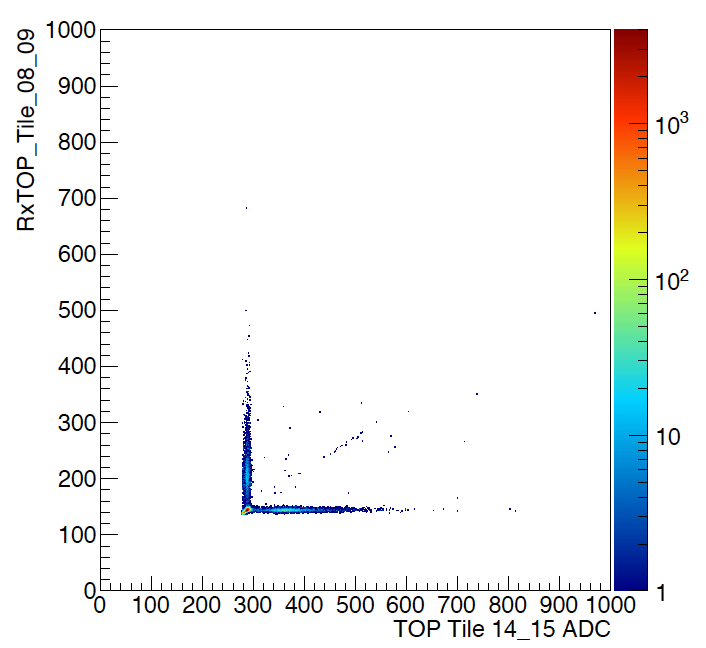
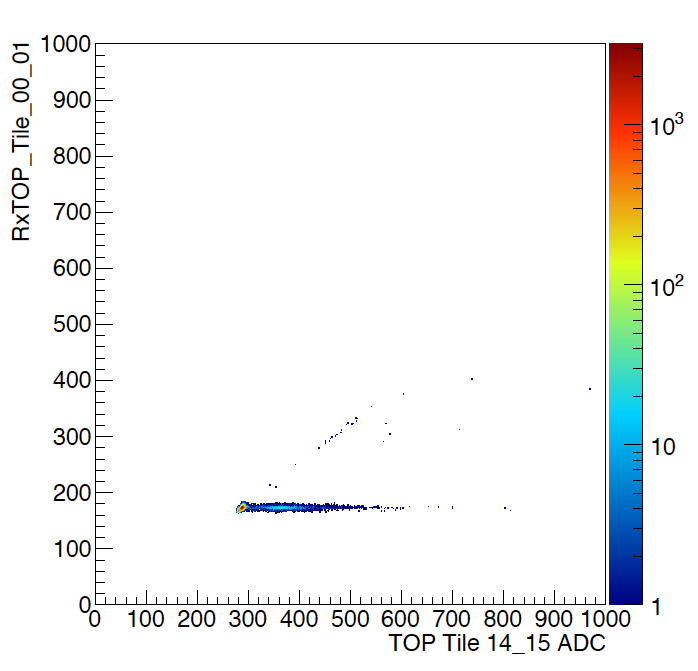
Figure 1: Example correlation between two tiles on the left, example correlation between a tile and the empty tile at tile "zero".
In Figure 1, we can see an example of this. As expected, one can see that pedestal and mip peak for each tile, completely uncorrelated with the signal in the other, except for the points along the diagonal. In fact, this was even seen in the first channel when running on evens (which we have called tile 0). Since there is no tile, or fiber, there is no way for there to be a signal.
The entire set of correlations can be seen at: drupal.star.bnl.gov/STAR/system/files/Histos12142017_EPD_Diagonal.pdf
It should be noted here that the last 4 tiles of the bottom SS were removed from the ADC in slot 7 to the empty ADC (given the labels blank0, etc). In fact, if we select events in which tile 0 in the top supersector had a significantly higher than pedestal value (adc > 250), we see that we can pull this diagonal correlation from all channels, other than those from the "empty" ADC: drupal.star.bnl.gov/STAR/system/files/Histos12142017_EPD_Diagonal_SelectedonTile0.pdf
What was noticed is that the last ADC, which had been empty, did not show this characteristic diagonal correlation. This is true even with the data being added to it. (We noted that the empty channels in the previously full ADC do show it, but none of the channels on the empty one showed it either before or after putting the data into the system). One difference was the timing, the first 4 ADCs were 28 ns behind. Another was that the logic feeding these ADCs, it looked sort of like the 4-fold coincidence was a 3-fold (at least it was firing more often than the other, and we could not put the level any higher in coincidence), so we moved this cables into a more stable one and verified that both sets now fired precisely the same. We also removed the 28 ns of extra cable, so everything was a the same timing.
After doing this, the diagonal correlation seems to go away:

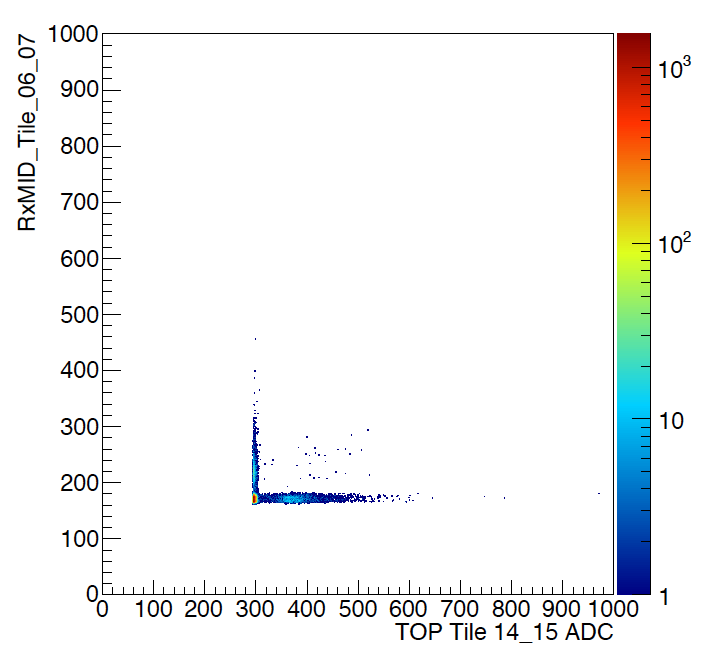
Figure 2: Two correlations after our fix which do not seem to show the diagonal line.
In Figure 2, we do not see any evidence of this correlation. On the left is the correlation between tile 14 on the top and in the middle, so the correlation in the middle is from true cosmic rays. On the right is the correlation between tile 14 on the top and tile 6 in the middle. One can see the pedestal and MIP peaks for both, which are mostly uncorrelated as expected. (The few points in the middle could be from diagonal cosmics.)
The full range of correlations from these channels can be seen at: drupal.star.bnl.gov/STAR/system/files/Histos12152017_EPD_NoDiagonalProblem.pdf
First Autumn 2017 cosmic tests at STAR
After Thanksgiving, we have placed a stack of threePhase 1 - Nov-Dec 2017
For "phase 1" of these tests, we are reading out with a CAMAC-based DAQ system which was developed largely by Wanbing He and Xinyue Ju.
Here are some photos of the first day of "phase 1".
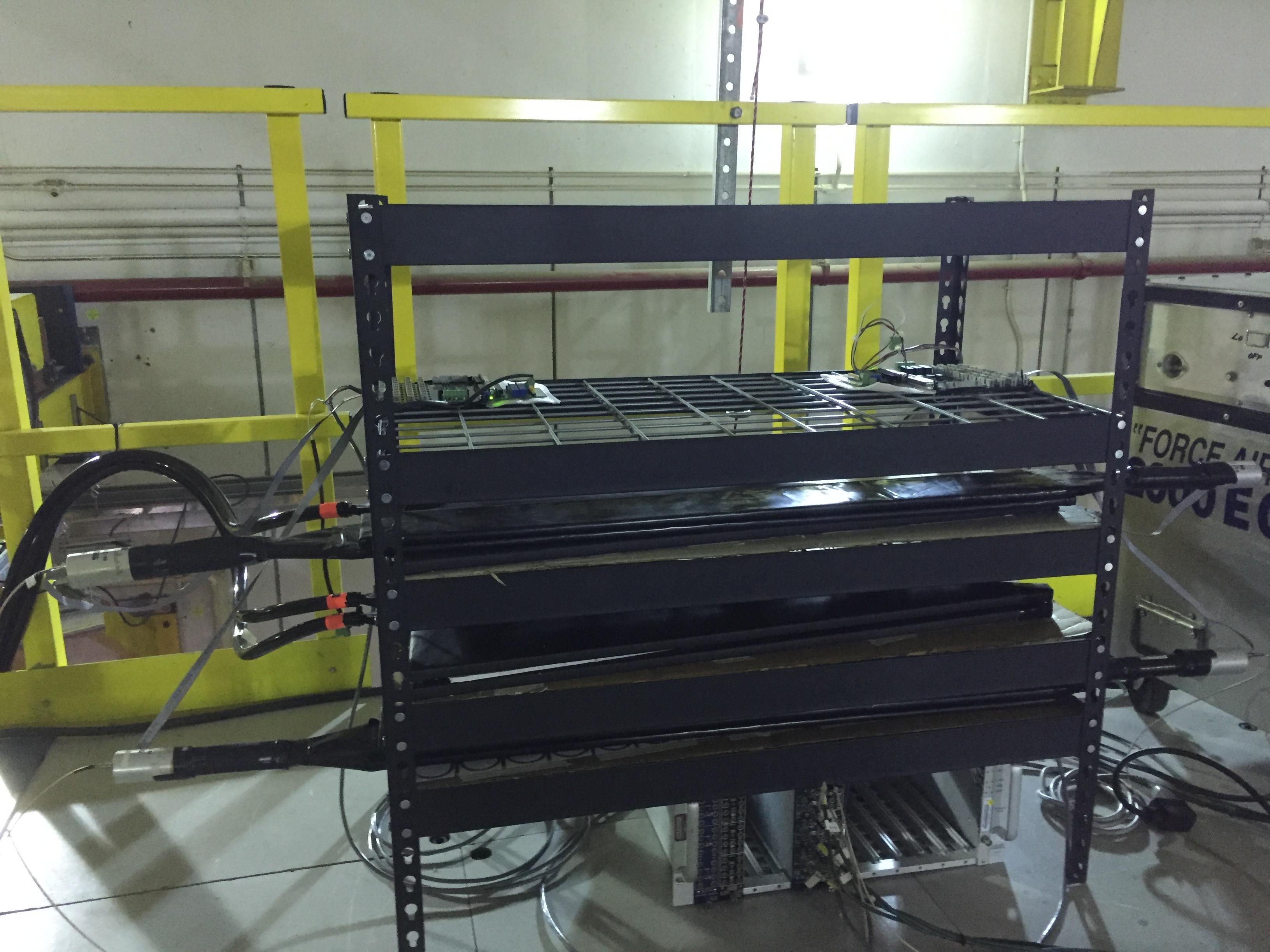
The set-up on the SE side of the upper platform of STAR. Three SS
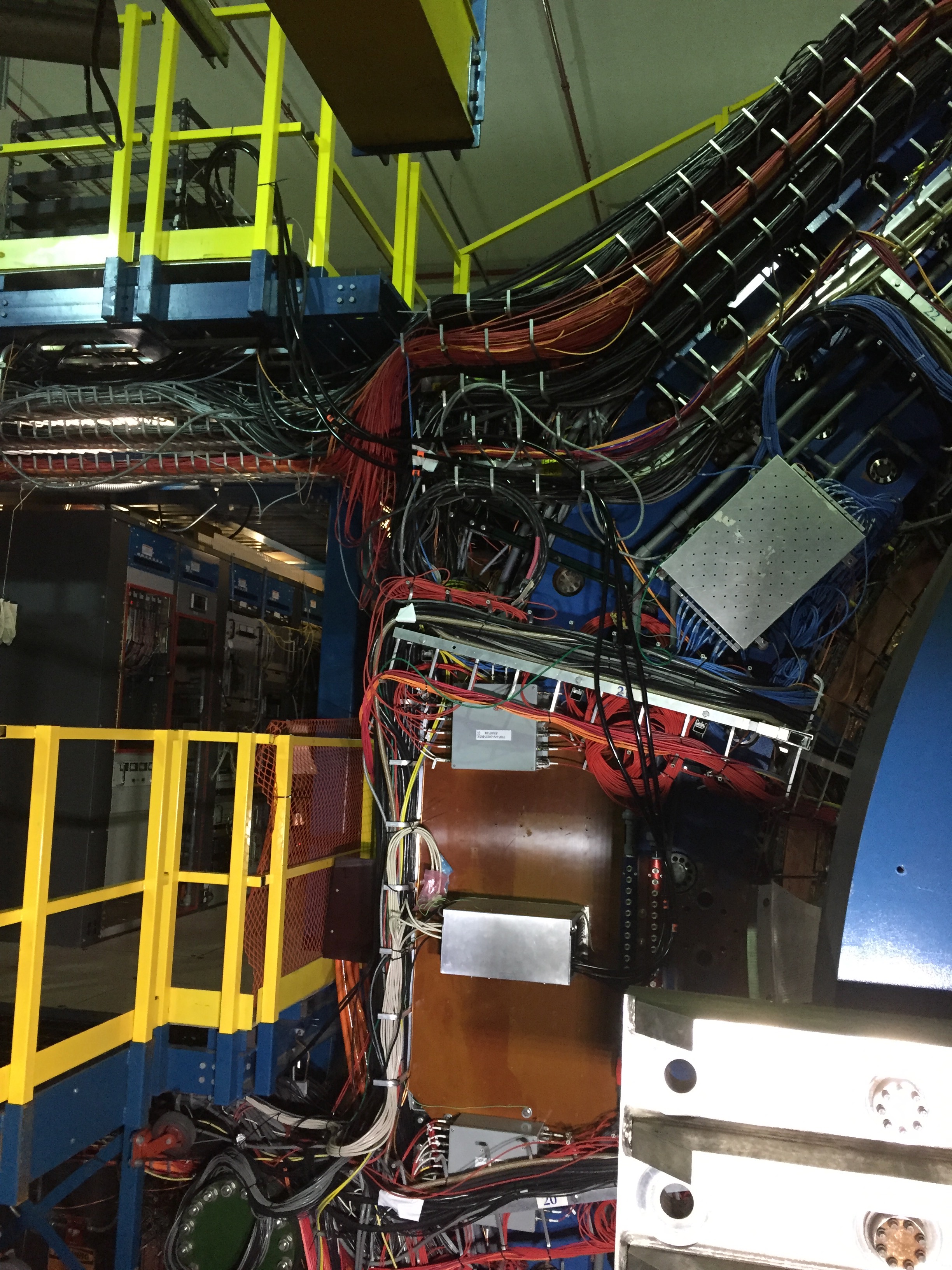
The SS

The populated FEE box with 6 FEEs. We managed to make it look relatively neat, but assembling a full box will require a couple of hours of very careful work. We have put advice in the log book for the future.
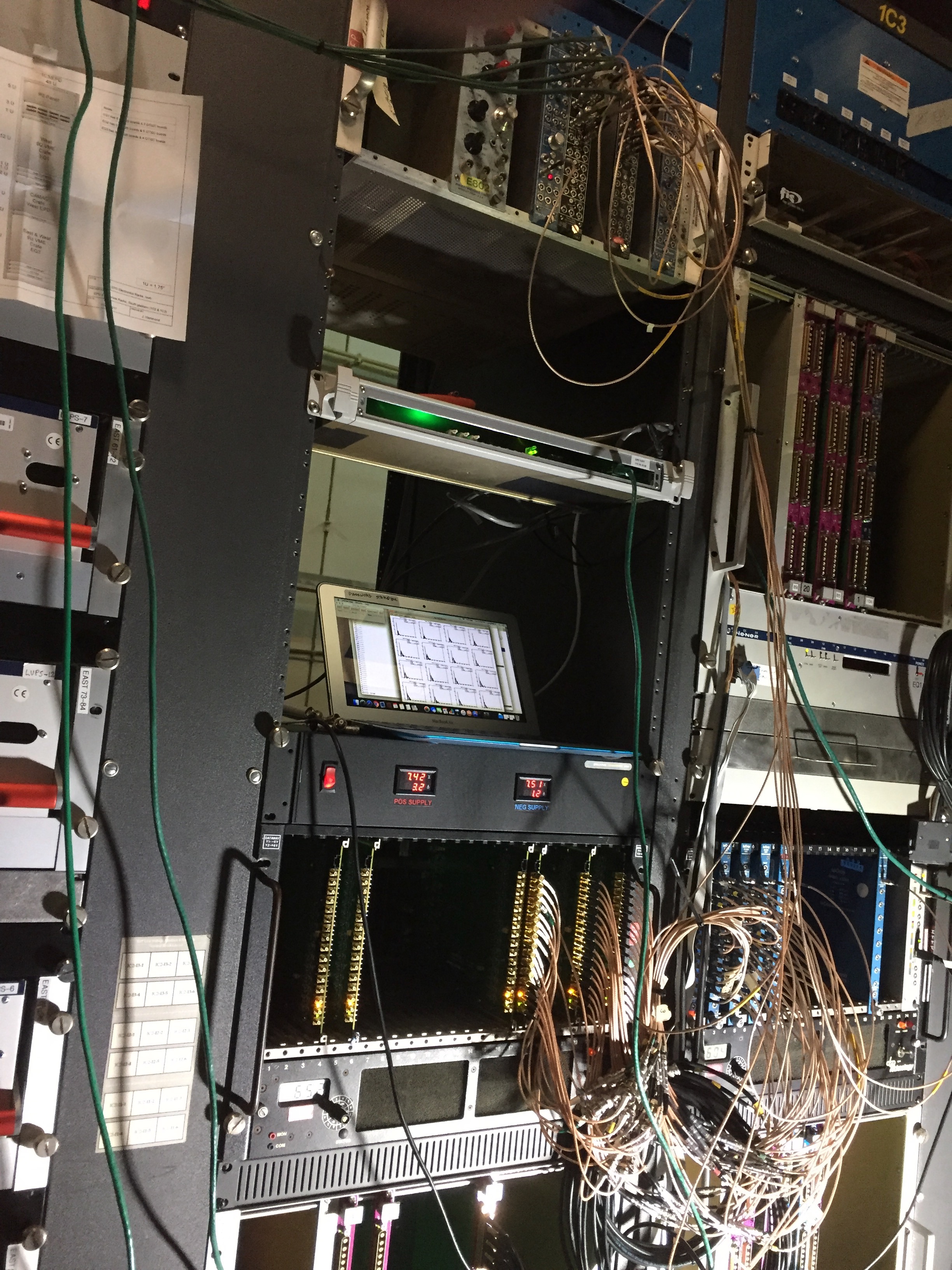
Not a great photo of our set-up in the 1C1 and 1C2 racks on the platform. Left rack (1C1) from top down: simple trigger electronics in
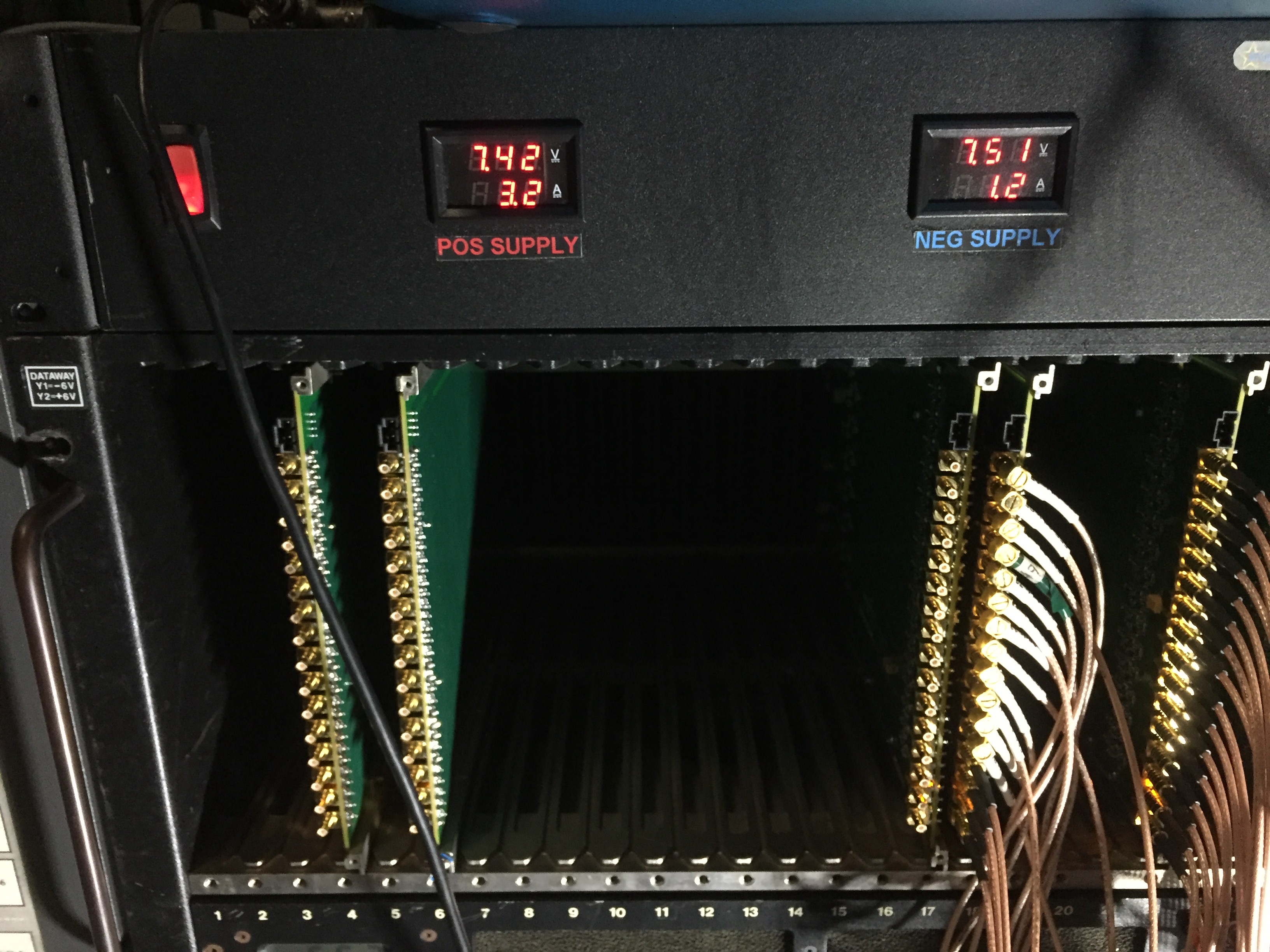
The new TUFF PS is much nicer on the back, and on the front panel, voltage and current for the positive and negative supplies are indicated.
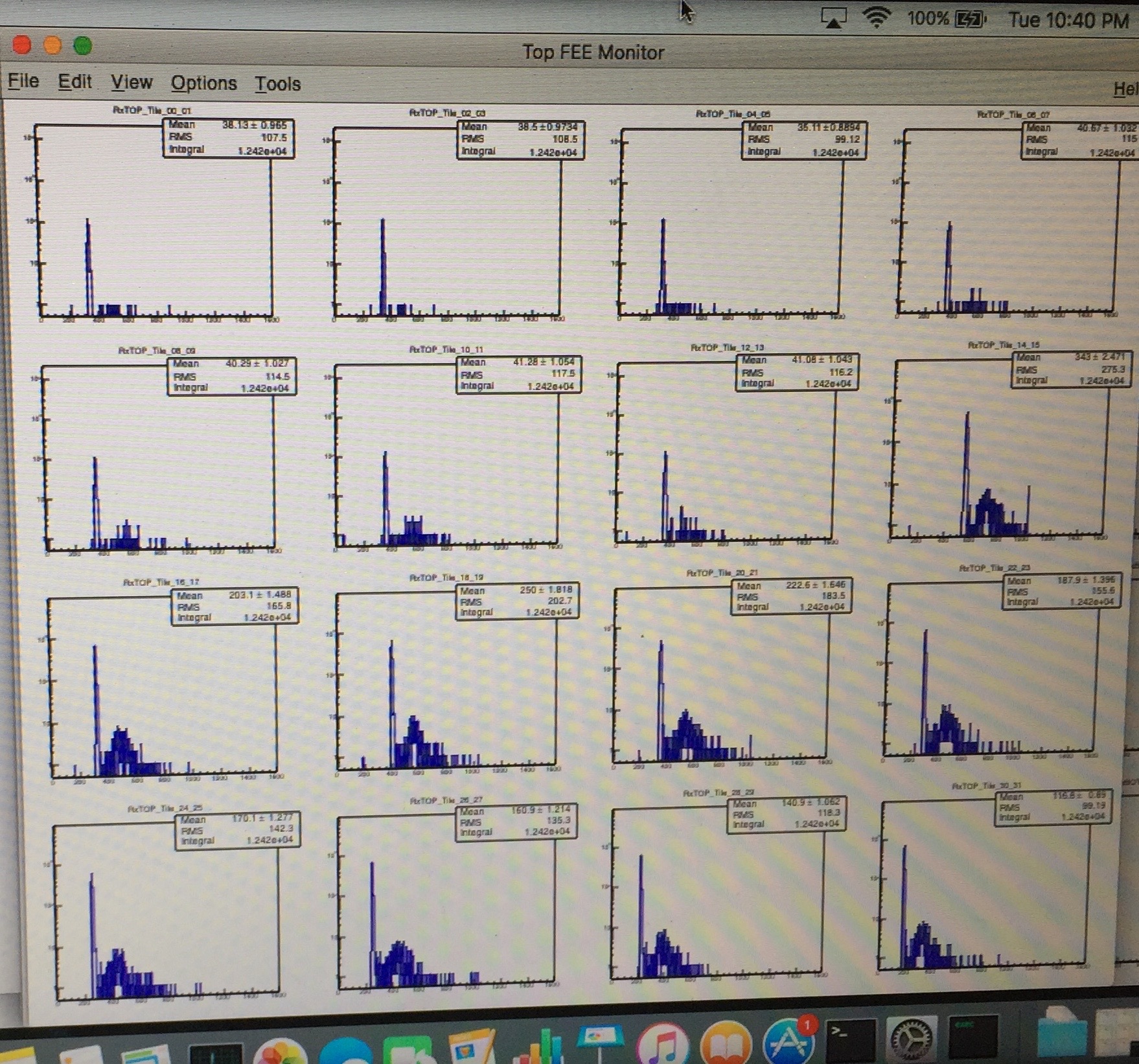
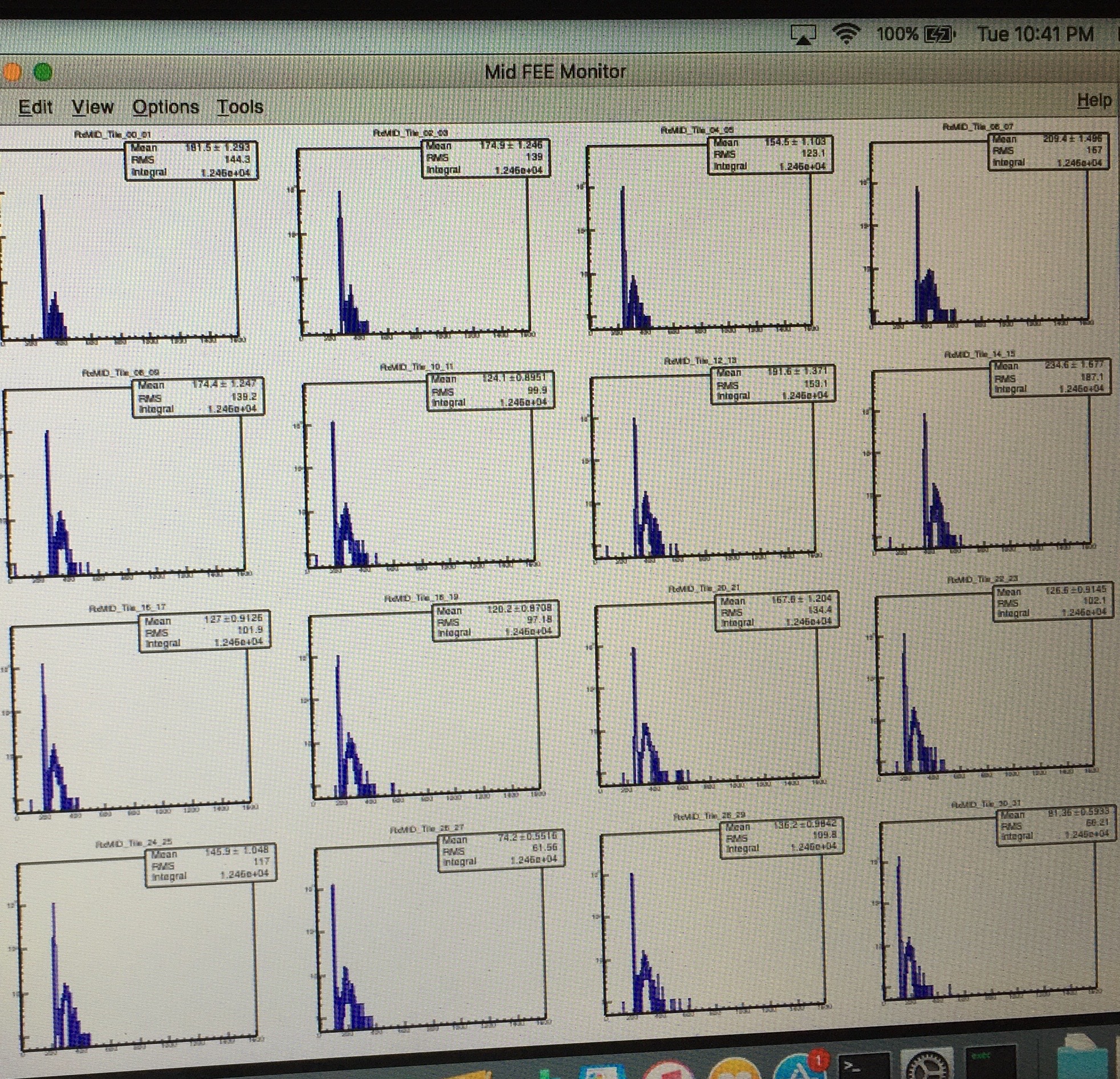
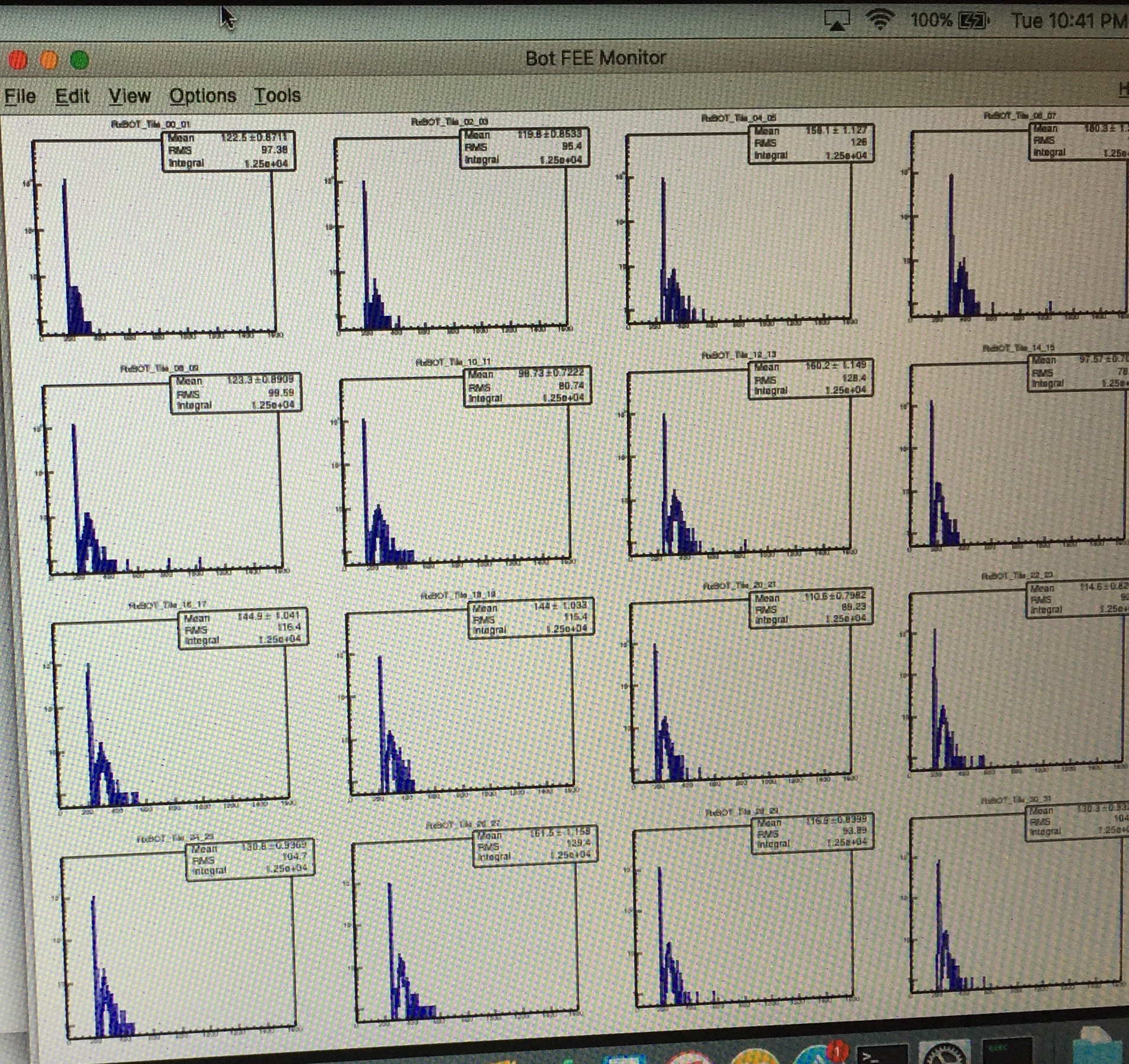
First MIP peaks from one hour of running. Top, middle and bottom Supersector signals are shown, for odd-numbered tiles. Small tiles in top SS don't show good peaks, probably due to trigger timing issues which we are looking into.
Update 2 Dec 2017
First production data using the trigger PMTs has been taken and is being analyzed by
Joey/Te-Chuan, please update with your stuff here.
First results of ADCs from vertical cosmic rays:
- Landau fits: https://drupal.star.bnl.gov/STAR/system/files/ADC_SS252723_odd.pdf
-
Update 5 Dec 2017
It was noted by Te-Chuan that the ADC distribution for TOP Tile 15 goes all the way to 1024 (hence saturates at the high end). The pedestal was close to 500 counts, which is quite high. (One sees this also in the photos of the spectra above.) It turns out that our high pedestals are due to the overly wide gate I had set. As seen in the photo below, we see that we sit very nicely in the gate, but the gate itself is about 275 ns (compare to ~80 ns that we use in STAR). The pedestal one expects is
pedestal = (baseline voltage) * (gate width) / [(input impedance) *(ADC conversion factor)
= (baseline voltage) * (275 ns) / [(50 ohm)*(0.25 pC/count)
= (baseline voltage) * (22 count/mV)
This should be added to the "typical residual pedestal" of the 2249A (see here) quoted as
1 + [(0.03 pC)/(0.25 pC/ct)*(t in ns) = 34 counts for our gate
The baseline voltages coming out of the Rx cards are of order 10 mV, so we expect pedestals of about 250 counts. I know these "typical residual pedestals" can vary significantly, so 350 counts is not crazy. 500 counts is still a bit high, but I am not shocked, since baseline voltage will vary, too.
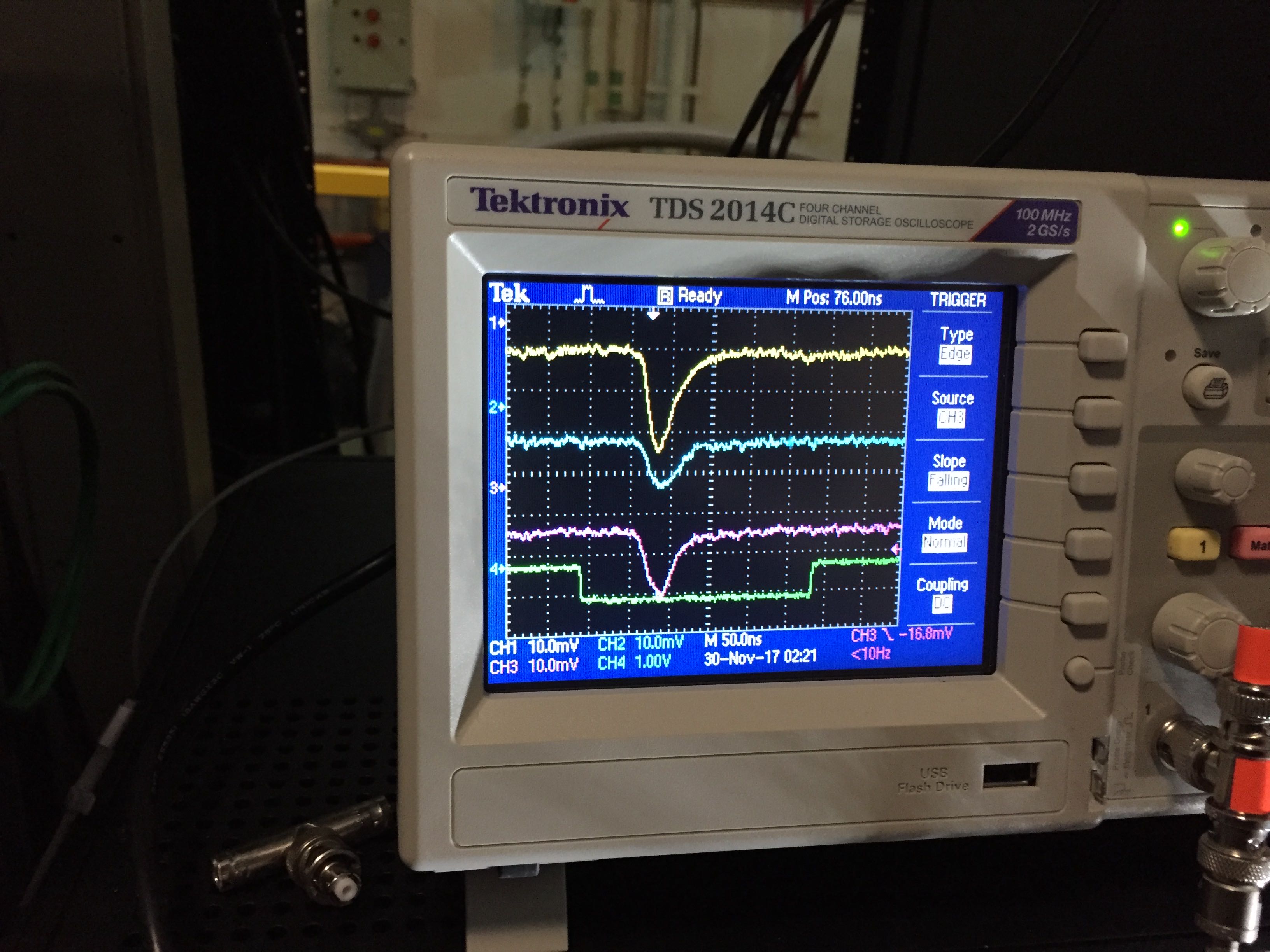
Output of the Rx cards for the same tile-number from the three stacked supersectors fall well within the gate. They have baseline offsets of about 10 mV. The gate is overly wide, about 275 ns.
Calibrations
This will be a page that aggregates information for calibrating the EPD.
Welcome to the EPD calibration page. From here, you can:
- Find a calibration status for any year and run
- Learn how to calibrate the EPD
- Get current software to calibrate the EPD and display EPD issues
Sections generally provide links to more detailed information.
---------------------------------------------------------------------------------------------
Calibration Status
Done:
| production_3p85GeV_fixedTarget_2019 | 3 | 2019 | FXT | 5 | https://drupal.star.bnl.gov/STAR/blog/eloyd/EPD-Calibration-Run-19-385GeV-FXT-dataset |
1. Generate picos
|
|
| production_4p59GeV_fixedTarget_2019 | 3.2 | 2019 | FXT | 5 | 2. Fit all days | ||
| production_7.3GeV_fixedTarget_2019 | 3.9 | 2019 | FXT | 5 | https://drupal.star.bnl.gov/STAR/blog/cracz/run-19-epd-calibrations-73-gev-fxt |
3. Troubleshoot problem tiles
|
|
| production_31GeV_fixedTarget_2019 | 7.7 | 2019 | FXT | 5 | https://drupal.star.bnl.gov/STAR/blog/eloyd/EPD-Calibration-Run-19-31GeV-FXT-dataset |
4. Enter values into database
|
|
| production_7p7GeV_2019 | 7.7 | 2019 | COL | 5 | |||
| production_14p5GeV_2019 | 14.5 | 2019 | COL | 5 | |||
| production_19GeV_2019 | 19 | 2019 | COL | 5 | |||
| production_AuAu200_2019 | 200 | 2019 | COL | 1 | |||
| production_5p75GeV_fixedTarget_2020 | 3.5 | 2020 | FXT | 5 | |||
| production_7p3GeV_fixedTarget_2020 | 3.9 | 2020 | FXT | 5 | |||
| production_9p8GeV_fixedTarget_2020 | 4.5 | 2020 | FXT | 5 | |||
| production_13p5GeV_fixedTarget_2020 | 5.2 | 2020 | FXT | 5 | https://drupal.star.bnl.gov/STAR/blog/eloyd/EPD-Calibration-Run-20-13p5GeV-FXT-dataset | ||
| production_19p5GeV_fixedTarget_2020 | 6.2 | 2020 | FXT | 5 | https://drupal.star.bnl.gov/STAR/blog/eloyd/EPD-Calibration-Run-20-19p5GeV-FXT-dataset | ||
| production_26p5GeV_fixedTarget_2020 | 7.2 | 2020 | FXT | 5 | https://drupal.star.bnl.gov/STAR/blog/eloyd/EPD-Calibration-Run-20-26p5GeV-FXT-dataset | ||
| production_31p2GeV_fixedTarget_2020 | 7.7 | 2020 | FXT | 5 | |||
| production_11p5GeV_2020 | 11.5 | 2020 | COL | 5 | https://drupal.star.bnl.gov/STAR/blog/dchen/EPD-Calibration-Run20-11p5-GeV-AuAu | ||
| 2021 "live calibration" | 2021 | 4 | |||||
| 2022 "calibration" | 2022 | 2 | |||||
| production_26p5GeV_fixedTarget_2020 | 7.2 | 2020 | 1 |
This is the current and past calibration status for the various runs in STAR. All runs will also show whether they are complete, in progress, or not yet started.
Run 22 Calibration Status
- Status: in progress
- Most of the data are calibrated
- Notes - EPD Calibration meeting - Google
Run 21 Calibration Status
- Status: Done ("Live Calibration")
Run 20 calibrations:
- Status: in progress
- 7.7 GeV FXT and 9.2 GeV COL complete
- 3.5 (5.75) GeV FXT, 3.9 (7.3) GeV FXT, 4.5 (9.8) GeV FXT, 11.5 GeV COL calibration complete.
Run 19 calibrations:
- Status: in progress
- drupal.star.bnl.gov/STAR/blog/skk317/epd-calibration-run-19
- 19.6 GeV COL, 14.5 GeV COL, 7.7 GeV COL, and 4.59 GeV FXT complete
- All FXT runs currently in progress
Run 18 calibrations:
---------------------------------------------------------------------------------------------
Calibration Process
The basics of calibration can be found here:
https://drupal.star.bnl.gov/STAR/blog/skk317/epd-calibration-isobar-final
Erik's slides on the process of calibration:
https://drupal.star.bnl.gov/STAR/blog/eloyd/EPD-Calibration-Procedure
There will be some updates to this based on more recent code, but this will get you started. Up to date code can be found here:
https://github.com/cdxing/EpdCalibration
https://colab.research.google.com/drive/1a_GEeXxQRDjgFs1E1CUSNY-vjRJYTAKM?usp=sharing
EPD Meetings
EPD Meetings
Thursdays 08:30 (BNL time)
Meeting Zoom
https://lehigh.zoom.us/j/93334661391?pwd=b1hpY3lPK3hPM0tCM2d0YUZOYk96UT09
Meeting 27 October 2021 (830 am EST)
- Run 22 EPD install
- Operations Run 22
- Calibration progress
- 19.6 GeV production issues?
-
AOB
- EPD Small Systems - Jordan Cory - drupal.star.bnl.gov/STAR/system/files/Cory%20EPD%20Meeting%208-12.pdf
- Calibrations
- AOB
Meeting 1 July 2021 (830 am EST)
- EPD Removal Plan
- Calibrations
- AOB
Meeting 3 June 2021 (830 am EST)
- EPD Current Status
- Calibrations
- AOB
Meeting 13 May 2021 (830 am EST)
- EPD EQ3 Issues and OO Running - drupal.star.bnl.gov/STAR/system/files/RReedEPD05132021.pdf
- EPD EP Resolution
- Calibrations
- AOB
Meeting 6 May 2021 (830 am EST)
- dN/dphi - Xiaoyu - drupal.star.bnl.gov/STAR/system/files/EPD05062021.pdf
- Run 21 Calibrations
- Run 21 OO Running
- AOB
Meeting 11 March 2021 (830 am EST)
- Beamline Offset - Xiaoyu
- Run 21 -
- AOB
- Simulation - Mate
- Run 21 -
- AOB
Meeting 24 FEB 2021 (830 am EST)
- Run 21 issues
- Calibrations
- Beamline offsets, etc
- AOB
Meeting 11 FEB 2021 (830 am EST)
- Calibrations
- Beamline offsets, etc
- Run 21
- Simulations
- AOB
Meeting 14 Jan 2021 (830 am EST)
- FCS Splitter? (5 ns vs 2 ns?)
- Calibrations
- Run 21 - drupal.star.bnl.gov/STAR/blog/rjreed/epd-install-calibration-and-commissioning-run-21
- Calibrations - www.star.bnl.gov/~mcsanad/epd/dNdEta_summary_2021jan14.pdf
- AOB
Meeting 3 Dec 2020 (830 am EST)
- Calibrations
- Run 21
- To-dos - Bad channels/boards? Calibrations during Run?
- AOB
Meeting 12 Nov 2020 (830 am EST)
- Calibrations
- Centrality at 7.7 GeV
- Run 21
- Signals to FCS DEP -> Which FEE?
- AOB
Meeting 1 Oct 2020 (830 am EST)
- EPD removal
- Calibrations
- Run 21
- AOB
- Calibrations
- Conclusion of Run 20
- Run 21
- Rosi - Some 7.7 GeV fun drupal.star.bnl.gov/STAR/system/files/RReed09172020.pdf
Meeting 30 July 2020 (830 am EST)
- Mate - Extracting dNch/deta - drupal.star.bnl.gov/STAR/blog/mcsanad/extracting-dnchdeta-epd-data
- Skipper - calibration status
Meeting 25 June 2020 (830 am EST)
- Rosi - Pedestal and Vped issues - drupal.star.bnl.gov/STAR/blog/rjreed/epd-pedestal-issue-access
- Ding - v1 at 7.2 GeV FXT - drupal.star.bnl.gov/STAR/system/files/psi_1_EPD_and_v1_eta_in_FXT_Au_Au_collision_7.2%20GeV.pdf
- Cameron - 9.2 GeV calibration issues - drupal.star.bnl.gov/STAR/system/files/CameronRacz_CalibIssues.pdf
- Skipper 14.5 GeV calibration - drupal.star.bnl.gov/STAR/system/files/EPD_14p5_Calibration_06_24_2020.pdf
Meeting 11 June 2020 (830 am EST)
- EPD LV power supply turn on procedure: https://drupal.star.bnl.gov/STAR/system/files/EPD_Turn_ON_PS.pdf
Meeting 28 May 2020 (830 am EST)
Meeting 21 May 2020 (830 am EST)
- Mate/Roland – simulation and unfolding status
- Skipper/Ding – calibration summary - drupal.star.bnl.gov/STAR/system/files/Kagamaster_EPD_14p5_Calibration_05_21_2020.pdf
- Xiaoyu – extracting v1 from nMIP distributions
- Prashanth/Akio - EPD mapping simulation - www.star.bnl.gov/protected/spin/akio/fcs/epd/
- AOB
Meeting 8 May 2020 (830 am EST)
- Skipper - Centrality measures in the BES with the EPD
- Roland/Mate - simulation/unfolding status
- Skipper/Ding - calibration
Meeting 24 April 2020 (830 am EST)
- Roland/Mate - rolandpinter.web.elte.hu/EPD%20meeting/EPDmeeting_2020apr24.pptx
- Skipper/Xiaoyu/Ding - calibration status/documentation
- Mike dN/deta - drupal.star.bnl.gov/STAR/system/files/EpdMeeting24April2020_0.pdf
Meeting 17 April 2020 (830 am EST)
- Roland/Mate – simulation- drupal.star.bnl.gov/STAR/system/files/EPDmeeting_2020apr17_0.pdf
- Skipper/Ding – calibration/database:
- Joey – Y-repair -
- Xiaoyu - QA
Meeting 10 April 2020 (830 am EST)
- Potential RHIC re-start 2020 – Rosi & Mike
- Simulation status – Roland
- Calibration – Skipper & Ding (if any report)
- Repair of the Y-piece – Joey
- dN/deta status (if time) – Mike
Meeting 3 April 2020 (830 am EST)
- Simulation Status - Roland, Mate
- Calibrations and database - Skipper and team
- fixing Y splitters (anything left to discuss?) - Joey
Meeting 3 April 2020 (830 am EST)
- Fixing Y-splitters - All -
- Simulation Status - Roland -
- Calibration - Ding - drupal.star.bnl.gov/STAR/system/files/dchen_EPD_7p7_calibration.pdf
- Calibration - Skipper - drupal.star.bnl.gov/STAR/system/files/Kagamaster_EPD_14p5_Calibration%20Issues.pdf
- Fast Simulator - Mike
Meeting 20 March 2020 (830 am BNL time)
- Simulation status - Roland
- Calibration status - Skipper and Ding
- Repair of Y - Joey
- Potential RHIC restart - all
- dN/deta status (if time) - Mike
Meeting 20 March 2020 (830 am EST)
- Simulation Status - Roland - drupal.star.bnl.gov/STAR/system/files/epdmeeting_2020_03_20.pdf
- Calibration - Skipper - https://drupal.star.bnl.gov/STAR/system/files/Kagamaster_EPD_14p5_Calibration%20%281%29.pdf
- Fast Simulator - Mike - drupal.star.bnl.gov/STAR/blog/lisa/epd-meeting-20-march-2020-epd-fast-simulator
Meeting 19 April 2019
- QT32B algorithms - what to expect, based on bench tests
- effect of QT32B algorithms running now in STAR - Skipper
- Calibration status (including FXT) - Skipper - https://drupal.star.bnl.gov/ST
AR/system/files/Kagamaster_EPD Meeting_04192019.pdf - Simulations status - Roland, Prashanth
- EPD paper - www.overleaf.com/17484095yjvtdpwmnzbp
- Skipper - 2018 gain calibrations
- Cat -EPD-BBC correlations - https://drupal.star.bnl.gov/ST
AR/system/files/EpdBbcCorrel_ AntiCorrel_2.pdf - Rosi & Joey - run status
Meeting 15 March 2019
- Roland - EPD simulation, status, questions - https://www.star.bnl.gov/~rolandp/EPD_SIMULATION/EPDSimStatQuestions.pdf
- Skipper - 2018 gain calibrations
- Cat -EPD-BBC correlations
- Rosi & Joey - run status
Meeting 22 February 2019
- Cat - EPD-BBC correlations
- Skipper - 2018 gain calibrations
- All - commissioning with beam
- Run 20 EPD Tasks still to go
Meeting 8 February 2019
- Skipper Calibrations - drupal.star.bnl.gov/STAR/system/files/EPD_02_08_2019_Kagamaster.pdf
- Preparations 2019 - drupal.star.bnl.gov/STAR/subsys/epd/operations-2019/post-installati on-pre-beam-commissioning-2019
- Is 3:30 on Mondays still okay?
- Calibrations and database - what is done, what is not? - Skipper, Prashanth
- Upcoming EPD activities
- Thurs, 24 Jan
- Install TUFF & PS - Mike (unless Tim has already done so)
- Install FEEs on SW FEE box - Mike, Joey, Xiaoyu
- Ready a staging area - Lehigh crew
- Friday, 25 Jan
- Mount EPD (& BBC?) - team
- dark current / light-tight
- Saturday 26 Jan
- let us discuss today
- 28 January - 1 February - Joey (& Justin?)
- ....
- Thurs, 24 Jan
- What do we need to be doing now, before arriving at BNL?
- Commissioning documentation - (click here to see 2018 documentation)
- Do we need to add slewing?
- EPD Users Guide and shift crew instruction - Justin & Joey - current documentation here
- There is a note at the bottom regarding "1-wire scan" that the EPD crew is looking into something....?
- EPD GUI readiness for this weekend
Meeting 12 November 2018
- Rosi- Triggering with the EPD - drupal.star.bnl.gov/STAR/system/files/RReedEPD11122018.pdf
- Backup Information: Blog - drupal.star.bnl.gov/STAR/blog/rjreed/analysis-27-gev-data-triggering-correct-version and Isobar Resolution Study: drupal.star.bnl.gov/STAR/blog/rjreed/epd-vertex-resolution and BES presentation: drupal.star.bnl.gov/STAR/system/files/RReedBES10302018.pdf
- Start of slew correction write-up: drupal.star.bnl.gov/STAR/blog/rjreed/slew-corrections-epd
Meeting 15 October 2018
- George - Machine Learning and the EPD - drupal.star.bnl.gov/STAR/system/files/GeorgeHalal101518EPDMeeting.pdf
- George - Machine Learning and the EPD - drupal.star.bnl.gov/STAR/system/files/GeorgeHalal100118EPDMeeting.pdf
Meeting 13 August 2018
- Skipper - Calibration for isobars - Completed
- Joey - Twisting effect of B-field drupal.star.bnl.gov/STAR/blog/adams92/twisting-effect-b-field-star
Meeting 6 August 2018
- Skipper - Calibration for isobars and AuAu drupal.star.bnl.gov/STAR/system/files/EPD_Meeting_Kagamaster_8_6_2018.pdf
- Prashanth - progress and status of simulation STAR/system/files/userfiles/3254/GSTAR08062018.pdf
- Joey - twisting effect of B-field. drupal.star.bnl.gov/STAR/blog/adams92/twisting-effect-b-field-star
- For reference: Xinyue's simulation-based study from summer 2017: drupal.star.bnl.gov/STAR/subsys/epd/individuals-pages/xinyue-ju
Meeting 30 July 2018
- Skipper - Calibration status: drupal.star.bnl.gov/STAR/system/files/Kagamaster_7_30_2018.pdf
Meeting 2 July 2018
- Rosi - STAR Collaboration meeting
- Rosi - Trigger requirements 2019
- Prashanth et al - Status of the GEANT
- AOB
Meeting 25 June 2018
- Shinichi - Ring-weight optimization and ring-by-ring correlation studies: drupal.star.bnl.gov/STAR/system/files/epd-cen-ep-2018Jun22.pdf
- Xiaoyu - Ring-by-ring correlation studies - drupal.star.bnl.gov/STAR/system/files/Event_plane_correlation%20.pdf
- Roland - study of primary and secondary particle production and energy loss in EPD: drupal.star.bnl.gov/STAR/blog/rolandp/analysing-particles-hitting-epd-focusing-separation-primary-secondary-particles
- Calibration plans - Mike and Skipper
- Gene Van Buren plans on physics-quality production of isobar data in mid-July
- Storage of EPD and inventory of equipment - Mike
- AOB
- Status at BNL / Shutdown plans - Justin/Prashanth/Mike/Xiaoyu
- the run is over
- final IV scan taken and EPD biases off
- BBC is being taken down
- EPD storage structure is being mounted right now
- East EPD will come down probably today
- West EPD begins tomorrow afternoon
- need to inventory
- Roland - drupal.star.bnl.gov/STAR/blog/rolandp/particles-epd-hit-analysis
- EPD/BBC correlations - Xiaoyu/Mike
- Software status (results from S&C meeting) - Prashanth - postponed until next week
- Plans moving forward - all
- calibrations - Skipper/Prashanth/Mike
- storage of EPD - Mike
- NIM paper pre-plans and Lehigh meeting
- should we continue with weekly meetings?
- AOB
Meeting 4 June 2018
- drupal.star.bnl.gov/STAR/blog/lisa/ep-resolution-and-eta-dependence-directed-flow-auau-collisions
- drupal.star.bnl.gov/STAR/blog/lisa/phi-weighting-and-optimizing-ring-weights-auau-27-gev
- drupal.star.bnl.gov/STAR/blog/lisa/subtle-flow-and-anti-flow-patterns-visible-epd-auau-27-gev
- drupal.star.bnl.gov/STAR/blog/lisa/v1-analysis-charged-particles-auau-27-gev
- https://drupal.star.bnl.gov/STAR/blog/rolandp/epd-vertex-analysis-x-y-plain-different-z-cut-selections-3-different-zooms-x-y-plain
Meeting 28 May 2018
First half
- Status at BNL
- AUM posters
Meeting 23 May 2018
First half
- Status at BNL
- Some of Mike's posts since our last meeting (we don't have to go through these):
- EP resolution
- Looks good in isobar run drupal.star.bnl.gov/STAR/blog/lisa/ep-resolution-epd-and-bbc
- Looks bad in Au+Au drupal.star.bnl.gov/STAR/blog/lisa/first-look-ep-resolution-27-gev-auau
- Uniformity/nonuniformity, ring by ring: drupal.star.bnl.gov/STAR/blog/lisa/uniformity-and-nonuniformity-ring-ring
- "back scatter" from BBC? Material on East side?
- Hits seen in EPD when BBC tiles see nothing
- Is there a large "BBC inefficiency?" Au+Au looks quite similar to isobar data
- Isobar data: drupal.star.bnl.gov/STAR/blog/lisa/epd-hit-positions-when-bbc-tile-sees-nothing
- Au+Au data: drupal.star.bnl.gov/STAR/blog/lisa/epd-hits-when-bbc-tiles-see-nothing-auau-case
- The EPD signal is well inside the gate in the Au+Au run: drupal.star.bnl.gov/STAR/blog/lisa/gate-timing-2018-auau-27-gev-run
- Any "apparent" differences are due to the higher flux in the isobar data, as discussed here: drupal.star.bnl.gov/STAR/blog/lisa/comparing-adc-distributions-isobar-and-auau-data-2018-run
- EP resolution
Meeting 7 May 2018
First half
- Status at BNL
- 27 GeV running
- Landau Fluctuations
- Simulation update - Mate
Meeting 23 April 2018
First half
- Status at BNL - Joey
- shut-down plan
- FXT running - Rosi
- Vertex Resolution - Rosi
- Simulation status - Prashanth
- QM posters - status and plans: Joey, Justin, Isaac
Meeting 16 April 2018
First half
- Status at BNL - Joey
- any issues on the newly-swapped in daughter cards?
- A study of "ring weights" to optimize sensitivity to the event plane. -Mike Link - drupal.star.bnl.gov/STAR/blog/lisa/optimizing-ring-weights-find-2nd-order-event-plane
- analysis of BBC and EPD in isobar data - Joey
- regarding EPD and BBC event plane resolutions - Mike - drupal.star.bnl.gov/STAR/blog/lisa/bbc-performing-better-epd
- GSTAR progress - Prashanth
Meeting 9 April 2018
First half
- Status at BNL - Robert, Joey, Justin, Prashanth
- Shall we swap in the repaired daughter cards? When?
- Steve's email here
- Discussion on changing Vbias
- Mike's discussion of adding Landau fluctuations (and also on what "having no mean" means)
- Rosi's discussion of adding Landau fluctuations, along similar lines. Also, her updated centrality study where she artificially reduces the range of the ADC
- First analysis of Fast Offline picoDsts and first estimate of event plane resolution for the 200 GeV isobars - link here
- Analysis software - Mike
- All is complete! MuDst, picoDst, Utilities. All is committed, installed, works very well :-)
- 250k events in under two minutes (not trivial "read-and-plot"!)
- Geant/GSTAR progress - Prashanth www.star.bnl.gov/protected/bulkcorr/prashanth/EPD/geant/PrashanthS_04082018.pdf
Meeting 2 April 2018
First half
- Status at BNL - Justin, Prashanth
- Ongoing QTC problems and how to address them. Register read-back, swap, remap, etc. - all
- Offline software - Mike
- EPD in picoDsts - Jerome has not found time to move on this
- All else is completed
Meeting 19 March 2018
First half
- Status at BNL - Joey
- QT32C Issues - Rosi, Justin, Gerard, Stephen
- 4 QT32C channels that have some out-of-time contribution for all ADC values
- QT32C channels that have this behavior where the average ADC changes
- (Are the shift crew catching these and starting and stopping the runs?)
- drupal.star.bnl.gov/STAR/system/files/RReedEPD03192018.pdf
- drupal.star.bnl.gov/STAR/blog/jewigleb/list-epd-runs-and-boards-issues
- Online plots discussion - Changes? Updates? Additions?
- Triggering
- Rosi's Presentation to the Triggerboard: drupal.star.bnl.gov/STAR/system/files/RReedEPDTriggerboard03192018.pdf
- Prashanth's blog: drupal.star.bnl.gov/STAR/subsys/epd/operations-2018/trigger-commissioning
- EPD group duties
- Online monitoring
- Shiftlog
- On call experts
- Some results of epc, bbc, tof comparisons, plus spectra from all channels, etc:
Meeting 12 March 2018
First half
- Status at BNL - Rosi
- QT 32B Replacement - Joey
- Connector issue - Joey
- Mapping/Scans/Etc - Rosi
- Trigger Group
- Bit Timing?
- TAC distributions
- Zero Suppression?
First half
- Status at BNL - Joey
- Latest Seven-Patterns map test - Mike
- procedure: drupal.star.bnl.gov/STAR/blog/lisa/how-check-mapping-vped-patterns-step-step
- result - mapping is correct: drupal.star.bnl.gov/STAR/blog/lisa/epd-mapping-correct-4-march-2018
- EPD-BBC correlations in pre-beam 2018 cosmics - Mike
- Database update - Prashanth
- Trigger group needs? - Rosi
- We need to wrap up the "swapping" if possible.
- Shift crew guide - Joey and Justin
- All:
- Readiness update (beam could come this week!)
- Vbias scan / gain-matching ready? (Mike)
- Gate timing scan ready? (Mike)
- what else?
- Schedules: who will be at BNL, when?
- Readiness update (beam could come this week!)
- Neural network progress - George Halal
- Presentation: drupal.star.bnl.gov/STAR/system/files/EPDMeeting_030518_GeorgeHalal.pdf
- Additional plots can be found at: drupal.star.bnl.gov/STAR/blog/rjreed/machine-learning-epd-centrality
- analysis software update - more progress - Mike
- EPD fully into StEvent, in dev - done last week
- StEpdUtil committed and in dev - done last week
- StEpdHitMaker committed and in dev - done last week
- new: EPD is now officially in STAR muDst (thanks Daniel B!)
- new: EPD and BBC geometry and mapping classes in StRoot/StEpdUtil
- decided: stay with StTriggerData::bbcXXX methods in muDst; no new classes
- upcoming: discussing EPD and BBC in picoDst. Expect progress this week.
First half
- New meeting time 11:00 okay?
- News from Ops meeting
- Vped-based mapping from "TUFF space" to "StEvent space" - Prashanth/Rosi/Mike
- current status - problems with PP09TT01 on both East and West - drupal.star.bnl.gov/STAR/blog/lisa/seven-pattern-mapping-verification-problems-pp09ss01
- Mapping fixes summary: drupal.star.bnl.gov/STAR/subsys/epd/operations-2018/mapping
- Vped adjustment - Rosi - drupal.star.bnl.gov/STAR/blog/rjreed/vped-scan-2018-setting-nominal-values
- First cosmic check! - Rosi - drupal.star.bnl.gov/STAR/system/files/CosmicAdc_small_Day056.pdf
- analysis software status - progress! - Mike
- EPD fully into StEvent, in dev
- StEpdUtil committed and in dev
- StEpdHitMaker committed and in dev
- code for EPD in muDst in hands of Daniel B. He will commit "soon" (today?)
- picoDst is next
- implement same for BBC??
- epd-specific triggers and streams in current run - Rosi
Meeting 19 February 2018
First half
- Status at BNL - Prashanth/Joey/Justin
- A fun way to test a serious issue - verifying the map from "TUFF space" to StEvent - Rosi and Mike
- See Mike's blog page: drupal.star.bnl.gov/STAR/blog/lisa/checking-mapping-all-way-tuff-box-stevent-and-mudst
- Plans for this week - drupal.star.bnl.gov/STAR/system/files/12feb2018schedule.pdf
- continued map verification - Rosi/Mike/Joey/folks at BNL
- Vped adjusting
- I-V scans
- shift user's manual (just to keep it on the radar) - Joey/Justin
- Cosmic triggers for this week - Rosi
- TOF-EPD cosmic trigger?
- TOF-BBC cosmic trigger?
- Run readiness - first day commissioning
- have "timing scan" macros ready! - Mike
- have "bias scan" macros ready! - Mike
- other?
- analysis software status (StEpdHitMaker, StEpdHitUtil, StEvent, muDst, picoDst) - Mike
- works well (see item above!). Review and commit process has stalled. Situation will soon become critical.
- simulation software status - Prashanth
Meeting 12 February 2018
First half
- Status at BNL - Prashanth/Joey/Rosi
- Database/GUI/etc coordination - status and what remains to be done?
- Mapping: are we robust against future mistakes?
- Light leak testing status
- Source testing results
- BBC installation schedule
- Cabling schedule
- Pre-beam commissioning schedule - Rosi, Mike, all
- An incomplete straw-man: drupal.star.bnl.gov/STAR/blog/lisa/epd-schedule
- analysis software status (StEvent, muDst, picoDst) - Mike
- simulation software status - Prashanth
- operations/calibration/access to data during isobar run - Mike
Meeting 5 February 2018
First half
- status at BNL
- fibers attached, FEE boxes assembled, Rx-to-QT started
- EQ1 needs replaced (Steve does it today)
- cannot take data now, probably due to EQ1 problem
- verified that setting Vbias and Vped (to several values) affect output at Rx cards as expected.
- mapping issues. code needs to know what TUFF/Branch/FEE/channel corresponds to what side/Position/Tile.
- Plans for this week:
- fix mapping / database
- light-leak hunt
- source test with Bill Christie (place source and look for Idark increase) - this tests the map of "channels, etc" to PHYSICAL SPACE
- verify that setting Vbias on individual tiles increases Idark on those channels (tests consistency of control and monitor maps)
- individually increase Vped for a tile, take PedAsPhys run, and run data through BFC to make uDSTs. (Tests mapping all the way from tile electronics to analyzer representation (StMuEpdHit)
- mount BBC
- perhaps... record some normal-incidence cosmic scope traces. Probably do NOT play with BBC, as per advice of Les Bland.
- Then
- pre-beam commissioning
Meeting 29 January 2018
First half
- status at BNL - the EPD is installed - Prashanth and Mike
- work to do this and next week. Preparing for pre-beam commissioning - all
- connect SiPMs to FBs (East side)
- string and connect FB (East side)
- TUFF-to-FEE connection. Terminal block and harnesses. Tim will do this Monday.
- FB-FEE connection
- get slow controls/monitor system up and running - Tonko can do this once #3 is done. He will do by (on?) Thursday.
- At this point, can begin light-tight testing (through dark currents)
- MDR cables to FEEs and RxBs
- At this point, can look at/for signals from tiles (large-angle cosmics etc)
- cable RxBs to QTs
- At this point, can begin pre-beam commissioning
- Set Vped values
- begin mapping verification through PedAsPhys runs
- I-V scan
Meeting 15 January 2018
First half
- Assembly work plan for 19-23 January - Rosi, Mike, Gerard, all
- Online controls/monitor - Prashanth
- Pre- and post-beam commissioning 2018 - Rosi, Mike
- Status of EPD integration into StRoot - Mike
- Status of EPD integration into GSTAR - Prashanth
- First use of neural networks in EPD for centrality determination - Isaac
Meeting 8 January 2018
First half
- status report from BNL and January plans
- January plans and installation schedule - Mike, Robert
- status of QT-based DAQ for cosmic tests - Rosi (will send an update)
- final determination of supersector health - Mike
- status of online controls/monitoring, if any - Prashanth
- Inclusion of EPD into StEvent and muDsts - Mike
- Inclusion of EPD into picoDsts - Yang
- EPD in GSTAR - Prashanth
Meeting 18 December 2017
First half
- report from BNL
- Test fit using strongback mock-up - Mike/Rosi/Robert
- results of cosmic testing and SS health - Mike - drupal.star.bnl.gov/STAR/subsys/epd/useful-epd-documents/hardware-documents/supersector-and-tile-healthstatus
- status of transitioning to QT-based DAQ - Rosi
- Joey - frequently-postponed cross-talk presentation
- Mike - upcoming installation schedule - drupal.star.bnl.gov/STAR/system/files/EPDsched_v2.pdf
- Software status. GEANT, StEpd - Prashanth
Meeting 4 December 2017
First half
- Joey/Te-Chuan/Rosi/Mike: first results of cosmic tests at BNL
- Photos of set-up by Mike: drupal.star.bnl.gov/STAR/subsys/epd/2017-cosmic-ray-tests-osu-and-bnl/first-autumn-2017-cosmic-tests-star
- Vertical cosmic analysis by Te-Chuan: drupal.star.bnl.gov/STAR/subsys/epd/individuals-pages/te-chuan-huang/first-results-autumn-2017-cosmic-tests-star
- Joey's presentation: drupal.star.bnl.gov/STAR/system/files/Cosmic%20Ray%20Testing%20at%20BNL.pdf
- Joey: cross-talk measurements with reflective paint over entire scintillator face: drupal.star.bnl.gov/STAR/system/files/Cross-Talk%20Reduction%20with%20Reflective%20Paint.pdf
- Rosi/Mike: plans for phases 2 and 3 cosmic test
- Justin: "worst fiber" results for the fiber bundle tests (as opposed to averages) drupal.star.bnl.gov/STAR/system/files/FiberBundle12042017.pdf
- Robert/Mike/Rosi/Joey - need for West side test installation in mid-December, and potential problems
- Prashanth: Geant implementation of EPD (drupal.star.bnl.gov/STAR/system/files/EPD_Geant_thick_part_only.png)
- Isaac/Daniel - neural net centrality and EP studies
Meeting 20 November 2017
First half
- Justin - Fiber bundle progress
- All - Any last minute thoughts for next week's testing?
- Prashanth - Geant for EPD
Meeting 13 November 2017
First half
- Justin - Clear Fiber Bundle Status Spreadsheet - https://docs.google.com/spreadsheets/d/1u5dWDUeguvjiPTBiH32b--NCzr-gS7l-ocCTeo5hBF0/edit?usp=sharing
- Prashanth - Geant for EPD http://www.star.bnl.gov/protected/bulkcorr/prashanth/EPD/vsp_gstar_111017.pdf
- Rosi - Centrality Dependence by Energy drupal.star.bnl.gov/STAR/system/files/RReedEPD11132017.pdf
Meeting 23 October 2017
First half
Second half
- Mike - Fit Method revisited drupal.star.bnl.gov/STAR/system/files/23Oct2017.pdf
- Yang - v2 in 54 GeV Au+Au - drupal.star.bnl.gov/STAR/system/files/yang_epd_v2_update2.pdf
Meeting 16 October 2017
First half
- Wanbing He - Preliminary ideas for monitoring/slow-control page.
- Prashanth - implementing the database
- Mike - Calibrating the data for Au+Au 54 GeV - 93 down, 651 to go!
- Mike - Using CALIBRATED picoDsts and a first analysis on them. StEpd and first (flawed) results.
Meeting 09 October 2017
First half
- Mike
- status at BNL
- upcoming activities including proposed cosmic tests at BNL: drupal.star.bnl.gov/STAR/system/files/Pre-run%20cosmic%20tests.pdf
- November Analysis meeting plans
- Prashanth/Wanbing/Te-Chuan - initial plans for Slow Controls & monitoring interface
- Prashanth - database status (& corrections)
- Xinyue - analysis of Au+Au 54 GeV
Meeting 02 October 2017
First half
- Mike - First half of EPD arrives at BNL, and health report: drupal.star.bnl.gov/STAR/system/files/HealthReport02oct2017.pdf
- Joey - production crosstalk testing.
- Justin - brief update of status of clear fiber bundle production at Lehigh
Meeting 25 September 2017
First half
- Wanbing He: - fine-grained heat maps using source and x-y table:
- Te-Chuan Huang - vertical cosmic tests
- Mike Lisa - plans for bringing detector and people to BNL next week
Meeting 18 September 2017
First half
- Wanbing He - heat maps using source and x-y table
- 2 cm x 2 cm scan of SS06 - drupal.star.bnl.gov/STAR/system/files/heatMap.pdf
- presentation: drupal.star.bnl.gov/STAR/system/files/EPD_currentTest_0918wanbing.pptx
- Te-Chuan Huang - vertical cosmic tests
Meeting 11 September 2017
First half
- Justin & Rosi - status of fiber bundles; personpower issues
- Last WSL will be done today/tomorrow
- CL: All tubing prepped, all connectors prepped, cutting fibers + gluing will commence
- At BNL -> Hanseul + Yang have volunteered
- At Lehigh -> Possibility of some Russian collaborators
- Isaac - status of SS production
- Supersector tests
- Rosi - analysis of cosmic test data
- Presentation at: drupal.star.bnl.gov/STAR/system/files/RReedEPD09112017.pdf
- Blog with all the gory details: drupal.star.bnl.gov/STAR/blog/rjreed/cosmic-ray-data-configurations-12-and-3
- Tile by tile comparison: drupal.star.bnl.gov/STAR/system/files/ZeroAdcAll.pdf
- Wanbing - source scan analysis - drupal.star.bnl.gov/STAR/system/files/EPD_currentTest_0911_wb.pptx.pdf
- Rosi - analysis of cosmic test data
- Robert - anything to report on the support structure?
- Robert and ALL - upcoming activities at RHIC - FEE box, cosmic testing, storage, November analysis meeting (EPD in-person meeting)
- see the latest shutdown schedule here. EPD FEE box installation is scheduled for mid-November. EPD installation & commissioning scheduled for late January
- Further discussion on Rosi's UrQMD-based centrality study?
- What can we show at the November analysis meeting?
- AuAu 54 GeV?
- Cosmic data
- Simulations --> UrQMD + GEANT4!
11 September 2017 - Labor day in U.S. - Meeting cancelled
Meeting 28 August 2017
First half
- First coarse heat map of SS06. - Mike. blog at https://drupal.star.bnl.gov/STAR/blog/lisa/first-heat-map-ss06
- UrQMD simulation - Centrality and Effiency - Rosi: drupal.star.bnl.gov/STAR/system/files/RReedEPD08252017.pdf
- Note: I ran out of time a bit, I will write a more detailed blog, etc. Sorry for the mess!
First half
- Analysis of cosmics in OSU test stand - Rosi
Meeting 14 August 2017
First half
- Analysis of cosmics in OSU test stand - Rosi
- Plans for heat map of supersector - Mike - drupal.star.bnl.gov/STAR/blog/lisa/making-heat-map-position-dependent-response-epd-supersector
- QT needs and mapping for Run 2018+ - Rosi
- dense-packing scheme - drupal.star.bnl.gov/STAR/system/files/2018qtMap.pdf
- Cable-length considerations for Rx-to-QT (if needed) - Prashanth
- Status of production at Lehigh and OSU. SS / WLS / Clear
- Optical Grease Test - Justin - https://drupal.star.bnl.gov/STAR/system/files/EPD%20Meeting%208-14-17.pdf
- Using StEpd on STAR picoDSTs - Mike
- first look at v1 with EPD - Yang - drupal.star.bnl.gov/STAR/system/files/54GeV_ZDC-SMD_v1Eta_with_EPD_Update3.pdf
- Pico's are at: /star/data06/EPD/ywu27/pico/picoDSTs/
Meeting 31 July 2017
- Fiber tests - Justin: https://drupal.star.bnl.gov/STAR/system/files/EPD%20Meeting%207-31-17.pdf
Meeting 24 July 2017
- Clear Fiber tests: George: drupal.star.bnl.gov/STAR/system/files/GeorgeHalalPolishingEffects07-20-17.pdf
- First cosmic tests -- SS05 drupal.star.bnl.gov/STAR/system/files/FirstCosmics.pdf
Meeting 17 July 2017
- Status of simulations: https://www.dropbox.com/s/
73ddkbhnmvpnpc1/vsp_gstar_ 071717.pdf?dl=0 - Clear fiber testing: https://drupal.star.bnl.gov/STAR/system/files/LED_Test_Box%20_7-17-2017.pdf
- Pictures of FFC Connectors from 4 bundles: https://drupal.star.bnl.gov/STAR/system/files/4%20Clear%20Fiber%20Connectors%207-13-2017%20George%20Halal.pdf
Meeting 10 July 2017
- EPD dismount and storage report
2nd half of meeting:
- Kazuya - event-plane studies - https://drupal.star.bnl.gov/STAR/system/files/0711_nakagawa_epdmeeting.pdf
- All - generating a request for a "small" production of 54 GeV data
Meeting 3 July 2017
Hanseul: dN/deta toy model: drupal.star.bnl.gov/STAR/system/files/3Jul17_EPD_dNdeta.pdf
Meeting 26 June 2017
Mike: How to extract pseudorapidity distributions from high-multiplicity data.
(We do not have to discuss this in excruciating detail...)
drupal.star.bnl.gov/STAR/blog/lisa/measuring-pseudorapidity-distribution-epd
Rosi: Questions -> Where are we going to store the quarter wheel? How is the EPD being transported to BNL? EPD storage cart?
George Halal: Initial studies of offline EPD trigger
drupal.star.bnl.gov/STAR/system/files/EPD%20Meeting6-26-17George%20Halal.pdf
Meeting 19 June 2017
Rosi: drupal.star.bnl.gov/STAR/system/files/RReedEPD06192017.pdf
More complete analysis, including PDFs of all 93 channels and their associated ADC, TDC and TAC values can be found at: drupal.star.bnl.gov/STAR/blog/rjreed/auau-54-gev-triggers-and-eval-part-1
For those who may be interested in vertexing, multiplicity in the 54 GeV data, look at (not to be discussed): drupal.star.bnl.gov/STAR/blog/rjreed/auau-53-gev-evaluating-performance
Mike: In Au+Au collisions at 54 GeV (much higher than the multiplicities that drove the design of the EPD), we expect very significant multi-hit events on the tiles. In fact, this analysis based on central Au+Au collisions at 62.4 GeV published by PHOBOS, indicated that the average hit multiplicity on a tile would be greater than 1.
And indeed, this is what we see, as shown on the following page:
drupal.star.bnl.gov/STAR/blog/lisa/multi-mip-events-2017-epd-auau-54-gev
Most particles are not coming from single-hit events. So, we will need to be careful not to show "real quick dN/deta distributions," as they will be way off.
Justin:
Fiber polishing and bundle creation at Lehigh
drupal.star.bnl.gov/STAR/system/files/Fibers%2C%20EPD%20Meeting%206-19-17.pdf
drupal.star.bnl.gov/STAR/system/files/SS%25231_Fibers%281%29.pdf
Sam:
Simulation update
drupal.star.bnl.gov/STAR/system/files/sim_EPD_update06192017.pdf
Meeting 5 June 2017
1) Mike: TDCvsTAC
It turns out that all QT channels have a TDC in addition to the ADC they put out. Supposedly it is a 5-bit TDC, but Hank reports that he's only seen 4 bits fire (returned value 0..15). I have verified this in the EPD QTB boards, and find that the TDC is linearly proportional to the TAC, in the one QTB board that has a TAC. You may find the picture here:
drupal.star.bnl.gov/STAR/system/files/TDCvsTAC.png
This could be useful in data analysis, for ALL channels (even the QT32Bs that will not have TAC, which is 75% of the EPD channels in 2018+). I expect (though it has not been tested) that we can require TDC not equal zero, and be looking at in-time hits..
The TDC information is now included in the StEpdTile data object.
The following plots are ADC distributions, where the blue curves correspond to TDC!=0 and the red curves are for TDC=0.
drupal.star.bnl.gov/STAR/system/files/ValidTDCstudy.pdf
The TDC would seem to be an excellent way to discriminate noise/out-of-time signals from real particles. Much more convenient than an ADC threshold..... Except for a couple of bins, where the behaviour is precisely opposite to that expected. This needs to be investigated.
More detail: drupal.star.bnl.gov/STAR/system/files/TDCstudy.pdf
2) Polishing at Lehigh:
drupal.star.bnl.gov/STAR/system/files/FiberPolishing06052017.pdf
drupal.star.bnl.gov/STAR/system/files/FiberPolishing06052017_pics.pdf
Meeting on 5/22/2017
1) Prashanth: Short update/summary of the situation with the QTs and new FEEs
www.star.bnl.gov/protected/bulkcorr/prashanth/EPD/weeklymeetings/PrashanthS_05222017.pdf
www.star.bnl.gov/protected/bulkcorr/prashanth/EPD/weeklymeetings/PrashanthS_05222017.pdf
Meeting on 5/16/2017 - at BNL during STAR Collaboration Meeting
Tuesday evening at 6:30 with pizza
Current run
- Prashanth - 2017 operations- Prashanth_CollMeeting_05162017.pdf
- *brief* review of various scans, gain-matching, etc
- dark current drupal.star.bnl.gov/STAR/system/files/RosiReedDarkCurrent05152017.pdf
- Rosi - trigger update
- QT32c status
- DSM bit-checking
- drupal.star.bnl.gov/STAR/system/files/RReedEPD_05160217_STARmeeting.pdf
- Joey - supersector construction status - drupal.star.bnl.gov/STAR/system/files/JoeyEPDStatus.pdf
- Justin/Rosi - fiber testing & bundle production schedule drupal.star.bnl.gov/STAR/system/files/JustinFiber.pdf
- Robert - mechanical support status drupal.star.bnl.gov/STAR/system/files/PakBNL2017v2b.pdf
- Prashanth - online & (mostly) offline software status
- Sam - EPD simulations drupal.star.bnl.gov/STAR/system/files/Heppelmann_geant_update.pdf
- XX - analysis plots
- all - plans for remainder of 2017 run
- toward a "standard set of procedures" for operations 2018+
- AOB
Meeting on 5/08/2017
1) Rosi - BBC-EPD correlations: drupal.star.bnl.gov/STAR/system/files/RReedEPDBBCCorr05092017.pdf
BBC - EPD timing studies: drupal.star.bnl.gov/STAR/blog/rjreed/epd-timing-correletion-slew-correction-vs-bbc-ii
Trigger, etc.
2) Justin - Fiber polishing and testing at Lehigh:
On the hardware page under "Useful EPD Documents": drupal.star.bnl.gov/STAR/system/files/Justin%20Polishing%20Testing.pdf
Also at: http://www.star.bnl.gov/protected/bulkcorr/prashanth/EPD/Polishing_Testing_Justin_05082017.pdf
Meeting on 5/01/2017
1) Rosi - EPD-BBC timing studies & QT32C spikes - drupal.star.bnl.gov/STAR/blog/rjreed/epd-timing-correletion-slew-correction-vs-bbc
2) Prashanth - status at STAR
Also, discriminator study: drupal.star.bnl.gov/STAR/subsys/epd/operations-2017/discriminator-threshold-scan
3) Rosi - status of trigger coordination, including trigger bit test, etc.
4) Gerard - status/plans for FEE upgrade drupal.star.bnl.gov/STAR/system/files/gain_change_update.pdf
5) Mike - status/plans of EPD construction at OSU
6) Mike - ADC spectra with TAC cut - drupal.star.bnl.gov/STAR/system/files/ADCfitsTACcut_Lisa28apr2017.pdf
7) All - availability for in-person EPD session at STAR Collaboration Meeting
8) All - Plans for the coming week
Meeting on 4/24/2017
1) Rosi's blog:
drupal.star.bnl.gov/STAR/blog/rjreed/epd-analysis-32b-vs-32c-timing-correlations-etc
One important point: best START for QT32Bs is -8 and best START for QT32Cs is -20
www.dropbox.com/s/rbgzbbuhqfev1kr/BBCEPDCorr.pdf
3) Mike timing
www.dropbox.com/s/bn5wpxxj8gmm2qv/Timing.pdf
EPD To-Dos:
1) Confirm 32C settings - Change Tier 1 file!
2) Threshold Scan (32B first, then 32C once the above is accomplished)
3) DSM Bit checking
4) Software in CVS?
Meeting on 4/17/2017
1) Prashanth (software)
Mike's StEpd analysis software: /star/u/lisa/StEpd/
Database related
https://drupal.star.bnl.gov/STAR/blog/sprastar/epd-offline-db-table
https://online.star.bnl.gov/dbExplorer/
Meeting on 4/10/2017
1) Status of QT32Cs - Prashanth, Rosi, Gerard, Hank(?)
2) Bias scan - Mike
drupal.star.bnl.gov/STAR/subsys/epd/operations-2017/bias-scan
Meeting on 4/03/2017
0) Status - Prashanth, all
1) Prepost 32c vs 32b
2) Gate scan + conclusions
drupal.star.bnl.gov/STAR/system/files/GateScan_1.pdf
Summary:
- QT32B likes START=-8 (as we concluded before)
- QT32C likes START=-20
- we see the "left edge" of the drop-off reasonably well
- Gate scan concluded
4) Bias Scan - Rosi has produced files for analysis; Mike has not yet analyzed them.
5) Gerard, all: interpretation of QT32C messages
6) Dark current:
- Mike - How much dark current is too much? drupal.star.bnl.gov/STAR/system/files/DarkCurrentCalculations.pdf
- Rosi
- Dark Current: Zoomed out: drupal.star.bnl.gov/STAR/system/files/h_DarkCurrent_Nhours920.pdf
- Zoomed in to 1 uA front page: drupal.star.bnl.gov/STAR/system/files/DarkCurrent_Nhours920.2017Mar26_115604_zoom.png
- Full pdf zoomed into 1 uA: drupal.star.bnl.gov/STAR/system/files/h_DarkCurrent_Nhours920_zoom_1uA.pdf
7) Rosi - IV scan histograms: drupal.star.bnl.gov/STAR/system/files/IvscanHistos_03_26_2017.pdf
7.5) Sam - First steps with GEANT4 EPD: drupal.star.bnl.gov/STAR/system/files/EPD_geantSTARSIM_0.pdf
8) (If time) - Rosi: First steps with UrQMD: drupal.star.bnl.gov/STAR/system/files/RReedEPD03272017.pdf
8.5) Rosi: Starting to look at BES data (7.7 GeV): drupal.star.bnl.gov/STAR/system/files/RReedEPD04032017.pdf
9) Tasks for the coming week.
- From last week: 1,2 are done; 3 is canceled; 4 is done but not analyzed. 5....?
- New tasks
Meeting on 3/27/2017
1) Prashanth, all:
- Current problems - CAMAC PS?
- Plans for access
- do not swap QT32C inputs with QT32B for now (see "steps for this week" below)
2) Mike - Gate scan study
- Where all files including these studies sit. drupal.star.bnl.gov/STAR/subsys/epd/operations-2017/timing
- Gate scan over full range [-16,+48]: drupal.star.bnl.gov/STAR/system/files/GateScan_FullRange_0.pdf
- Gate scan over [-16,+16] and plateau identification for QT32Bs drupal.star.bnl.gov/STAR/system/files/GateScan_0.pdf
- Same study but with a focus on the QT32Cs: drupal.star.bnl.gov/STAR/system/files/GateScan.pdf
3) All: Next steps for this week
- get trigger guys to put us in PrePost=0
- continue gate scan to "more negative" values to find QT32C plateau and final gate delay value
- swap inputs of QT32C with a QT32B to check gain (why this is not already known from the lab...??)
- Bias scan
- step size, range
- what is figure of merit? "MIP position matching"? Separation from dark current?
- operationally - take-a-run, burn-a-run while switching, take-a-run...?
- TAC ajustment - will need Jack's help (Gerard will be at BNL?)
4) Dark current:
- Mike - How much dark current is too much? drupal.star.bnl.gov/STAR/system/files/DarkCurrentCalculations.pdf
- Rosi
- Dark Current: Zoomed out: drupal.star.bnl.gov/STAR/system/files/h_DarkCurrent_Nhours920.pdf
- Zoomed in to 1 uA front page: drupal.star.bnl.gov/STAR/system/files/DarkCurrent_Nhours920.2017Mar26_115604_zoom.png
- Full pdf zoomed into 1 uA: drupal.star.bnl.gov/STAR/system/files/h_DarkCurrent_Nhours920_zoom_1uA.pdf
5) Rosi - IV scan histograms: drupal.star.bnl.gov/STAR/system/files/IvscanHistos_03_26_2017.pdf
6) Joey - BBC-EPD correlations - drupal.star.bnl.gov/STAR/system/files/EPD%20Presentation.pdf
7) (If time) - Rosi: First steps with UrQMD: drupal.star.bnl.gov/STAR/system/files/RReedEPD03272017.pdf
Meeting on 3/20/2017
1) Mike: PrePost study of runs 1806643, 18076064 and 18076065:
drupal.star.bnl.gov/STAR/system/files/Study18066043and18076064and18076065all.pdf
(This study under the Operations 2017 child page)
2) Mike: Draft (v1) of trigger documents shared with trigger group and to be discussed 21march2017:
drupal.star.bnl.gov/STAR/system/files/EPD%20Trigger%20Requirements%20v1.pdf
3) Mike: First Gate Scan study. This will need to be revised, as discussed on first page of this document.
drupal.star.bnl.gov/STAR/system/files/GateScan_PrePostIndex2.pdf
(This study under the Operations 2017 child page)
Meeting on 3/13/2017
1) Mike: TAC-selected spectra from run 18067001: drupal.star.bnl.gov/STAR/system/files/Run18067001_spectra.pdf
Also, drupal.star.bnl.gov/STAR/system/files/FitValidTACadcSpectrum.pdf
Meeting on 3/6/2017
1) Mike: Spectra Fits from vbias 56.5V data: drupal.star.bnl.gov/STAR/system/files/MLisaEPDFits03062017.pdf
2) Rosi: Vbias comparison: drupal.star.bnl.gov/STAR/system/files/h_CompareVolt03052017_Vbias56_5_v3.pdf
How shall we set these values? (Above needs to be repeated with the better vped values and with Jack's new Tier1 file.)
Meeting on 2/27/2017
1) Rosi - Tested the detector by increasing the Vbias in each channel by 5 V. The dark current increased, one can see it at:
drupal.star.bnl.gov/STAR/system/files/h_DarkCurrentHistogram_Nhours149.pdf
The current increase is at the end.
Plot of the pedestal per channel:
https://drupal.star.bnl.gov/
Only one channel is "fat" and it should be determined whether it is FEE, QT, or Receiver
Dark Current as of this morning:
drupal.star.bnl.gov/STAR/system/files/h_DarkCurrent_Nhours288.pdf
Gerard asked what happens if we decrease ymax to 0.3nA, see:
drupal.star.bnl.gov/STAR/system/files/h_DarkCurrent_Nhours288_ymax03.pdf
Lehigh schedule for WSL fibers:
drupal.star.bnl.gov/STAR/system/files/epd_schedule_Lehigh_WSL.pdf
Also note, Prashanth has added it to the online monitoring!
2) Prashanth - Timing in, inclusion to StRoot
3) Sam - Adding EPD to the STAR GEANT:
drupal.star.bnl.gov/STAR/system/files/Epd_Geant.pdf
Meeting on 2/20/2017
1) Rosi -
VPed Setting: Code is at /gpfs01/star/subsysg/EPD/VpedDet/
Summary: drupal.star.bnl.gov/STAR/system/files/RReed_EPD_02192017_Vped.pdf
1 set of fits: drupal.star.bnl.gov/STAR/system/files/h_Vped.pdf
Vbias: Code is at /gpfs01/star/subsysg/EPD/IVScan
Summary: drupal.star.bnl.gov/STAR/system/files/RReed_EPD_IVscan_02192017.pdf
Dark Current: Code is at /gpfs01/star/subsysg/EPD/
Summary: drupal.star.bnl.gov/STAR/system/files/RReed_EPD_IVscan_02192017.pdf
Scan at of 10:30 am: drupal.star.bnl.gov/STAR/system/files/h_DarkCurrentHistogram_EPD02202017.pdf
Note: I did an IV scan, which we can see the evidence of. Also, I am unsure why one of the boards is not showing any movement. I will check on this during the week.
Open questions: When can we be timed in? Shift crew instructions? Monitoring at: https://online.star.bnl.gov/epd/ ? MuDst?
2) Prashanth -
online monitoring page here: https://online.star.bnl.gov/
Notes: Prashanth is discussing with Akio the best way to incorporate our detector in the MuDsts. The question is where does the mapping get picked up, which is currently being picked up in the trigger data.
Action items for Rosi:
*Test the detector by setting Vbias = Vbias + 5 V to see that the dark current has increased.
*Plot the pedestal distributions per channel.
*Touch base with Akio/Tonko about the functionality of the standby mode and whether it is needed for pedstal runs.
*Fix Vped for 3 channels not connected to an EPD tile
*Touch base with Prashanth to see what software tasks can be distributed so he can concentrate on incorporating the EPD into the MuDst
*Ask to have the IV Scan + Pedestals taken via the shift crew (pending the answer from Akio/Tonko).
We also discussed the need for documentation, at the moment things are a bit chaotic. This will improve our ability to distribute tasks.
Old BlueJeans connection info.
-
+1.408.740.7256(United States)
-
+1.888.240.2560(US Toll Free)
-
+1.408.317.9253(Alternate number)
Tuesday night EPD Management meetings
Weekly meeting of Upgrades Coordinator (Elke Aschenauer, formerly Flemming Videbaek) and the EPD management teamTuesdays at 22:00 BNL time
To join the meeting on a computer or mobile phone: https://bluejeans.com/659632750?src=calendarLink
-----------------------------------
Connecting directly from a room system?
1) Dial: 199.48.152.152 or bjn.vc
2) Enter Meeting ID: 659632750
Just want to dial in on your phone?
1) +1.408.740.7256 (US)
+1.888.240.2560 (US Toll Free)
+1.408.317.9253 (Alternate number)
(http://bluejeans.com/numbers)
2) Enter Meeting ID: 659632750
3) Press #
-----------------------------------
Rahul's official shut-down schedule 2017/18:
https://drupal.star.bnl.gov/STAR/blog/rsharma/star-shutdown-schedule
5 Dec 2017 meeting
- Ming's update to Steve's 5 December electronics schedule - drupal.star.bnl.gov/STAR/system/files/BNL%20EPD%20Electronics%20Schedule_5DEC17.xlsx
12 Dec 2017 meeting:
- Problems from BNL cosmics test - drupal.star.bnl.gov/STAR/system/files/CosmicsTuesdayMeeting12Dec2017.pdf
- EPD installation schedule (v1) - drupal.star.bnl.gov/STAR/system/files/ProposedInstallationSchedule_v1.pdf
9 Jan 2018 meeting:
EPD Slow-Control Manual
EPD Slow-Control ManualLast Edited: 5/1/19 by Joey Adams
Slow Controls: https://dashboard1.star.bnl.gov/daq/EPD_UI/?EPD
TUFF Controls: 130.199.60.221
This Document: https://drupal.star.bnl.gov/STAR/subsys/epd/epd-run-control-manual-0
2019 Experts
Annika Ewigleben (202) 207-6243 jre315@lehigh.edu
Prashanth Shanmuganathan (330) 906-2019 sprashan@kent.edu prs416@lehigh.edu
EPD Apartment (631) 344-1018
Others to call in the event that the above are not reachable:
Mike Lisa (614) 449-6005 lisa@physics.osu.edu
Rosi Reed (408) 507-7802 rosijreed@lehigh.edu
Page Layout
- Connecting to the GUI
- Setting permissions
- Turning on/off the SiPM high voltage
- Performing the daily IV scan
- Other GUI information
- TUFF Controls
- What to do if EQ crate won't configure
- What to do in the event that some tiles show a low <ADC>
!!!!!Preliminary warning!!!!!
- If beam starts during the IV scan, then immediately go back to "PHYSICS" mode. Enter a note in the logbook if this happens.
- You should never switch run states within ~30 seconds of already having done so. When you switch run states, a green circle starts loading in a small window entitled "SC State" on the left side of the screen. Wait until this is a full circle before switching to another state.
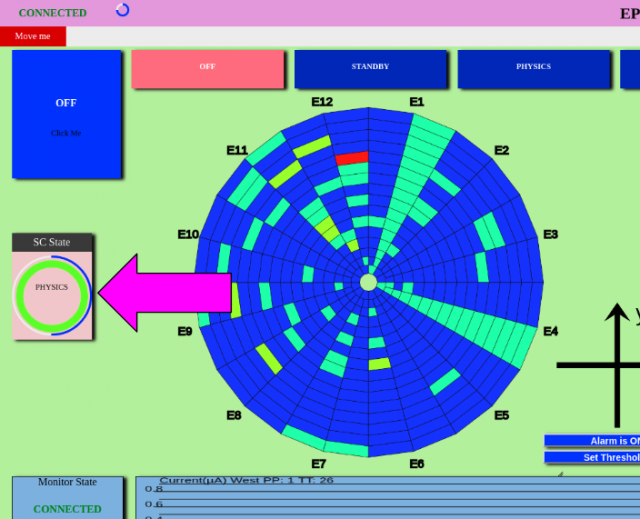
1. Connecting to the GUI
The GUI is very memory intensive and may run very slowly. If at any point it stops working and you need to restart the browser, the GUI is the default home page (the System Monitor can be left open to check the memory usage of Firefox. If it is above 1.5GB, it should be restarted). If the GUI page does not show up after restarting, the URL is located at the top of this document labeled as "Slow Controls". There is also a bookmark on the bookmark bar titled "EPD GUI". The first thing you should note any time you are using the GUI is whether you are connected or not.
It will attempt to auto-connect on its own. If after ~20 seconds it still has not connected, try refreshing the page. If you have just restarted the browser, refresh immediately, you will need to re-enter the username and password before it will connect. It should be auto-filled. If it's not, the username is "protected" (without quotes). If you do not know the password, ask the Shift Leader.
If after restarting the browser, refreshing the page and waiting a sufficient amount of time you are still not connected, refer to the end of this document (TUFF controls) for troubleshooting. This may happen if STAR loses power. By default the power supply is not set to turn back on automatically.
2. Setting Permissions
If the GUI has been reset, it may start in ReadOnly mode.
To change this, click on ReadOnly in the upper-right. This will bring up a drop down menu. Mouse over "Permissions" to see another list.
.png)
In general, you should use the DetectorOperator setting. This will enable you to operate the EPD under normal running conditions. In principle, it is possible for anyone to select Expert, but only do this if you need to (if you need to change a setting and it says you need to be in Expert mode, it is okay to do so, just inform the Shift Leader and a note should be made in the Shift Log). When selecting Expert, one is only given permission for a certain amount of time before reverting back to DetectorOperator mode.
To make the drop down menu go away, click again on current setting in the upper-right (DetectorOperater, Expert or ReadOnly). The menu will not go away by clicking anywhere else.
3. Turning on/off the SiPM high voltage
To turn on the high voltage, first click the "PHYSICS" button on the top bar, and then click the "PHYSICS" button in the upper-left corner.
In the event that the high voltage across the SiPMs needs to be turned off, first click the "OFF" button on the top bar, and then click the "OFF" button in the upper-left corner. This should only be done if specifically asked by an expert. The EPD will generally be left in Physics mode without ever being turned off.
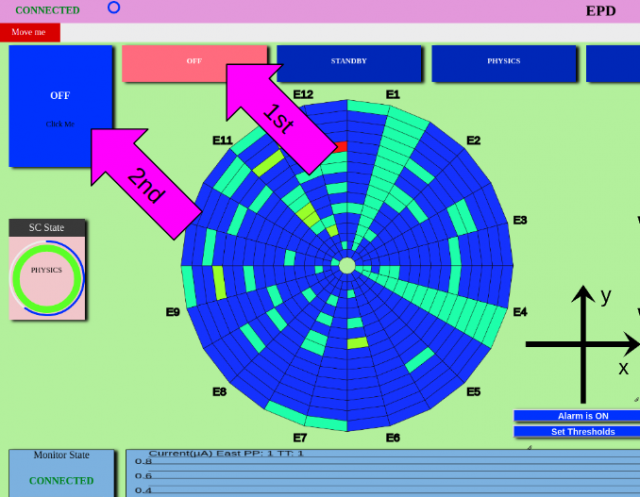
4. Performing the daily IV scan
An IV scan should be performed once per day, during other detectors' scans, when there is no beam. It may take up to 30 minutes. Whenever an IV Scan is done, a note should be made in the shift log. The "IVSCAN" button on the top bar should be clicked, followed by the "IVSCAN" in the upper-left corner. The current alarm may trip during an IVSCAN, this is normal and can be ignored. The final voltage for the IVSCAN is 65.4 V.
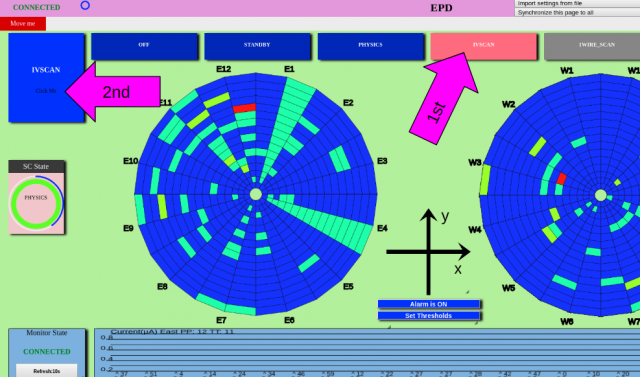
IMPORTANT: After the IVSCAN is done, it should automatically switch back into PHYSICS mode. If it doesn't, or if the SC State box is stuck with a half yellow circle trying to switch into PHYSICS, manually move the detector back into PHYSICS mode as normal. Make a note in the "IV Scan Log" if this happens.
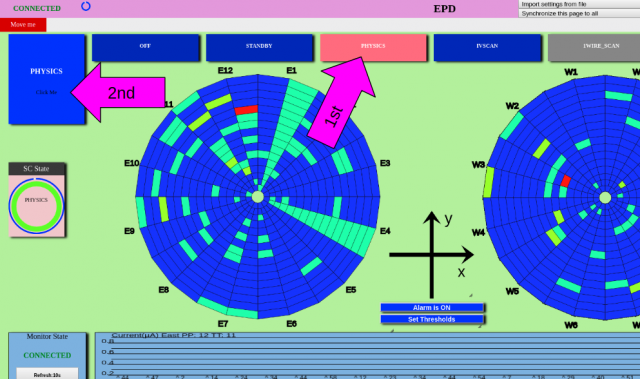
If need be, the EPD may be switched to the "PHYSICS" mode during an IV scan without harm (just be sure to wait for the EPD to be fully in the IV scan mode by checking that the green circle in the "SC State" box on the left side is complete. Enter a note in the logbook if this happens.
5. Other GUI information
Color-scale bounds can be set by moving the slider or entering values.
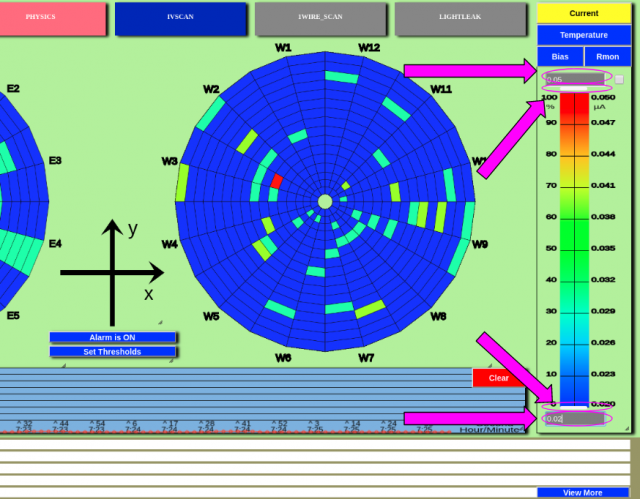
Measured values that cross an alarm threshold lead to an audible alarm and flashing tile(s). Hovering over a tile shows the associated warning.
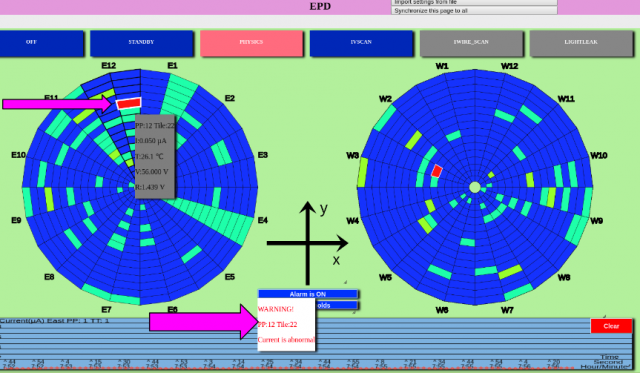
Alarms can be silenced (for 15 minutes) or unsilenced by double clicking the tile; muted tiles show black “X”s over them.
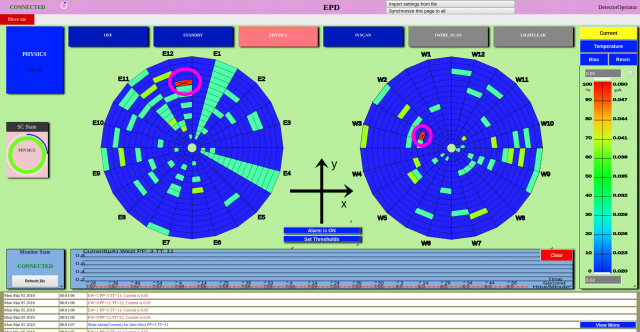
Entire supersectors can be silenced or unsilenced by double clicking on the names (e.g. “E12”) and entire wheels can be silenced or unsilenced by double clicking the middle.
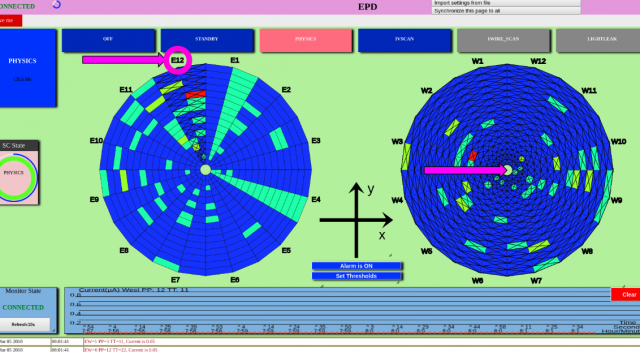
A short log is shown at the bottom, and a longer list can be brought up from the bottom-right corner.
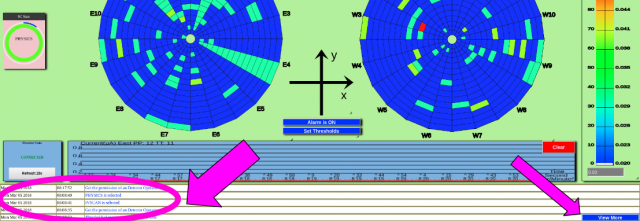
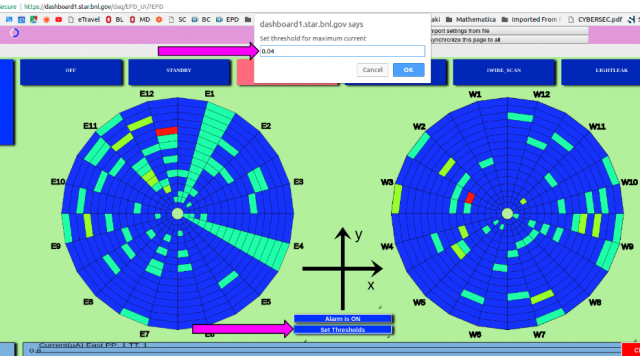
The threshold for current alarms should be at 2 microAmps (subject to change as the run continues). The threshold for temperature should be at 45 degrees Celcius. The thresholds for Rmon should be at 99 and 0.0 for the maximum and minimum, respectively.
6. TUFF Controls
The TUFF should only need to be accessed if power to STAR has been lost or if the power has been turned off for any reason. There should be a bookmark on the browser bookmark bar called "CyberPowerManag...", otherwise it can be accessed by entering 130.199.60.221 into the browser. The username and password are "cyber" and "p4*EPD!!" .
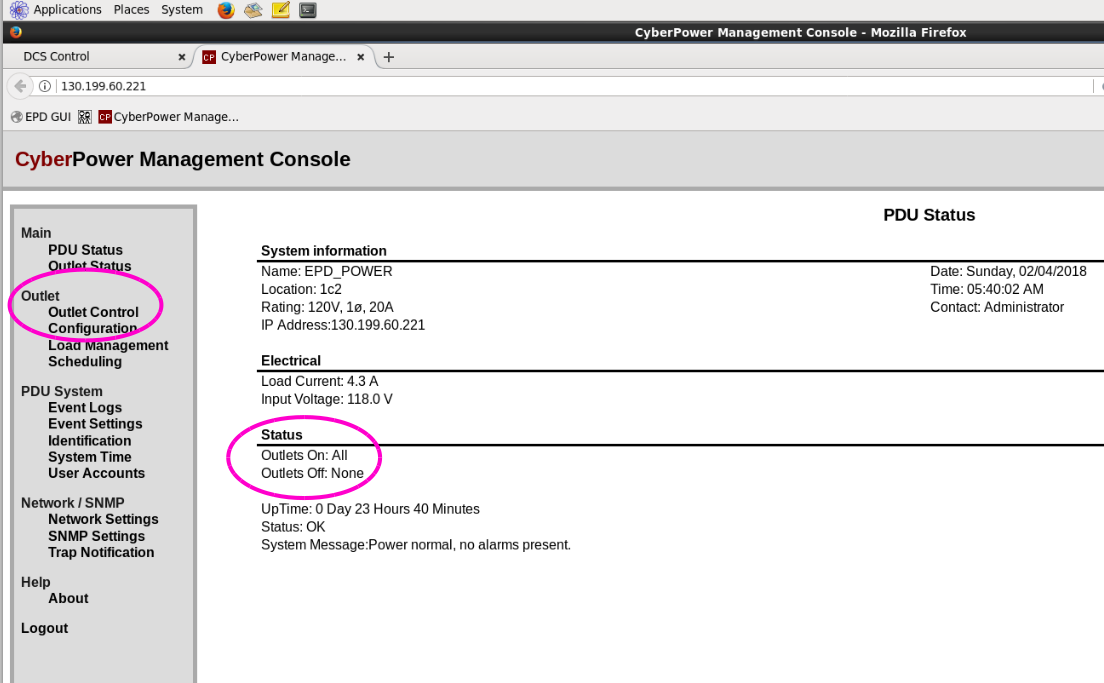
Under Status on the main page, you can check which outlets are on and off. If any of #1, 2, 3 or 4 are off, they will need to be turned on. Nothing is plugged in to outlets #5-8, so these can be ignored.
To turn on/off/reboot the outlets, on the left side of the screen, click Outlet Control. Select which outlets need to be turned on/rebooted (only #1-4 are hooked up, but all can be selected). Either Sequenced or Immediate can be selected for the delay. Once you click apply, a new page will pop up and will auto refresh once they have been changed to the new setting.

!!!!!IMPORTANT!!!!!
Any time the TUFF power has been reset, a "1WIRE_SCAN" must be performed before any of the other controls will work. This is done in the same way as the IVSCAN or going into PHYSICS mode. Click "1WIRE_SCAN" on the top bar, and then click "1WIRE_SCAN" on the box in the upper-left corner. If you click in the empty space below the "SC State" box, another box will appear/disappear. After performing a 1WIRE_SCAN, it should list the "FEEs Found" at 48. If it finds any number of FEEs other than 48, contact an expert.
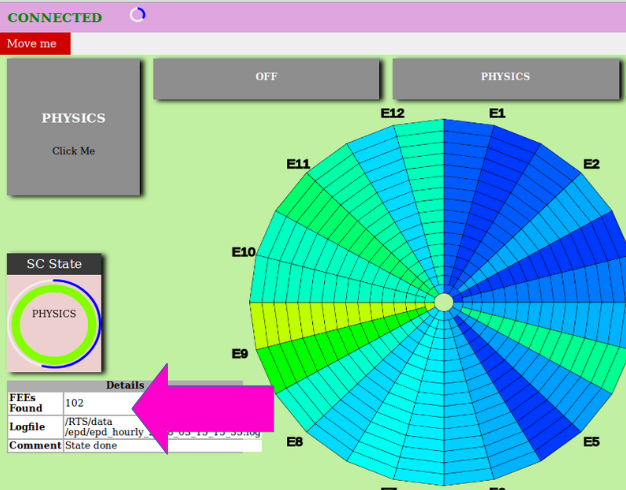
7. What to do if EQ crate won't configure
If the shift crew is trying to start a run but it is stuck in configuration because of eq1, eq2, or eq3 (which would show a red "W" next to it), then:
1. Stop the run
2. Power cycle that crate
(eq1 <--> VME 99,
eq2 <--> VME 100,
eq3 <--> VME 64),
3. Try starting another run
8. What to do if some tiles show a low <ADC>
Sometimes the QA plots will suddenly start showing one or more tiles with a low <ADC>

If this is seen in one or a few tiles, take a pedestal run. If two attempts at fixing it with a pedestal run do not work, call an EPD expert.
Printing This Document
Without following this printing procedure, the images will come out pixelated with text barely readable. I am using Chrome as the browser and Adobe Acrobat as my PDF viewer.
- In Chrome, highlight everything in the document
- Print to a PDF (go to "Destination" and select "Save as PDF", change the Layout to "Landscape", then go to "More Settings", "Options", and then select only "Selection Only")
- In Adobe Acrobat, select the printer icon, go to "Advanced", select "Print as Image" and select 600 dpi
- You can connect to the printer in the control room via the USB
Final Note
For any other issues outside of this document, please contact the Experts listed above. In general, first try normal solutions, ie. rebooting/powercycling crates, etc. The EPD should be hands off, only requiring an IVSCAN once per day, and to be turned back on in case of power failures. Otherwise it will be left in PHYSICS mode at all times and does not need to be powered on or off. Alarms for current will trip whenever there is a beam dump, the beam sweeps into the EPD, during APEX, etc. This is normal. You should only be alarmed by the current alarm if it stays on for an extended period of time and nothing odd is happening with the beam.
________________________________________________________________________________________________________________________________________________________________
EPD-GSTAR
1st iteration by Sam:
2nd iteration by Prashanth:
Added tile structure:
Dropbox link for log book:
https://www.dropbox.com/s/73ddkbhnmvpnpc1/vsp_gstar_071717.pdf?dl=0
3rd Iteration by Prashanth
Changes:
1. Tile coordinates are from Solid Works.
2. Implemented thinner part of the tiles.
3. More realistic tile 1
Blue are regular 1.2 cm thick tiles.
Green are thinner part of tiles.
Red Tile 1 lower side (Trapezoidal)
Magenta Tile 1 triangular part.
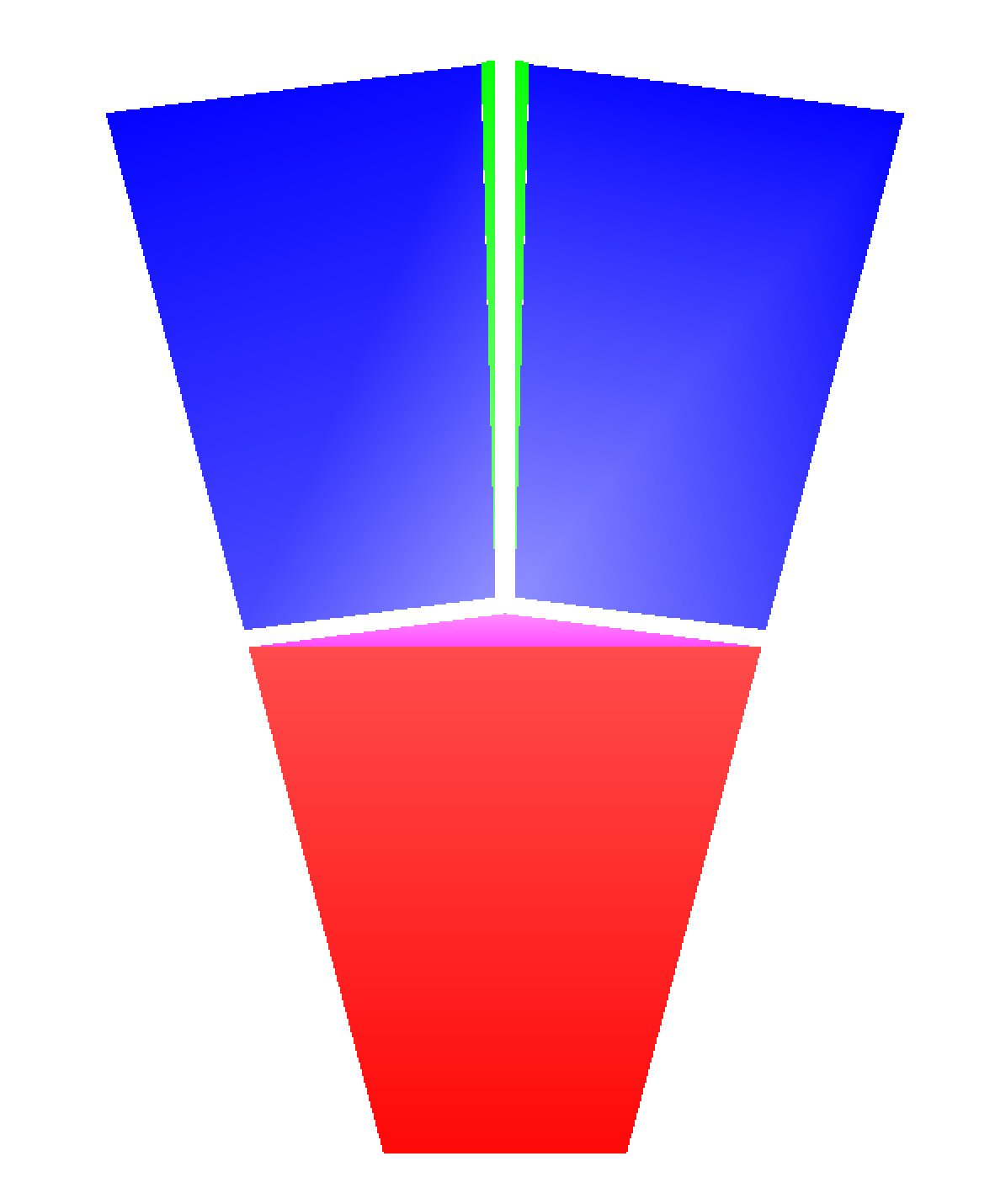
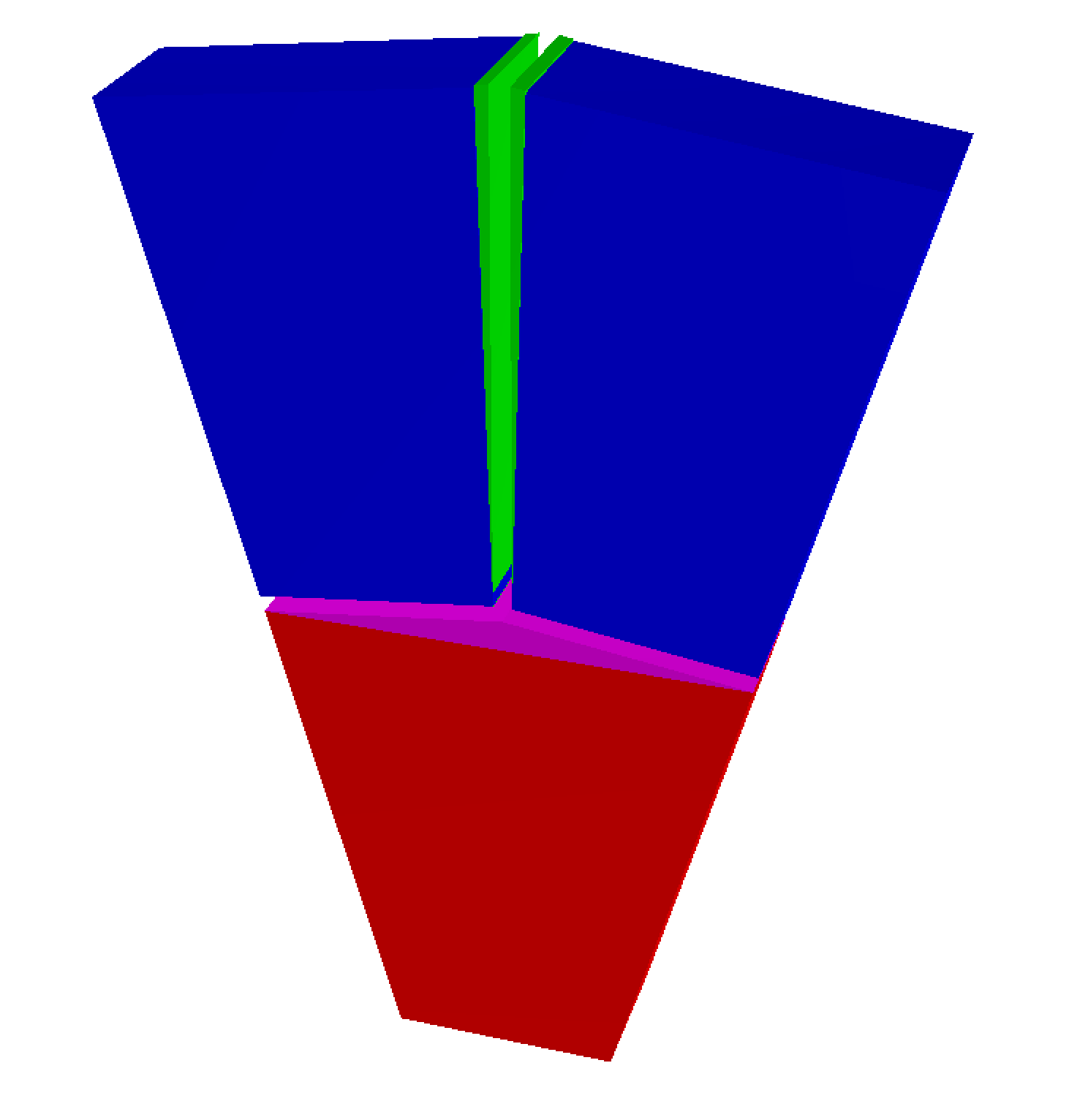

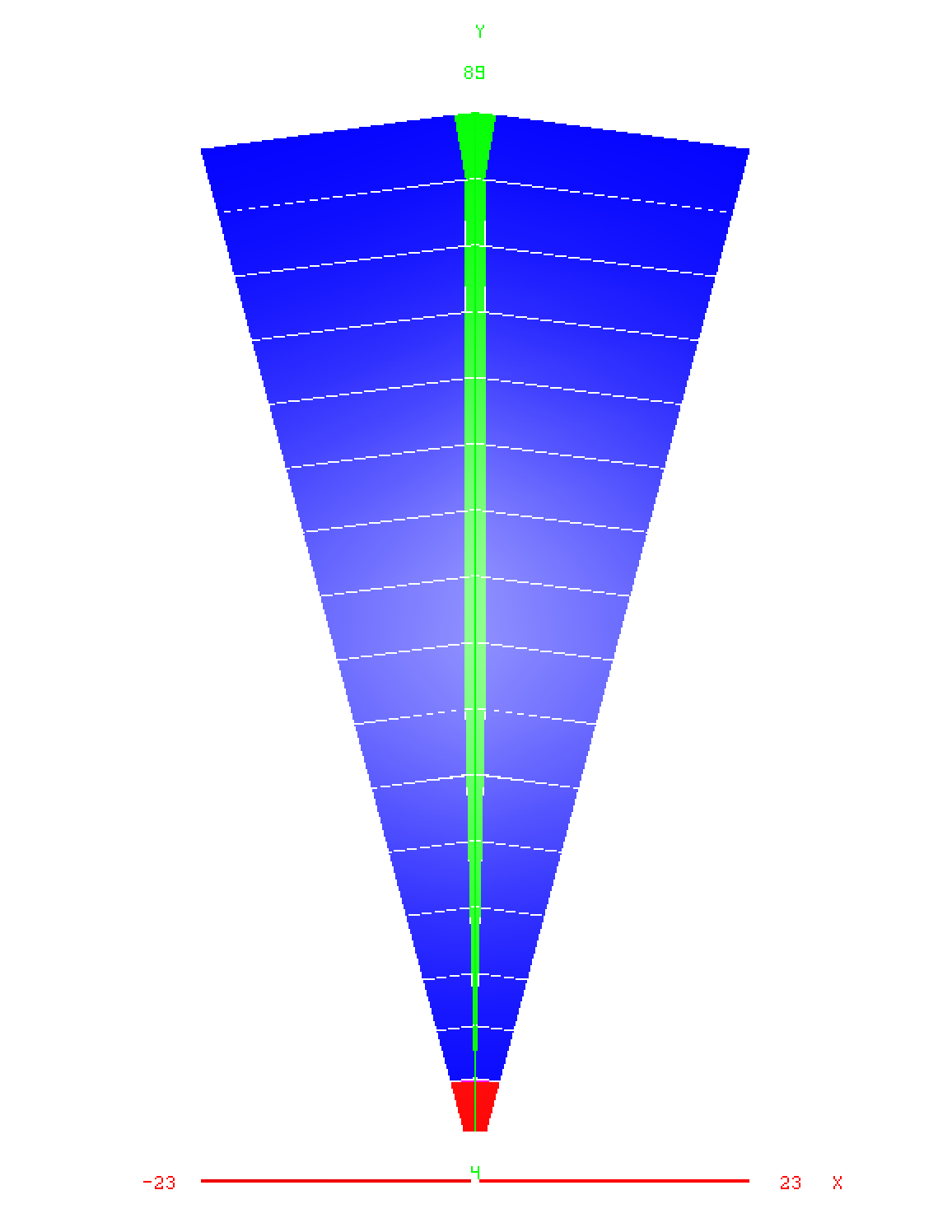
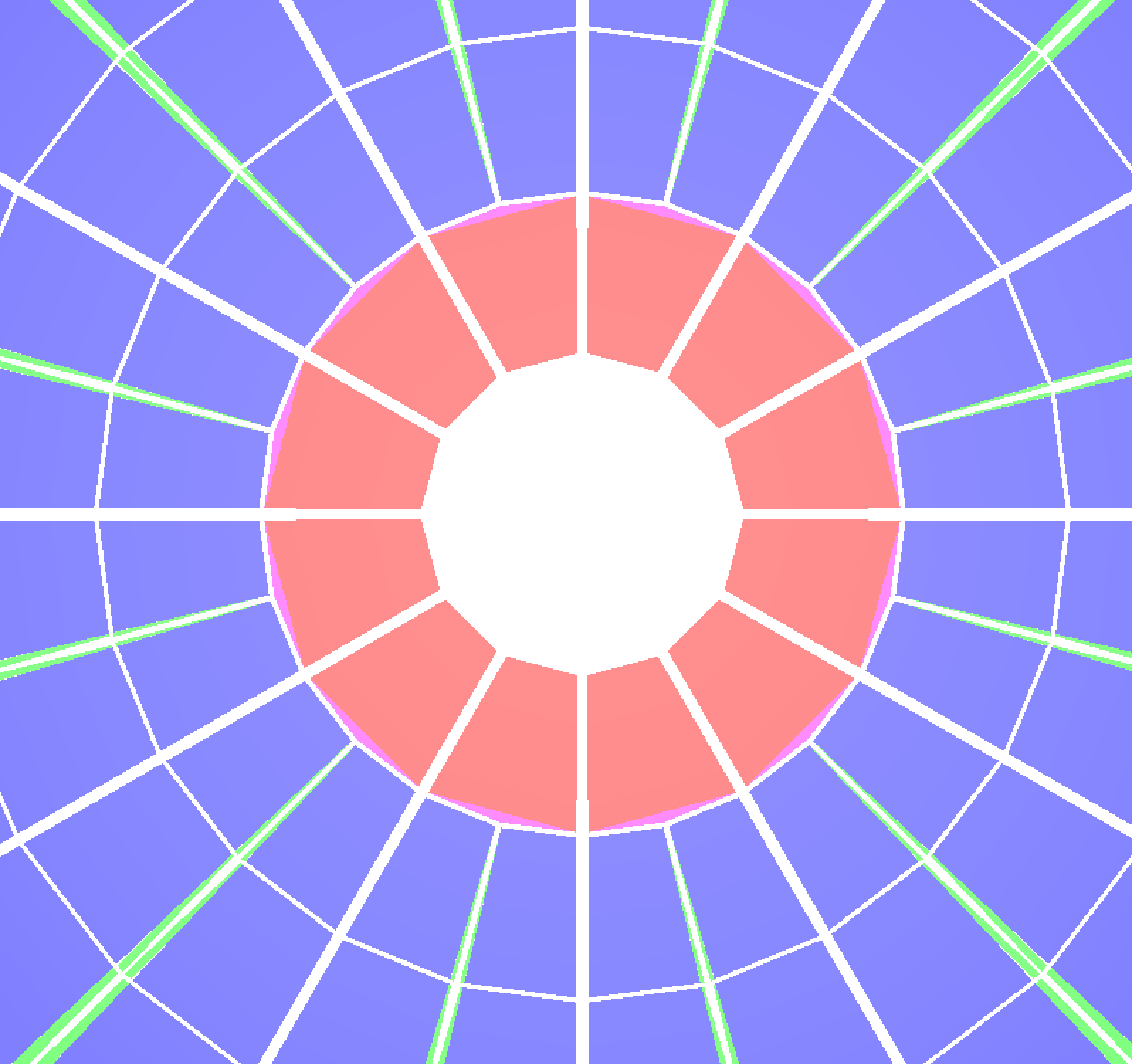
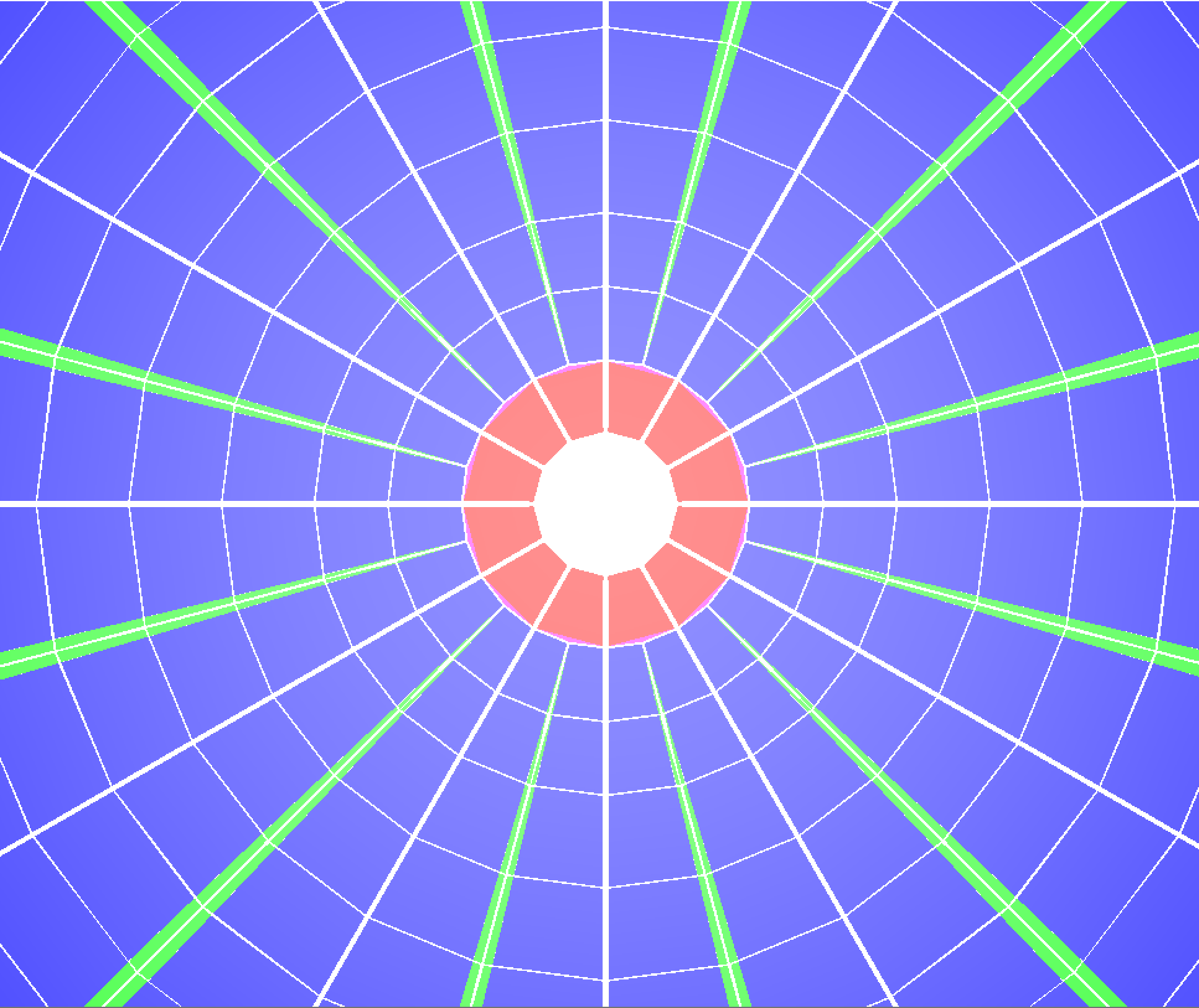
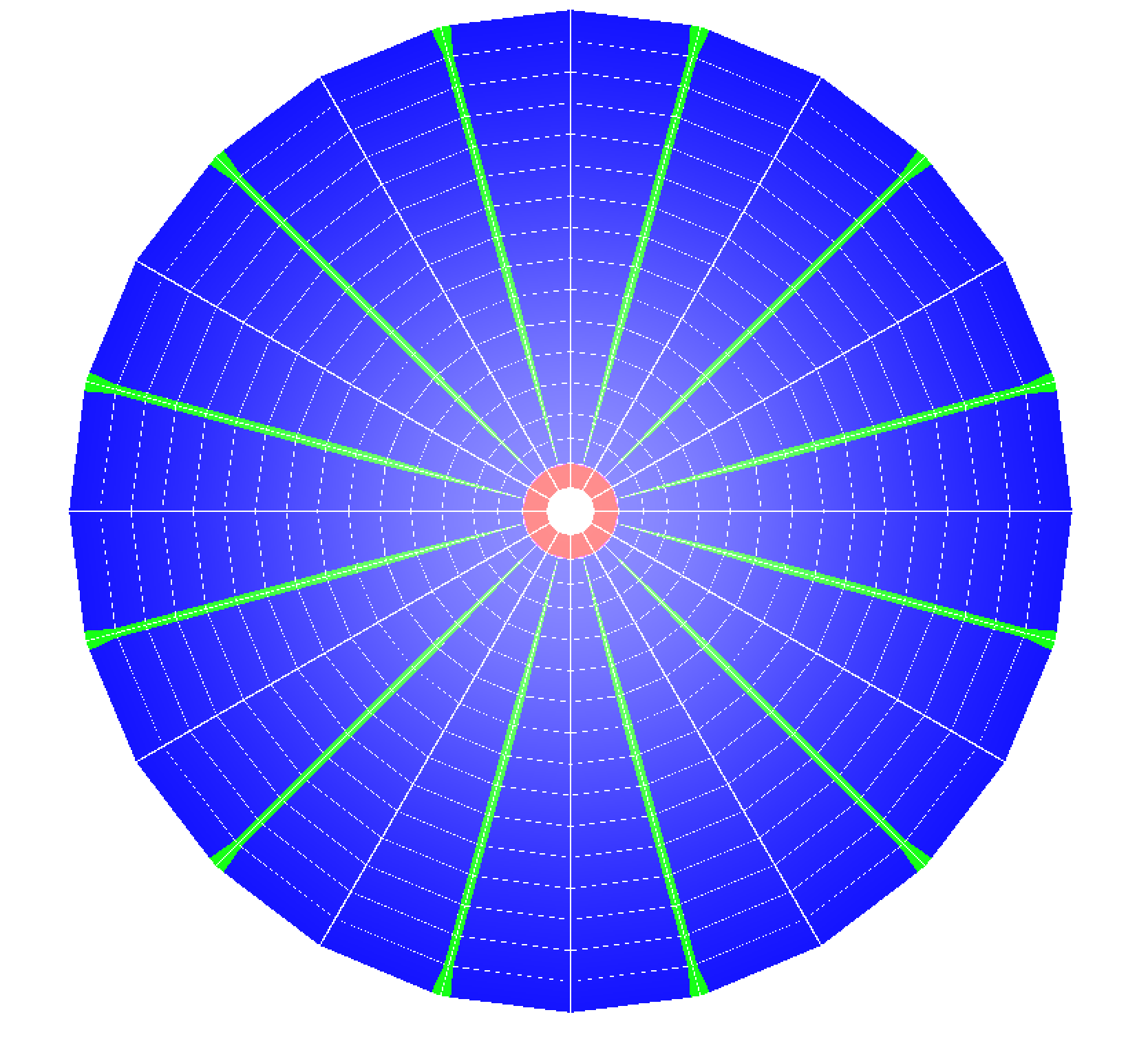
Here is the detail calculations:
IV Scan
Individual's pages
This area provides a place where individuals can post their EPD-related studies. See the "child pages" below.Cosmic tests at BNL
Cosmic tests at BNL - strange results (Dec. 7, 2017)All of the relevant plots, only a few of which are shown in this blog as examples, can be found here: https://drupal.star.bnl.gov/STAR/blog/adams92/te-chuan-huangs-plots-cosmic-tests-bnl
So far, here at BNL, we have taken 7 full cosmic runs. The cosmic runs use 4 large (~0.1 m wide by ~1 m long) paddles and tests 3 supersectors. One pair of paddles sits above the supersectors and another pair sits below. They can only cover half of a supersector, so we do a run with the odds covered and then do a separate run with the evens covered. The paddles can be used to determine the position and incident angle of each cosmic ray; however, we have been using the supersectors as offline triggers to isolate vertical cosmic rays (as was done at OSU). Some more detail is given in my presentation from this week's EPD meeting: https://drupal.star.bnl.gov/STAR/system/files/Cosmic%20Ray%20Testing%20at%20BNL.pdf
We realized earlier today that two of the 7 cosmic runs have strange results. These two runs were with (in one configuration) supersectors 21, 29, and 30 and (in another configuration) supersectors 23, 25, and 27. The strange results are:
1.1) The "zero" channels, which are non-existent supersector tiles, show what seems to be MIP peaks. There should of course be nothing.
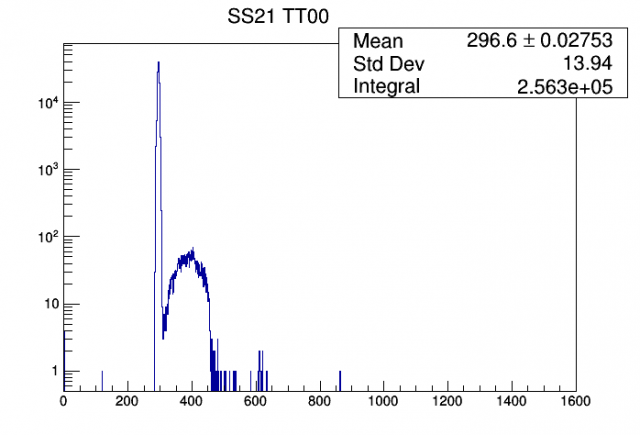 SS21_TT00: &nbsp;
SS21_TT00: &nbsp;For all 6 supersectors in the aforementioned "problem" runs, the tile 0 ADC distributions look like this.
1.2) For the configuration with supersectors 02, 03, and 04, the tile 0 ADCs also show what seem to be a very small MIP peak.
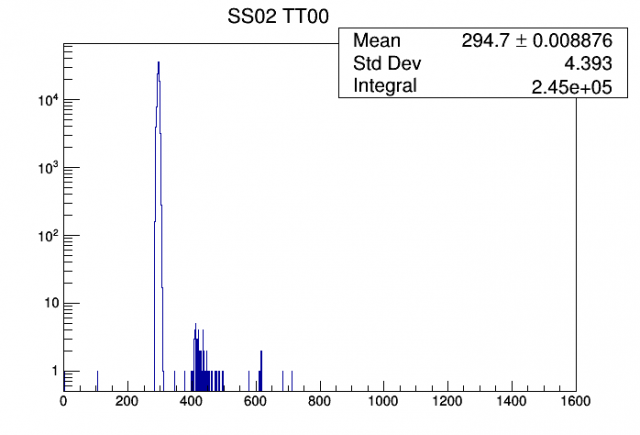 SS02_TT00: &nbsp;
SS02_TT00: &nbsp;For all 3 supersectors, this is seen in tile 0. In fact, this configuration (even tiles of supersectors 02, 03, and 04) was taken twice, and each 24-hour run shows this behavior in all 3 supersectors.
2.1) The ADC distributions do not represent standard MIP peaks. There is a bump to the right of the peak.
 SS21_TT16: &nbsp;
SS21_TT16: &nbsp;You guessed it: this is seen for all even tiles of supersectors 21, 23, 25, 27, 29, and 30. Supersectors 02, 03, and 04, which had the very small tile 0 signals, do not show this bump.
2.1)
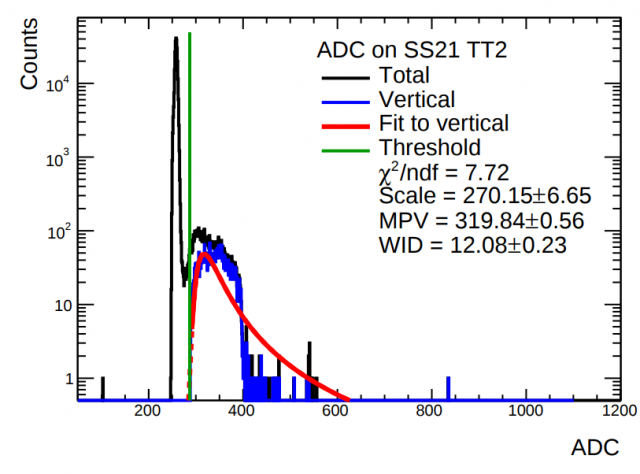 SS21_TT02_vertical: &nbsp;
SS21_TT02_vertical: &nbsp;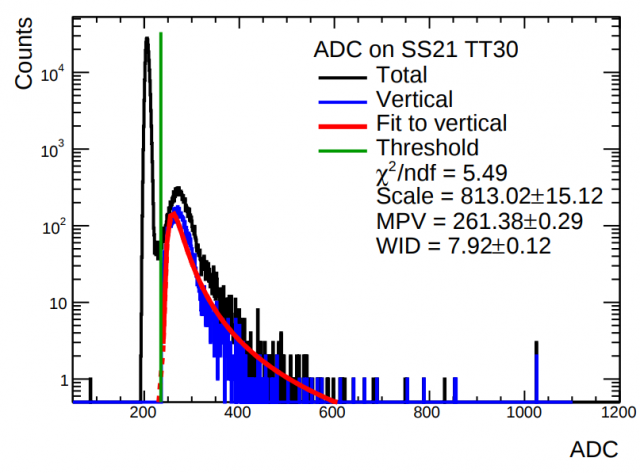 SS21_TT30_vertical: &nbsp;
SS21_TT30_vertical: &nbsp;At this point, I feel like I don't have to say that this behavior is true of supersectors 21, 23, 25, 27, 29, and 30.
Some notes:
1) The same fiber bundles are being used for all runs.
2) The same ADC channels, receiver cards, and trigger paddles are being used for the even and the odds.
3) Vertical cosmics are determined offline from the supersectors by requiring hits above some threshold in the same tile number of each supersector.
4) At OSU, we saw some random spikes and drops in the ADCs that were generally short lived but significant in magnitude. Here, they have been pretty stable.
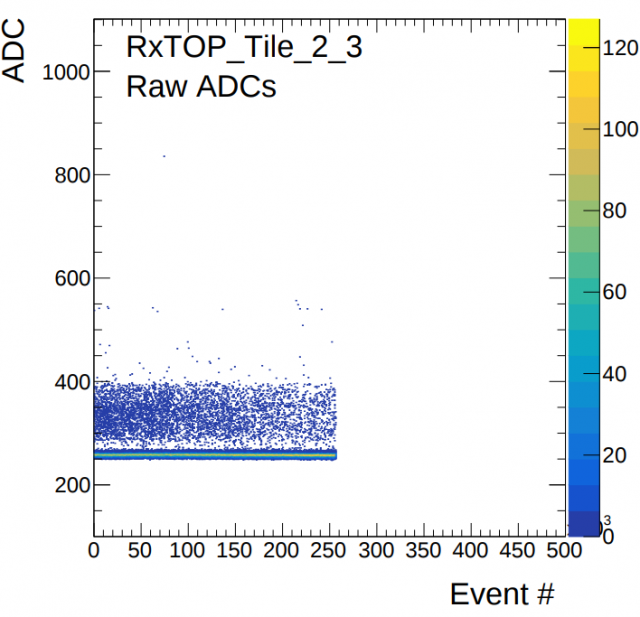 SS21_TT02_strip: &nbsp;
SS21_TT02_strip: &nbsp;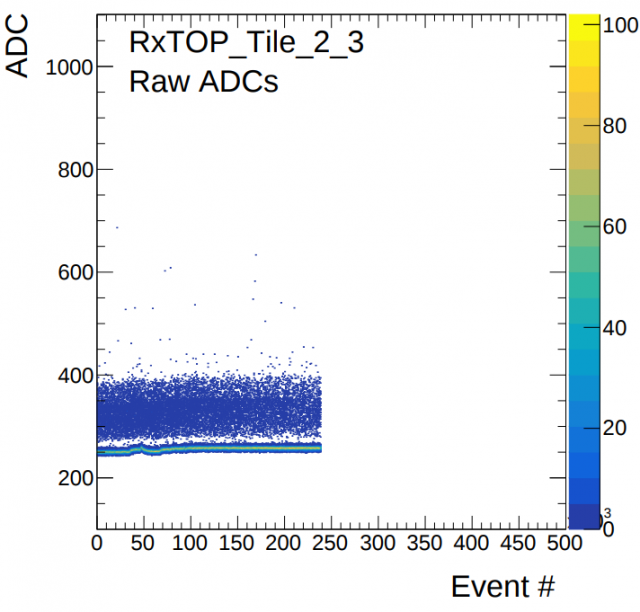 SS25_TT02_strip: &nbsp;
SS25_TT02_strip: &nbsp;5) At OSU, when performing the heat map tests at high bias voltage (~66 V), we saw the dark current walk in each tile independently.
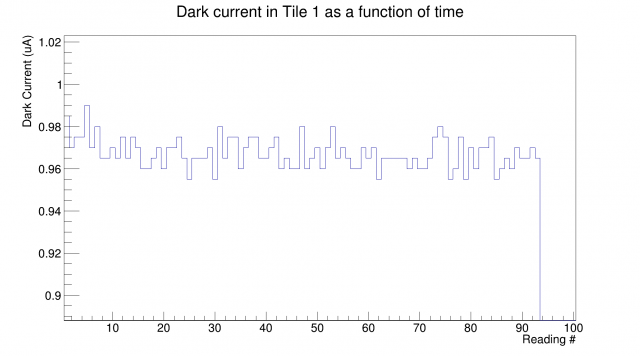 DarkWalk_TT01: &nbsp;
DarkWalk_TT01: &nbsp;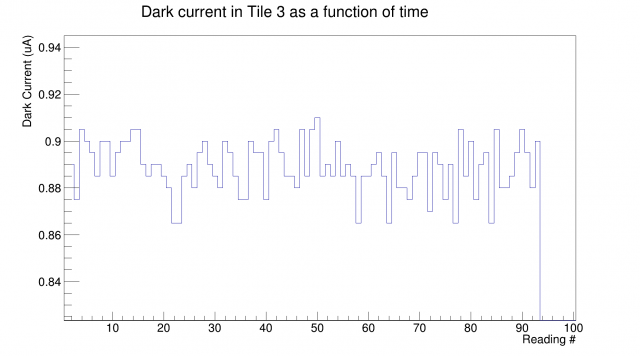 DarkWalk_TT03: &nbsp;
DarkWalk_TT03: &nbsp;A profile histogram showing all odd tile dark currents walking on average:
 DarkWalk_FEE5: &nbsp;
DarkWalk_FEE5: &nbsp;6) (Dec. 8th) Tim Camarda and I looked inside the FEE box to make sure everything was connected properly. We found nothing apparently wrong with the setup and proceeded to switch the FSCs in FEEs 5 and 6 (as well as their corresponding RX cables in the back of the corresponding RX card) to read the even tiles out of an "odd" FEE (i.e. a FEE previously used to measure only odd tiles). We didn't take enough data to see something wrong with the ADC distributions, but we DID see a non-pedestal signal in tile 0. I can't imagine there is anything physically creating a signal (let's just take that probability to be 0), so this implies that whatever problem we are seeing exists in ALL FEE cards and only happened to show up during the even runs.
7) The transmission of the fiber bundles we are using here at BNL are:
FB 10: -62%
FB 11: -62%
FB 17: -63%
The transmissions of the fiber bundles used at OSU are:
FB 02: -55%
FB 03: -54%
FB 04: -63%
FB 05: -62%
8) (Dec. 11th) It was realized in this week's EPD meeting that events with more than a few tiles firing were not thrown out; this cut was being applied for the cosmic testing at OSU. Te-Chuan Huang plotted the ADC_{Tile 0} vs the ADC_{Tile X}, and we see three main features: a pedestal (which is all that we should get in theory), a diagonal line (which likely is the shoulder we see in the "big" problem even tiles), and some fuzz in-between.
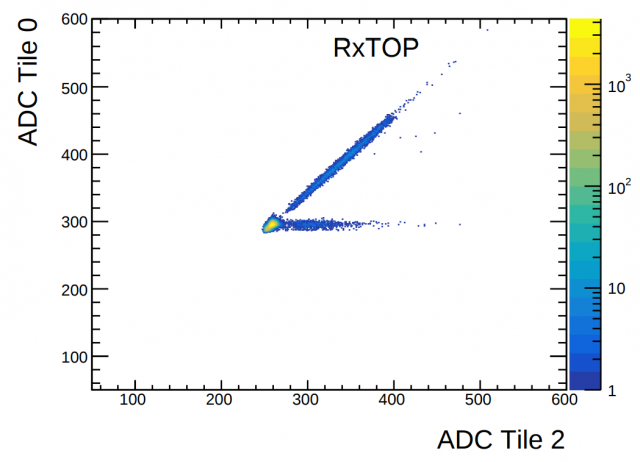 TOP_SS212930: &nbsp;
TOP_SS212930: &nbsp; MID_SS212930: &nbsp;
MID_SS212930: &nbsp;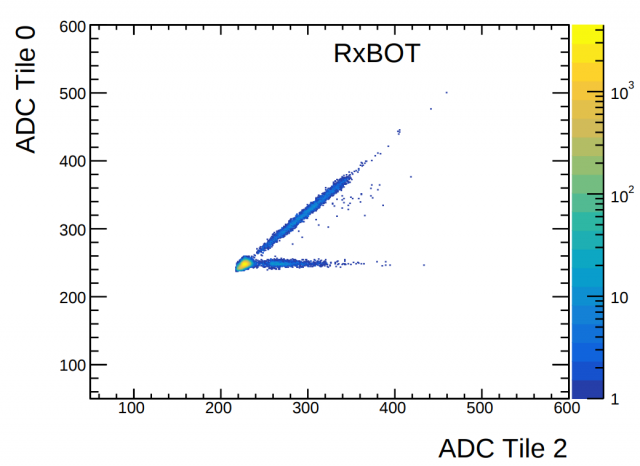 BOT_SS212930: &nbsp;
BOT_SS212930: &nbsp;This is plotted against ADC_{Tile 2}, but the same behavior exists for all tiles. The slopes are not the same in every case, but the slope associated with RxMID is consistently lower than the slopes of RxTOP and RxBOT. The diagonal is likely associated with all channels firing at once.
For the "small" problem runs, we see the same features: a pedestal, a diagonal, and some fuzz in-between. The difference is that there are fewer "diagonal" or "fuzz in-between" events in these runs.
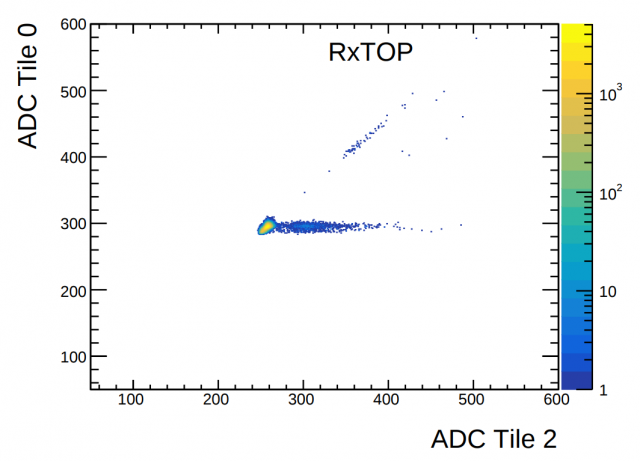 TOP_SS020304: &nbsp;
TOP_SS020304: &nbsp;It seems likely that the "small" and "big" problems are really the same, time-varying problem; that this problem just so happened not to be present during the odd runs, to be more dominant during the first two even runs, and not to be as dominant during the following even runs.
8) (Dec. 12th) In order to rule out cross talk at the FSC, I produced a cross-talk heat map including tile 0. The "Excess Current With Source [underneath]" obviously doesn't make sense for tile 0, so I took it to be 0.1 uA (other tiles typically have an excess of 0.5 uA) to make the colors more discernible.
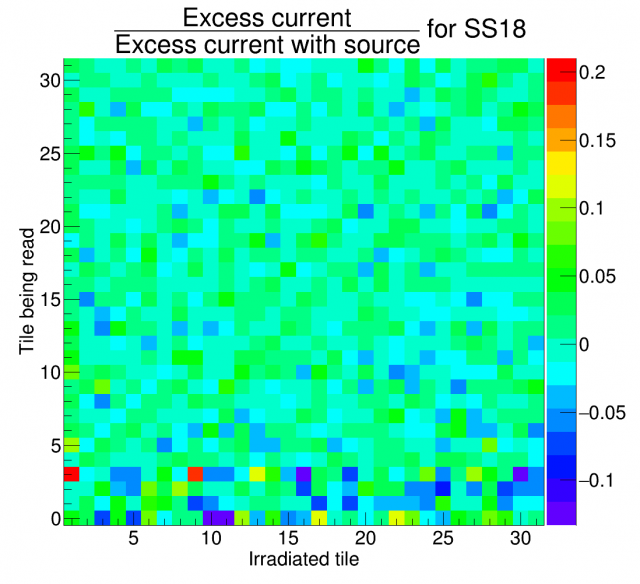 FSC_xTalk: &nbsp;
FSC_xTalk: &nbsp;We see from the bottom row (the only relevant part of the plot) that there is just noise. If the FSC cross talk was existent, we would see it between tile 0 and tiles 1, 2, 8, 9, and 10; we don't see that here.
9) (Dec. 12th) In order to see whether the problem is isoloated to a given FEE/Rx card or if it is global, ADC_{tile 0, RxTOP} was plotted against ADC_{tile X, RxMID} and ADC_{tile X, RxBOT}.
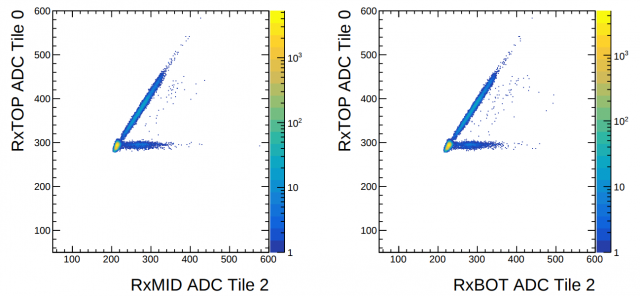 TOP0vsMIDandBOT: &nbsp;
TOP0vsMIDandBOT: &nbsp;There are no noticeable differences between these plots and those within the same Rx card (see point 8), indicating that this is a global problem
10) (Dec. 12th) In an attempt to remove the diagonal and "fuzz" addressed in point 8, a cut was applied to throw away events with more than 10 tiles in a given supersector reading hits. This removed most of the diagonal and fuzz.
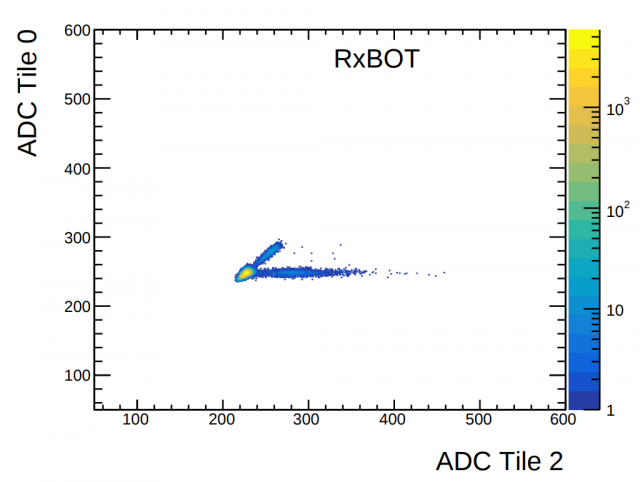 ADC_10hitCut: &nbsp;
ADC_10hitCut: &nbsp;There is a soft cutoff in ADC_{tile 0} for each plot.
11) (Dec. 12th) Just to make sure that this problem is not isolated to tile 0, ADC_{tile 10} was plotted against ADC_{tile X} with the cut mentioned in point 9.
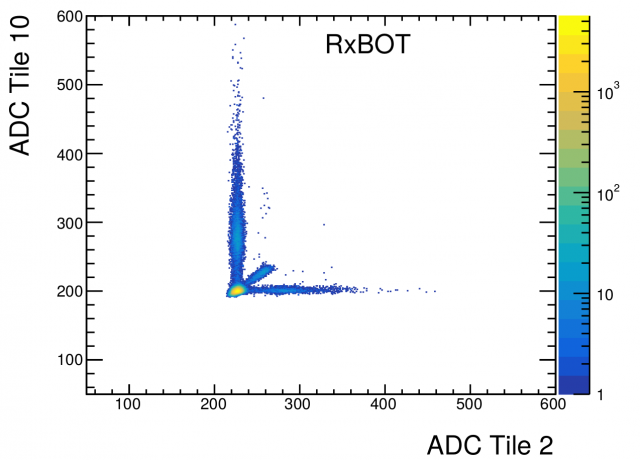 ADC_tile10vsTileX: &nbsp;
ADC_tile10vsTileX: &nbsp;Unsurprisingly, we see that this problem is not isolated to tile 0.
___________________________________________________________________________________________________________________________________________________________________________________________
Isaac Upsal
Generally stuff is on my blog (https://drupal.star.bnl.gov/STAR/blog/iupsal), so I'll provide links to EPD stuff here.Maybe useful references:
pEPD darkcurrent measurements showing radiation damage:
https://drupal.star.bnl.gov/STAR/blog/iupsal/sipm-dark-current-2015-pepd
EPD cosmic tests (from Joey):
https://drupal.star.bnl.gov/STAR/blog/iupsal/osu-epd-supersector-cosmic-tests
EPD v2 at 54GeV:
https://drupal.star.bnl.gov/STAR/blog/iupsal/first-look-epd-v2
EPD centrality NN study for 54GeV data:
https://drupal.star.bnl.gov/STAR/blog/iupsal/epd-centrality-nn-study
BBC tile size crosscheck (the BBC page is wrong)
https://drupal.star.bnl.gov/STAR/blog/iupsal/bbc-tile-size
Probably not interesting in the future:
GEANT stuff:
https://drupal.star.bnl.gov/STAR/blog/iupsal/epd-geant-simulation-update
pEPD cosmic testing ect.:
https://drupal.star.bnl.gov/STAR/blog/iupsal/osu-epd-testbench-bes-meeting-feb23-2015
https://drupal.star.bnl.gov/STAR/blog/iupsal/osu-epd-testbench-page-numbers
https://drupal.star.bnl.gov/STAR/blog/iupsal/osu-epd-testbench-epd-meeting-feb25-2015
https://drupal.star.bnl.gov/STAR/blog/iupsal/osu-epd-testbench-bes-meeting-march9-2015
https://drupal.star.bnl.gov/STAR/blog/iupsal/osu-epd-testbench-epd-meeting-march11-2015
pEPD FEE box geometry and cabling:
https://drupal.star.bnl.gov/STAR/blog/iupsal/pepd-2016-fee-box-geometry-and-cabling
OSU fiber polishing (Joey and Keith):
https://drupal.star.bnl.gov/STAR/blog/iupsal/osu-fiber-polishing-epd
EPD FEE box basics design and schematic (design in these documents is not final):
https://drupal.star.bnl.gov/STAR/blog/iupsal/epd-box-design
https://drupal.star.bnl.gov/STAR/blog/iupsal/epd-fee-box-schematic
Presentations given outside of EPD meetings:
October 2014 Upgrade workshop (this is all Alex, not me. I just thought it should be uploaded somewhere since I don't see it on the meeting page):
(attached)
November 2014 collaboration meeting:
https://drupal.star.bnl.gov/STAR/meetings/star-collaboration-meeting-november-3-7/plenary-session-i/epd
June 2015 Collaboration meeting (shared with Michael Lomnitz):
https://drupal.star.bnl.gov/STAR/content/epd-status
November 2017 Analysis meeting, Yang and I talk about 54GeV flow using the EPD during the BulkCorr meeting:
https://drupal.star.bnl.gov/STAR/meetings/star-fall-2017-analysis-meeting/bulk-correlations-parallel-2/epd-54-gev
February 2018 Collaboration meeting, I use a bit of my BulkCorr spot to talk about centrality (this is less detailed than the EPD meeting presentation):
https://drupal.star.bnl.gov/STAR/meetings/star-collaboration-meeting/bulkcorr/mag-field-r17
Justin Ewigleben
Justin Ewigleben's studies
Prashanth
Prashanth pagesRobert Pak
Robert Pak's studiesRosi Reed
Saehanseul Oh
Saehanseul Oh
Sam Heppelmann
Sam Heppelmann pagesTe-Chuan Huang
First results of autumn 2017 cosmic tests at STAR
The first vertical cosmics results:
- Landau fits: STAR/system/files/userfiles/3886/ADC_SS252723_odd.pdf
- presentation: drupal.star.bnl.gov/STAR/system/files/TeChuan_EPD_cosmic_20171204_0.pdf
Vertical cosmic rays of EPD with SS08181007 configurations
-
- FEE strips:
https://drupal.star.bnl.gov/STAR/system/files/SS08181007odd_Configuration1_Strips_FEE.pdf
https://drupal.star.bnl.gov/STAR/system/files/SS08181007odd_Configuration2_Strips_FEE.pdf
https://drupal.star.bnl.gov/STAR/system/files/SS08181007odd_Configuration3_Strips_FEE.pdf
https://drupal.star.bnl.gov/STAR/system/files/SS08181007odd_Configuration4_Strips_FEE.pdf
https://drupal.star.bnl.gov/STAR/system/files/SS08181007even_Configuration1_Strips_FEE.pdf
https://drupal.star.bnl.gov/STAR/system/files/SS08181007even_Configuration2_Strips_FEE.pdf
https://drupal.star.bnl.gov/STAR/system/files/SS08181007even_Configuration3_Strips_FEE.pdf
-
https://drupal.star.bnl.gov/STAR/system/files/TeChuan_EPD_cosmic_20170918_3.pdf
- ADC fits
https://drupal.star.bnl.gov/STAR/system/files/ADC_2.pdf
Vertical cosmic rays of EPD with SS14081516 and SS17181920 configurations
SS14081516 configuration:
Strips:
https://drupal.star.bnl.gov/STAR/system/files/SS14081516odd_Configuration1_Strips_FEE.pdf
https://drupal.star.bnl.gov/STAR/system/files/SS14081516odd_Configuration2_Strips_FEE.pdf
https://drupal.star.bnl.gov/STAR/system/files/SS14081516odd_Configuration3_Strips_FEE.pdf
https://drupal.star.bnl.gov/STAR/system/files/SS14081516even_Configuration1_Strips_FEE.pdf
https://drupal.star.bnl.gov/STAR/system/files/SS14081516even_Configuration2_Strips_FEE.pdf
https://drupal.star.bnl.gov/STAR/system/files/SS14081516even_Configuration3_Strips_FEE.pdf
ADCs:
https://drupal.star.bnl.gov/STAR/system/files/ADC_SS14081516.pdf
====================================================================================================
SS17181920 configuration:
Strips:
https://drupal.star.bnl.gov/STAR/system/files/SS17181920even_Configuration1_Strips_FEE.pdf
https://drupal.star.bnl.gov/STAR/system/files/SS17181920even_Configuration2_Strips_FEE.pdf
https://drupal.star.bnl.gov/STAR/system/files/SS17181920even_Configuration3_Strips_FEE.pdf
https://drupal.star.bnl.gov/STAR/system/files/SS17181920odd_Configuration1_Strips_FEE.pdf
https://drupal.star.bnl.gov/STAR/system/files/SS17181920odd_Configuration2_Strips_FEE.pdf
ADCs:
https://drupal.star.bnl.gov/STAR/system/files/ADC_SS17181920.pdf
presentation:
https://drupal.star.bnl.gov/STAR/system/files/TeChuan_EPD_cosmic_20170925_0.pdf
dummy
Xinyue Ju
Jinyue Ju from USTC
Known issues and problems
[On this page, red, bold text indicates action needed.]Since the construction of the EPD, there have been problems here and there. Usually, we resolve them real time, then move on with our lives actually thinking we'll remember what we did. This page will hopefully solve those "What did we decide about what to do with those QA plot holes" and "Wasn't there a mapping change or something?" moments. This shouldn't be grounds for discussion (reserved for star-epd-l@lists.bnl.gov), but instead for descriptions of problems encountered, as well as the solutions and rationale behind them. If you see something that should be here, please put it here and add a reminder to the EPD Google Calendar. This will make all our lives so much easier!
| Description and link | Decision/Result | EPD Calendar reminder date if action required |
| Dark current oscillating in multiple channels |
Revisit after run19 | 2019-07-13 |
| "Y joints" on fiber bundles breaking | Reinforcement design needed | 2019-06-17 |
| Scattered cold tiles in QA plots | Replace QT32B daughter board | |
| 4-tile hole in <ADC> and <TAC> QA plots | Daughter card (EQ3,0x1C, DC2) replaced | |
| Channel measuring cosmics out of Rx board, but blue in QA plots and not showing any MIP peaks | Bad QT32B connector (EQ1-0x10-C) replaced | |
| EPD cable weight between Rx boards and QT boards | Regularly check cable tension between Rx and QT boards | 2019-06-17 |
| Totally dead tile | Switched the connector from EQ1-0x1D-B channel 3 to EQ3-0x1D-D channel 1 | |
| Totally dead tile | Fixed a bent ground pin | |
| ... | ... |
Mapping
Here we keep pages (they are "child pages" to this one) relating to mapping. This includes hardware maps of detector components to electronics and sofware maps of tiles to physical location.
The current mapping is: https://drupal.star.bnl.gov/STAR/system/files/EPD_mapping_4crate_05312023.xlsx
Old files below.
Geometry information for use in codes
Important!
The information on this page can be very helpful, but if you are running root (not necessarily root4star), please use the StEpdGeom class. It has all the geometrical information you will ever need.It is part of the StEpdUtil package (on RCAF, 'cvs co StRoot/StEpdUtil'), which also includes StBbcGeom (the geometry for the BBC, obviously), and StEpdEpFinder, which finds the Event Planes for you.
One often wants the phi and eta for a given tile.
In the attached file TestGeometry.txt there are two Double_t arrays that you can cut and paste into your code. It is a root macro. (drupal does not allow .C extension, so it is uploaded as .txt)
Double_t EpdTilePhi[2][12][31]
- first index is EW=0/1 - 0 means East wheel and 1 means West wheel
- second index is PP (position number)
- third index is TT (tile number)
- first index is EW
- second index is PP
The numbering of the supersector positions (PP) are such that it follows a clock face, when seen by particles flying into the detector. I.e. when viewed from (0,0,0) in the TPC. If you look at an EPD wheel from the outside, the numbering goes "counter-clockwise." See description in the StEpd software documentation for more discussion of this.
Keep in mind the official STAR Coordinate system:
- +x points South
- +y points up (thank goodness)
- +z points West

EpdTileCenterRadii_v4.ods is the spreadsheet which was used to calculate the geometric center of the various tiles. This center location is not trivial because the supersector design makes all but the first of the tiles asymmetric, where one side is higher than the other. An image is embedded in the spreadsheet where the basic trig calculations are done. The goal was to get these values for the psuedorapidity, so, for simplicity, the supersector was assumed to be centered on the y coordinate, which is true for no actual supersectors. Thus, if one wants the proper phi coordinate it is necessary to rotate the coordinates by (15 degrees)/2 for the first sector of the first supersector.
Additionally this spreadsheet was used for calculating the eta of the edges of each tile, as will be in the EPD NIM paper. A version of such a table was in the EPD construction proposal, but there appears to be some mistake in the calculation.
The scintillator of the EPD is assumed to start 4.6cm from the beamline, as designed. For reasons unclear to me the construction proposal has 4.5cm for this distance, but the difference is negligible. In reality there is a 1.65mm-thick epoxy gap between the tiles. This is not part of the calculation. One tile is assumed to end along the center of the gap and the next tile begins along the same line.
Hardware mapping for Run 2017
Hardware map for run 2017It is important to maintain a record of the correspondence between (physical) supersector number (SS), position on the detector (PP) in any given run.
Also needed is the correspondence between tile number (TT) on a supersector and the QT board associated with it.
Prashanth Shanmuganathan (sprashan@kent.edu) maintains this information for the 1/8 Installation in the 2017 run. (updated 5 Dec 2017 by Mike to show fiber bundle # also)
| position on the East side (PP) | physical SS # | Fiber bundle # |
| 4 o'clock | 3 | 3 |
| 5 o'clock | 4 | 4 |
| 6 o'clock | 2 | 2 |
| FEE # | tiles | one-wire ID |
|---|---|---|
| 1 | PP 4 odd-numbered tiles | 0xFF00000007F6043A |
| 2 | PP 4 even-numbered tiles | 0xFE0000003263413A |
| 3 | PP 5 odd-numbered tiles | 0x0800000032C3333A |
| 4 | PP 5 even-numbered tiles | 0x1100000032C0493A |
| 5 | PP 6 odd-numbered tiles | 0x4800000032C04A3A |
| 6 | PP 6 even-numbered tiles | 0xA700000032C3423A |
| Tile | FEE# = Rx# | FEE channel |
|---|---|---|
| 1 | 1 | 0 |
| 3 | 1 | 1 |
| 5 | 1 | 2 |
| 7 | 1 | 3 |
| 9 | 1 | 4 |
| 11 | 1 | 5 |
| 13 | 1 | 6 |
| 15 | 1 | 7 |
| 17 | 1 | 8 |
| 19 | 1 | 9 |
| 21 | 1 | 10 |
| 23 | 1 | 11 |
| 25 | 1 | 12 |
| 27 | 1 | 13 |
| 29 | 1 | 14 |
| 31 | 1 | 15 |
| 2 | 2 | 1 |
| 4 | 2 | 2 |
| 6 | 2 | 3 |
| 8 | 2 | 4 |
| 10 | 2 | 5 |
| 12 | 2 | 6 |
| 14 | 2 | 7 |
| 16 | 2 | 8 |
| 18 | 2 | 9 |
| 20 | 2 | 10 |
| 22 | 2 | 11 |
| 24 | 2 | 12 |
| 26 | 2 | 13 |
| 28 | 2 | 14 |
| 30 | 2 | 15 |
| Tile | FEE# = Rx# | FEE channel |
|---|---|---|
| 1 | 3 | 0 |
| 3 | 3 | 1 |
| 5 | 3 | 2 |
| 7 | 3 | 3 |
| 9 | 3 | 4 |
| 11 | 3 | 5 |
| 13 | 3 | 6 |
| 15 | 3 | 7 |
| 17 | 3 | 8 |
| 19 | 3 | 9 |
| 21 | 3 | 10 |
| 23 | 3 | 11 |
| 25 | 3 | 12 |
| 27 | 3 | 13 |
| 29 | 3 | 14 |
| 31 | 3 | 15 |
| 2 | 4 | 1 |
| 4 | 4 | 2 |
| 6 | 4 | 3 |
| 8 | 4 | 4 |
| 10 | 4 | 5 |
| 12 | 4 | 6 |
| 14 | 4 | 7 |
| 16 | 4 | 8 |
| 18 | 4 | 9 |
| 20 | 4 | 10 |
| 22 | 4 | 11 |
| 24 | 4 | 12 |
| 26 | 4 | 13 |
| 28 | 4 | 14 |
| 30 | 4 | 15 |
| Tile | FEE# = Rx# | FEE channel |
|---|---|---|
| 1 | 5 | 0 |
| 3 | 5 | 1 |
| 5 | 5 | 2 |
| 7 | 5 | 3 |
| 9 | 5 | 4 |
| 11 | 5 | 5 |
| 13 | 5 | 6 |
| 15 | 5 | 7 |
| 17 | 5 | 8 |
| 19 | 5 | 9 |
| 21 | 5 | 10 |
| 23 | 5 | 11 |
| 25 | 5 | 12 |
| 27 | 5 | 13 |
| 29 | 5 | 14 |
| 31 | 5 | 15 |
| 2 | 6 | 1 |
| 4 | 6 | 2 |
| 6 | 6 | 3 |
| 8 | 6 | 4 |
| 10 | 6 | 5 |
| 12 | 6 | 6 |
| 14 | 6 | 7 |
| 16 | 6 | 8 |
| 18 | 6 | 9 |
| 20 | 6 | 10 |
| 22 | 6 | 11 |
| 24 | 6 | 12 |
| 26 | 6 | 13 |
| 28 | 6 | 14 |
| 30 | 6 | 15 |
.png)
Please see attached mapping for more details.
Three Spreadsheets are included:
- Mapping Tiles
- Mapping FEEs
- Definitions
Input to 0x16 (QTC) and 0x18(QTB) are switched during access on 04/05/2017. New Mapping is attached (EPD_mapping_04052017.xlsx).
Mapping as of May 25 2017
There has been frequent mapping and swapping etc. Things can get confusing. This is the mapping as of 25 May 2017, and we (tentatively) plan to keep it this way at least through the Au+Au 53 GeV running. (Edit: nope, we remapped one more time. See drupal.star.bnl.gov/STAR/subsys/epd/mapping/mapping-53-gev-auau-run-30-may-2017)
- FEE cards:
- Five FEE cards are the original versions. One-wire codes 0xA700000032C3423A, 0x4800000032C04A3A, 0x0800000032C3333A, 0x1100000032C0493A, 0xFE00000032C3413A.
- And we have one new FEE card (one-wire code 0xE700000032C03B3A) with 2.5x higher gain. This will be the version we use going forward.
- We have four QT boards
- Two are QT32B boards with no TAC (hence up to 32 tiles served, with ADC only). These are addresses 0x10, 0x12.
- One is a QT32B board with TAC (hence up to 16 tiles served, with ADC and TAC). This is address 0x18.
- One is a QT32C board with TAC (hence up to 16 tiles served, with ADC and TAC). This is address 0x16. Here, things get even a little more complicated, as regards the TACs
- Eight of the TAC channels (4, 5, 6, 7, 28, 29, 30, 31, numbering starting at 0) are the original versions, which showed problems (spikes, etc) with the low-gain FEEs
- Four of the TAC channels have improvements implemented by Steve in April/May. These are channels 12, 15, 20, 23, numbering starting at 0.
- Four of the TAC channels are disabled (for technical reasons related to fixing the channels described above). These are 13, 14, 21, 22.
And, just for kicks, an additional complication is the signal from PP4TT15 is being split between a QT32B[with TAC] (0x18 ADC/TAC=8/12) and a QT32 C (0x16 ADC/TAC=19/23).
Steve Valentino made a very nice "cheat sheet" showing QTs 0x18 and 0x16, shown here:

I have made two maps showing these maps from the "detector point of view." The first one shows simply the "Universal ID" which is 100*PP+TT (both numbering starting at 1), and the second one shows also the QT address and QT channels (starting from zero) of the ADC and TAC. A TAC address of -1000 means there is no TAC. They are below. If you need to use these maps, you may want to download the file (see bottom of page) in pdf or png, and blow them up.


Mapping for the 53 GeV Au+Au run - 30 May 2017
For the final push of the 2017 run, we measure Au+Au with a mapping slightly different than the 25 May mapping. Here it is:PSSST! Wanna know how this nice graphic was generated? The macro is attached at the bottom of this page, or you can just click here
.png)
Offline DataBase
Per request from database admin Dmitry Arkhipkin <arkhipkin@bnl.gov>
https://drupal.star.bnl.gov/STAR/comp/db/how-to-user/new-table/
Here is the updated blog with the latest fields:
https://drupal.star.bnl.gov/STAR/blog/sprastar/epd-offline-db-table-updated
Following page is created:
https://drupal.star.bnl.gov/STAR/blog/sprastar/epd-offline-db-table
Dmitry has created the database for us, database explore is here:
https://online.star.bnl.gov/dbExplorer/
Entry History in tables:
Following entries erased after modigfication of tables{
* Geometry/epd/epdQTMap 2016-12-10 00:00:00 => sim initialization for year 2017
* Geometry/epd/epdQTMap 2016-12-20 00:00:00 => ofl initialization for year 2017
* Geometry/epd/epdQTMap 2017-02-13 12:00:00 => 1st cable mapping completed
* Geometry/epd/epdQTMap 2017-04-05 12:00:00 => QTB 0x18 and QTC 0x16 are swapped
* Geometry/epd/epdQTMap 2017-05-03 12:00:00 => QTC 0x16 are swapped PP5 Tile 10 and PP5 Tile 14 are swapped
* Geometry/epd/epdQTMap 2017-05-17 12:00:00 => Many changes drupal.star.bnl.gov/STAR/system/files/CableSwap_05172017.pdf
* Calibrations/epd/status 2017-05-30 12:00:00 => (inserted on 08/23/17)Updated the mapping, which is used for 54.4 GeV run
* Calibrations/epd/status 2016-12-10 00:00:00 => sim initialization for year 2017 (inserted on 08/23/17)
* Calibrations/epd/status 2016-12-20 00:00:00 => ofl initialization for year 2017 (inserted on 08/23/17)
* Geometry/epd/epdFEEMap 2016-12-20 00:00:00 => sim initialization for year 2017 (inserted on 08/23/17), 1-wire ID has the 54.4 GeV values
* Geometry/epd/epdFEEMap 2016-12-20 00:00:00 => ofl initialization for year 2017 (inserted on 08/23/17), 1-wire ID has the 54.4 GeV values
* Calibrations/epd/epdGain 2016-12-20 00:00:00 => sim initialization for year 2017 (inserted on 08/24/17)
* Calibrations/epd/epdGain 2016-12-20 00:00:00 => ofl initialization for year 2017 (inserted on 08/24/17)} Current entries:
* Geometry/epd/epdQTMap 2016-12-10 00:00:00 => sim initialization for year 2017
* Geometry/epd/epdQTMap 2016-12-20 00:00:00 => ofl initialization for year 2017
* Geometry/epd/epdFeeMap 2016-12-10 00:00:00 => ofl initialization for year 2017
* Geometry/epd/epdFeeMap 2016-12-10 00:00:00 => sim initialization for year 2017
* Geometry/epd/epdStatus 2016-12-10 00:00:00 => ofl initialization for year 2017
* Geometry/epd/epdStatus 2016-12-10 00:00:00 => sim initialization for year 2017
* Geometry/epd/epdGain 2016-12-10 00:00:00 => sim initialization for year 2017
* Geometry/epd/epdGain 2016-12-10 00:00:00 => ofl initialization for year 2017
* Geometry/epd/epdStatus 2017-02-08 00:00:00 => Completed 1st cabling
* Geometry/epd/epdFeeMap 2017-02-08 00:00:00 => Completed 1st cabling
* Geometry/epd/epdFeeMap 2017-02-08 00:00:00 => Completed 1st cabling
Operations 2017
53 GeV run
Some expectations of multi-hit:
(This study has been corrected since its original posting. Originally, I had assumed that all rings had 24 phi segments, but in reality, ring 1 (TT1) only has 12)
Update 15 June 2017: A first analysis of the ADC spectra bear out the expectations of the analysis below quite well! See drupal.star.bnl.gov/STAR/blog/lisa/multi-mip-events-2017-epd-auau-54-gev
As seen on the attached spreadsheet at drupal.star.bnl.gov/STAR/system/files/53GeVexpectations_1.xlsx, based on PHOBOS measurements at 62.4 GeV (see inspirehep.net/record/876609), we can expect the EPD to light up! This beam energy is higher than what the EPD was designed for, but we will be fine.
(That spreadsheet has been updated to include calculations for 200 GeV and for 19.6 GeV.)
The average number of hits expected in each tile is of order unity, and the multi-hit probabilities can be estimated using Poisson statistics. The spreadsheet attached uses a scan of the PHOBOS data for 62.4 GeV collisions (figure 16) at about 6% centrality. The average and multi-hit probabilities depend on the collision vertex position. Some examples are shown in the screenshots below.
Here, we see that for collisions not far from the center of the TPC (|Vz|<75 cm), we will be just fine: 6-MIP hits are at the sub-percent level:
Here is for collisions at the center of the TPC:
.png)
Here is for collisions at Vz=-75 cm:
.png)
But if we come a lot closer to the detector (say Vz=-2.75 cm, which is outside the TPC!!), then we get blasted:
.png)
Mapping used in the Au+Au 53 GeV run
(Right-click and do "view image" to see it blown up, if you need details on QT address and channel number)
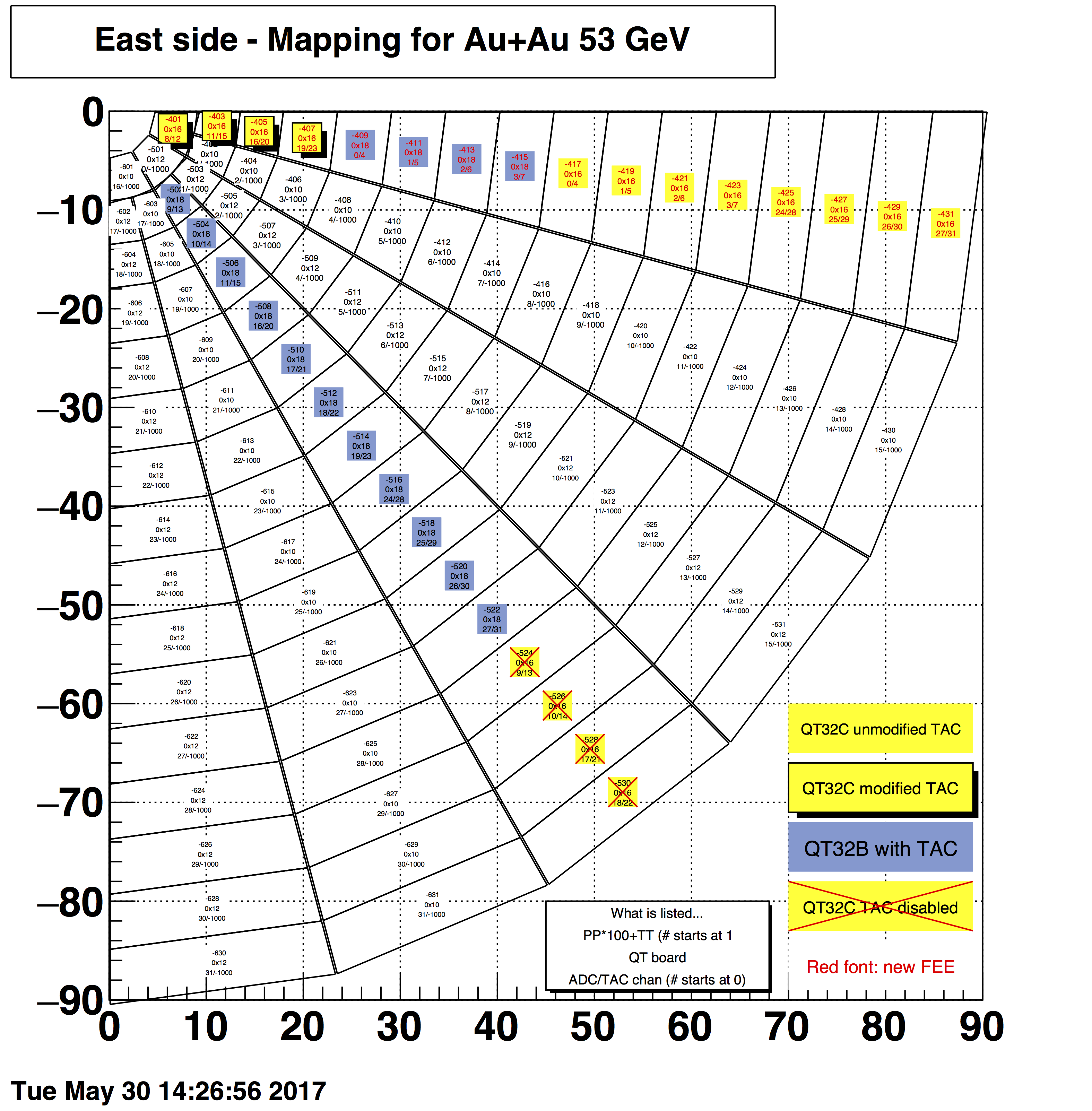
Bias Scan
Bias Scan runs taken by Rosi.
| No | Run No | Voltages: Vset / Vbias (*) | Prashanth's initial results | Mike's Results |
| 1 | 18089047 | 56.5 / 58.3 | Bias Scan | drupal.star.bnl.gov/STAR/system/files/BiasScan.pdf See below for analysis |
| 2 | 18089055 | 55.5 / 57.3 | ||
| 3 | 18089063 | 57.5 / 59.3 | ||
| 4 | 18089065 | 54.5 / 56.3 | ||
| 5 | 18090003 | 58.5 / 60.3 |
Root files for above runs are here: rcasxx:/gpfs01/star/subsysg/EPD/sprastar/EPDHists
(*) Bias voltage (Vbias) is 1.8 V above the Vset value one sets with the TUFF box. The relevant clip of Gerard's mail:
"The actual bias on the SiPM is higher than the setpoint by about 0.9 V for the
VCOMP (temperature compensation) plus about 0.9 V for the preamp input voltage
(the regulator regulates the anode voltage to -(VSET+VCOMP)*(1 +/-1% error) )"
Note that Hamamatsu specs Vbias at about 57.7 V, for this initial batch of SiPMs:
drupal.star.bnl.gov/STAR/system/files/S13360-1325PE%20specs%20initial%20150.pdf
Mike's analysis of the bias scan - 9 April 2017
- We don't want to wander too far away from Hamamatsu's recommendation of Vbias=57.7 V (Vset=55.9 V), since the signal increases linearly with bias voltage (see plots), and the dark current increases exponentially with bias voltage.
- Looking carefully at the 6 FEE groupings (one FEE handles odd or even tiles from a supersector):
- 4 groupings (PP4 even, PP5 odd, PP6 odd, PP6 even) give MPV ~ 45 ADC counts for Vset ~ 56.5 V
- PP4 odd gives MPV ~ 60 ADC counts for Vset ~56.5 V: this is because it is read through QT32c which has higher gain
- PP5 even gives MPV ~ 24 ADC counts for Vset ~ 56.5 V: This may be due to one of the following reasons:
- This fee has a lower gain than the others
- This QT board has lower gain than the others.
- This may be checked by swapping inputs with another QT board
- The fiber-to-SiPM connection (FSC) is worse than the others.
- In principle, this could lead to a highter WID/MPV ratio due to reduced photon number and higher Poisson fluctuations, which is not observed.
- Nevertheless, I kind of suspect #3
- The "gain" is rather linear with Vset, so we can "peak-match" the various channels by adjusting Vset such that the MIP peak is always at the same location. However, this should only be done within limits. It makes no sense to lower Vbias a lot, just to "compensate" for the high gain of the QT32c or to raise it a lot to "compensate" for the low gain of PP5 even.
- Therefore, I suggest to proceed as follows: Set Vset such that
- MPV = 45 ADC counts for PP4 even, PP5 odd, PP6 odd, PP6 even
- MPV = 60 ADC counts for PP4 odd
- MPV = 25 ADC counts for PP5 even
- The Vset values, using this criteria, may be found at drupal.star.bnl.gov/STAR/system/files/VsetValues.txt
- I set Vset by hand to 56.5 for 3 of the 93 fits that failed.
BitMap Checking
Eleanor has given following information to start with:
%%%%%%%%%%%%%%%%%%%%%%%%%%%%%%%%%%%%%%%%%%%%%%%%%%%%%%%%%%%%%%%%%%%%%%%%%%%%%%%%%%%%%%%%%%%%%%%%%%%%%%%%%%%%%%%%%%%%%%%%%%%%
%%%%%%%%%%%%%%%%%%%%%%%%%%%%%%%%%%%%%%%%%%%%%%%%%%%%%%%%%%%%%%%%%%%%%%%%%%%%%%%%%%%%%%%%%%%%%%%%%%%%%%%%%%%%%%%%%%%%%%%%%%%%
pedasphys configuration is copied to epdbitcheck_pedasphys
Tier1 file is changed to trg_170414_EPQ_AlgoX_OLX.bin
EPQ_Algorithm_Latch changed from 1 to 7 in 1 unit steps
for each of above steps following output latch is changed
EPD_QT_Output_Latch_Delay 0 to 120 in 20 steps
EPD_QTc_Output_Latch_Delay 0 to 120 in 20 steps
| No | Run Number TAC min =50 |
Run Number TAC min =80 |
Run Number QTB TAC min =80 QTC TAC min =40
|
Run Number QTB TAC min =80 QTC TAC min =47 |
Run Number QTB TAC min =82 QTB ADC TH=80 QTC TAC min =40 |
EPQ_Algorithm_Latch (for QTB & QTC) |
EPD_QT_Output_Latch_Delay (for QTB & QTC) |
% Miss match 0x18 Algo v5.2 |
% Miss match 0x16 Algo v6.d |
% Miss match 0x12 Algo v6.4 |
% Miss match 0x10 Algo v6.4 |
| 1 | 18129066 | 18130041 | 18131026 | 18150036 | 18158037 | 1 | 0 | ||||
| 2 | 18129067 | 18130042 | 18131027 | 18150037 | 18158038 | 1 | 20 | ||||
| 3 | 18129068 | 18130043 | 18131028 | 18150038 | 18158039 | 1 | 40 | ||||
| 4 | 18129069 | 18130044 | 18131029 | 18150039 | 18158040 | 1 | 60 | ||||
| 5 | 18129070 | 18130045 | 18131030 | 18150040 | 18158041 | 1 | 80 | ||||
| 6 | 18129071 | 18130046 | 18131031 | 18150041 | 18158042 | 1 | 100 | ||||
| 7 | 18129072 | 18130047 | 18131032 | 18150042 | 18158043 | 1 | 120 | ||||
| 8 | 18129073 | 18130048 | 18131059 | 18150043 | 18158044 | 2 | 0 | ||||
| 9 | 18129074 | 18130049 | 18131060 | 18150044 | 18158045 | 2 | 20 | ||||
| 10 | 18129075 | 18130050 | 18131061 | 18150045 | 18158046 | 2 | 40 | ||||
| 11 | 18129076 | 18130051 | 18131062 | 18150046 | 18158047 | 2 | 60 | ||||
| 12 | 18129077 | 18130052 | 18131063 | 18150047 | 18158048 | 2 | 80 | ||||
| 13 | 18129078 | 18130053 | 18131064 | 18150048 | 18158049 | 2 | 100 | ||||
| 14 | 18129079 | 18130054 | 18131065 | 18150049 | 18158050 | 2 | 120 | ||||
| 15 | 18129080 | 18130055 | 18131066 | 18150050 | 18158051 | 3 | 0 | ||||
| 16 | 18129081 | 18130056 | 18131067 | 18150051 | 18158052 | 3 | 20 | ||||
| 17 | 18129082 | 18130057 | 18131068 | 18150052 | 18158053 | 3 | 40 | ||||
| 18 | 18129083 | 18130058 | 18131069 | 18150053 | 18158054 | 3 | 60 | ||||
| 19 | 18129084 | 18130059 | 18131070 | 18150054 | 18158055 | 3 | 80 | ||||
| 20 | 18129085 | 18130060 | 18131071 | 18150055 | 18158056 | 3 | 100 | ||||
| 21 | 18129086 | 18130061 | 18131072 | 18150056 | 18158057 | 3 | 120 | ||||
| 22 | 18129061 | 18130062 | 18131033 | 18150057 | 18158058 | 4 | 0 | ||||
| 23 | 18129062 | 18130063 | 18131034 | 18150058 | 18158059 | 4 | 20 | ||||
| 24 | 18129063 | 18130064 | 18131035 | 18150059 | 18158060 | 4 | 40 | ||||
| 25 | 18129064 | 18130065 | 18131036 | 18150060 | 18158061 | 4 | 60 | ||||
| 26 | 18129065 | 18130066 | 18131037 | 18150061 | 18158062 | 4 | 80 | ||||
| 27 | 18129059 | 18130067 | 18131038 | 18150062 | 18158063 | 4 | 100 | ||||
| 28 | 18129060 | 18130068 | 18131039 | 18150063 | 18158064 | 4 | 120 | ||||
| 29 | 18129087 | 18130069 | 18131073 | 18150064 | 18158072 | 5 | 0 | ||||
| 30 | 18129088 | 18130070 | 18131074 | 18150065 | 18158073 | 5 | 20 | ||||
| 31 | 18129089 | 18130071 | 18131075 | 18150066 | 18158074 | 5 | 40 | ||||
| 32 | 18129090 | 18130072 | 18131076 | 18150067 | 18158075 | 5 | 60 | ||||
| 33 | 18129091 | 18130073 | 18131077 | 18150068 | 18158076 | 5 | 80 | ||||
| 34 | 18129092 | 18130074 | 18131078 | 18150069 | 18158077 | 5 | 100 | ||||
| 35 | 18129093 | 18130075 | 18131079 | 18150070 | 18158078 | 5 | 120 | ||||
| 36 | 18129094 | 18130076 | 18131040 | 18150071 | 18158079 | 6 | 0 | ||||
| 37 | 18129095 | 18130077 | 18131041 | 18150072 | 18158080 | 6 | 20 | ||||
| 38 | 18129096 | 18130078 | 18131042 | 18150073 | 18158081 | 6 | 40 | ||||
| 39 | 18129097 | 18130079 | 18131043 | 18150074 | 18158082 | 6 | 60 | ||||
| 40 | 18129098 | 18130080 | 18131044 | 18150075 | 18158083 | 6 | 80 | ||||
| 41 | 18129099 | 18130081 | 18131045 | 18150076 | 18158084 | 6 | 100 | ||||
| 42 | 18129100 | 18130082 | 18131046 | 18150077 | 18158085 | 6 | 120 | ||||
| 43 | 18130083 | 18131080 | 18150078 | 18158086 | 7 | 0 | |||||
| 44 | 18130084 | 18131081 | 18150079 | 18158087 | 7 | 20 | |||||
| 45 | 18130085 | 18131082 | 18150080 | 18158088 | 7 | 40 | |||||
| 46 | 18130086 | 18131083 | 18150081 | 18158089 | 7 | 60 | |||||
| 47 | 18130087 | 18131084 | 18150082 | 18158090 | 7 | 80 | |||||
| 48 | 18130088 | 18131085 | 18150083 | 18158091 | 7 | 100 | |||||
| 49 | 18130089 | 18131086 | 18150084 | 18158092 | 7 | 120 |
Discriminator Threshold Scan
Following is worked out by Valentino, Stephen <svalentino@bnl.gov>
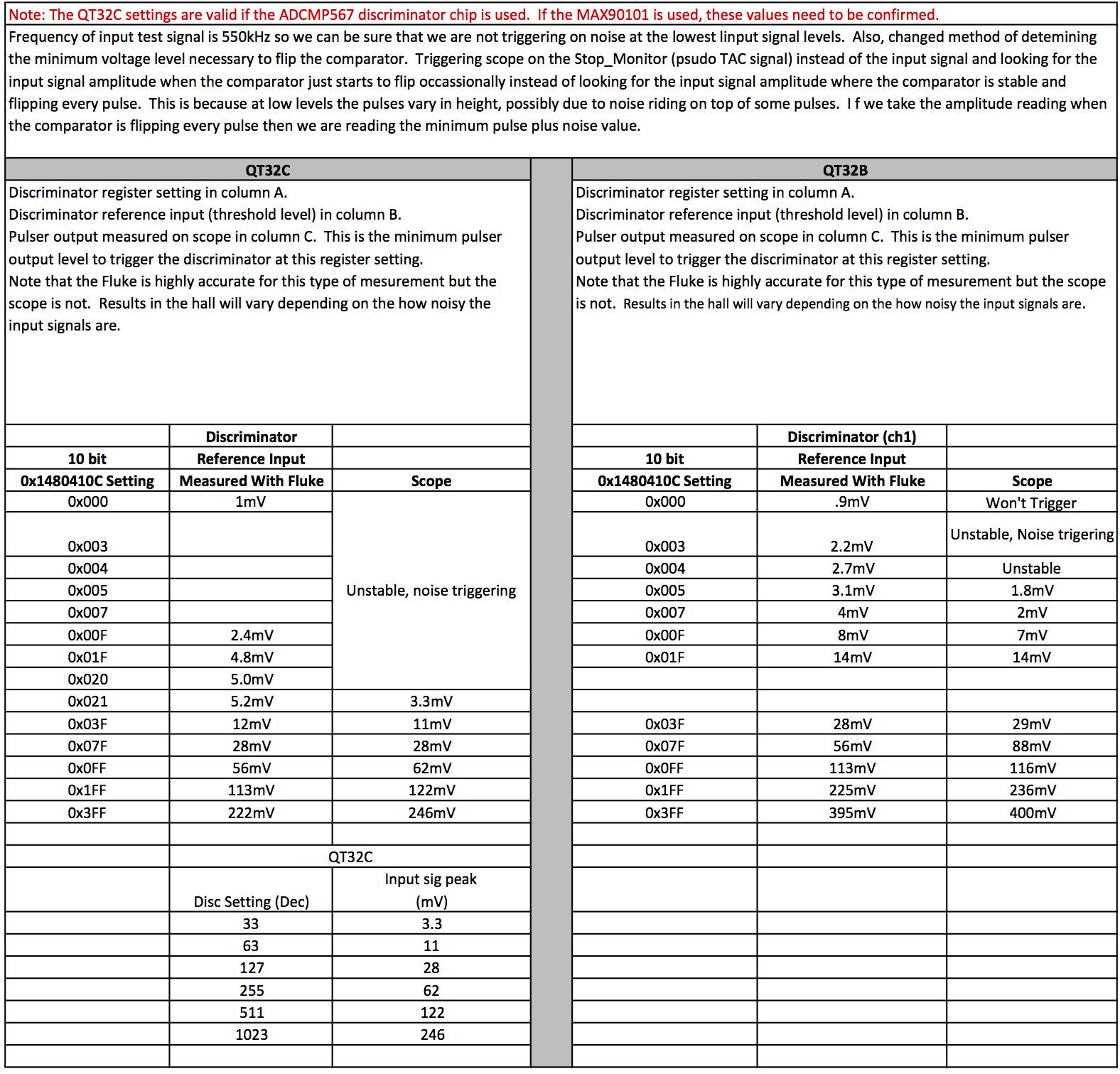
Following runs are taken
Gate values are set to best values in following runs.
| Run Number | QTB Discriminator Threshold | QTC_Discriminator_Threshold | |
| 1 | 18116044 | 16 (0x00F) = 8 mV | 64(0x03F) = 11 mV |
| 2 | 18116047 | 32 (0x01F) = 14 mV | 128(0x07F) = 28 mV |
| 3 | 18118021 | 24 (0x017) = 11 mV (linear interpolation) | 96(0x05F) = 19.5 mV (linear interpolation) |
| Phase II | |||
| 4 | |||
Here is first analysis:
drupal.star.bnl.gov/STAR/system/files/EPD_ThresholdScan_Prashanth_05012017.pdf
Timing In
Timing scan after installing QT32c board on 03/17/2017
#EPD Trigger is present in all following runs(i.e. +BBC_TAC +BBC_E + BBC_W) Timing Scan -----------
| Pre-Post | Run# | QTb Start | QTb End | QTc Start | QTc End | TAC Stop |
| Pre=2, Post=2 | 18066043 | 8 | 24 | not precent | not precent | 48 |
| Pre=2, Post=0 | 18076064 | 0 | 16 | 0 | 16 | 56 |
| Pre=0, Post=2 | 18076065 | 0 | 16 | 0 | 16 | 56 |
I have attaced the results for run above runs and run 18066043.
Run 18066043 was taken earlier for QTb STAR Delay =8 and QTb END Delay = 24 ns.
Then we did the Gate scan in 2ns. During this step we recorded only pre, post = 0,0 crossings.
From this gate scan we noticed QTb STAR Delay =0 and QTb END Delay = 16 ns is best.
From the runs 18076064 and 18076065 it seems we are in pre = 1 crossing for QT32 'b' board, i.e PP-4 even, PP-5 odd, PP-6 (even & odd)
and QT32 'c' board in trigger crossing.
Timeing seems completely messed up.
Let me thing more in the morning
Gate Scan
--------
Following runs are taken on March 19th.
In the following runs EPD Trigger is updated so we have now JP2 (i.e. +BBC_TAC +BBC_E + BBC_W + JP2)
| No | Run Number | Gate Start QT 32 b | Gate End QT 32 b | Gate Start QT 32 c | Gate End QT 32 c | TAC Stop | Data Start Address | Initial Study by Prashanth | Mike's PrePost study and Comments |
| 1 | 18078043 | 0 | 16 | 0 | 16 | 56 | c=8, b=8 | EPD_plots_18078043.pdf | PrePost=-1 1st run of the fill |
| 2 | 18078044 | 4 | 20 | 4 | 20 | 56 | c=8, b=8 | EPD_plots_18078044.pdf | PrePost=-1 |
| 3 | 18078045 | 8 | 24 | 8 | 24 | 56 | c=8, b=8 | EPD_plots_18078045.pdf | PrePost=0 |
| 4 | 18078046 | 12 | 28 | 12 | 28 | 56 | c=8, b=8 | EPD_plots_18078046.pdf | PrePost=0 |
| 5 | 18078047 | 16 | 32 | 16 | 32 | 56 | c=8, b=8 | EPD_plots_18078047.pdf | This run was stopped for beam squeeze |
| 6 | 18078048 | 16 | 32 | 16 | 32 | 56 | c=8, b=8 | EPD_plots_18078048.pdf | PrePost=0 |
| 7 | 18078049 | 20 | 36 | 20 | 36 | 56 | c=8, b=8 | EPD_plots_18078049.pdf | stopped for polarization measurements |
| 8 | 18078050 | 20 | 36 | 20 | 36 | 56 | c=8, b=8 | EPD_plots_18078050.pdf | PrePost=0 |
| 9 | 18078051 | 24 | 40 | 24 | 40 | 56 | c=8, b=8 | EPD_plots_18078051.pdf | PrePost=0 |
| 10 | 18078052 | 28 | 44 | 28 | 44 | 56 | c=8, b=8 | EPD_plots_18078052.pdf | PrePost=0 Taken By Yang Wu |
| 11 | 18078053 | 32 | 48 | 32 | 48 | 56 | c=8, b=8 | EPD_plots_18078053.pdf | PrePost=0 |
| 12 | 18078054 | 36 | 52 | 36 | 52 | 56 | c=8, b=8 | EPD_plots_18078054.pdf | PrePost=0 |
| 13 | 18078056 | 40 | 56 | 40 | 56 | 56 | c=8, b=8 | EPD_plots_18078056.pdf | PrePost probably 0 (bad stats) |
| 14 | 18078057 |
44 | 60 | 44 | 60 | 56 | c=8, b=8 | EPD_plots_18078057.pdf | PrePost probably 0 (out of gate) |
| 15 | 18078058 | 48 | 64 | 48 | 64 | 56 | c=8, b=8 | EPD_plots_18078058.pdf | PrePost=0? or 1? |
| c=8, b=8 | |||||||||
| Negative Scan | |||||||||
| 16 | 18082042 | 0 | 16 | 0 | 16 | 56 | c=8, b=8 | EPD_plots_18082042.pdf | QT32b in PrePost=-1 QT32c in PrePost=0 |
| 17 | 18082043 |
107(0) | 123(16) | 107(0) | 123(16) | 56 | c=8, b=8 | EPD_plots_18082043.pdf | QT32b in PrePost=-1 QT32c in PrePost=0 |
| 18 | 18082044 | 103(-4) | 119(12) | 103(-4) | 119(12) | 56 | c=8, b=8 | EPD_plots_18082044.pdf | QT32b in PrePost=-1 QT32c in PrePost=0 |
| 19 | 18082045 | 99(-8) | 115(8) | 99(-8) | 115(8) | 56 | c=8, b=8 | EPD_plots_18082045.pdf | QT32b in PrePost=-1 QT32c in PrePost=0 |
| 20 | 18082046 | 95(-12) | 111(4) | 95(-12) | 111(4) | 56 | c=8, b=8 | EPD_plots_18082046.pdf | QT32b in PrePost=-1 QT32c in PrePost=0 |
| 21 | 18082047 | 91(-16) | 107(0) | 91(-16) | 107(0) | 56 | c=8, b=8 | EPD_plots_18082047.pdf | QT32b in PrePost=-1 QT32c in PrePost=0 |
| 22 | 18089004 | 87(-20) | 103(-4) | 87(-20) | 103(-4) | 56 | c=8, b=8 |
EPD_plots_18089004.pdf | |
| 23 | 18089007 | 83(-24) | 99(-8) | 83(-24) | 99(-8) | 56 | c=8, b=8 |
EPD_plots_18089007.pdf | |
| 24 | 18089008 | 79(-28) | 95(-12) | 79(-28) | 95(-12) | 56 | c=8, b=8 |
EPD_plots_18089008.pdf | |
| 25 | 18089009 | 75(-32) | 91(-16) | 75(-32) | 91(-16) | 56 | c=8, b=8 |
EPD_plots_18089009.pdf | |
| 26 | 18089010 | 99(-8) | 115(8) | 99(-8) | 115(8) | 56 | c=8, b=7 |
EPD_plots_18089010.pdf | |
| 27 | 18089013 | 99(-8) | 115(8) | 99(-8) | 115(8) | 56 | c=8, b=9 |
EPD_plots_18089013.pdf | |
Overlay plot of run 18078043, 18078044, 18078045, 18078046 is available here:https://online.star.bnl.gov/epd/TimingScan/OverlayPlot.pdf
|
QT32c
Gate (STAR,STOP) = (0,16)prepost =0 Gate (STAR,STOP) = (4,20) |
vs. |
QT32b
Gate (STAR,STOP) = (0,16)Prepost=-1 Gate (STAR,STOP) = (4,20) Gate (STAR,STOP) = (8,24) Gate (STAR,STOP) = (12,28) |
Run 18090046 has new Tier1 file = trg_170329
Here is the analysis: https://online.star.bnl.gov/epd/TimingScan/EPD_plots_18090046.pdf
e-scope traces
E-Scope connections
03/24/2017
CH#1 => PP4_tile_1 (no-split, 50 ohm)
CH#3 => QT32b board 0x18 gate
Please see attaced image:PP_6_tile_1_nosplit.pdf, which shows a cosmic ray pules and QT gate.
04/03/2017
Following scope traces are acquired during beamin in RHIC.
THreshold = 8mV
CH#1 of scop to PP6 Tile 1 no split, 50 ohm termination)
CH#3 => QT32b board 0x10 gate
Please see
04/04/2017
Following scope traces are acquired during beamin in RHIC.
THreshold = 4mV
CH#1 of scop to PP6 Tile 1 no split, 50 ohm termination)
CH#3 => QT32b board 0x10 gate
Please see https://drupal.star.bnl.gov/STAR/system/files/scopetracesPP6T1_nosplit_4mV.pdf
04/04/2017
Following scope traces are acquired during beamin in RHIC.
THreshold = 4mV && persistent
CH#1 of scop to PP6 Tile 1 no split, 50 ohm termination)
CH#3 => QT32b board 0x10 gate
Please see : https://drupal.star.bnl.gov/STAR/system/files/scopetracesPP6T1_nosplit_4mV_persistent.pdf
Operations 2018
EPD Run by Run QA 2018
Isobar run by run QA: drupal.star.bnl.gov/STAR/blog/jewigleb/epd-isobar-2018-run-list
EPD racks in plat form
EPD uses 1C2 and 1C3 racks in the south platform:
Here is the drawing of the racks:
Mapping
For the current mapping file, look for "Current" in the Attached Files at the bottom of this page.
I removed some of the older versions of excel sheets, which are irrelevant for now.
Still East side has issues, un solved.
I have checked the east tile with scope and saw cosmic pulses
Pre- and post-beam commissioning
Post-installation / pre-beam commissioning- Pre-post checking, to make sure we are in same bin as BBC. DONE
- Instructions - Rosi has agreed to elaborate a bit more (mal 15feb2019)
- check by Rosi
- Verify proper mapping from TUFF to StEvent (tests databases, cabling...) ("Seven Patterns" test) DONE
- Vped adjustment DONE
- I-V scan has been done about once/day DONE
- Confirm data goes from QT32C to TCU
- this is important for TRIGGER readiness, but not for PHYSICS readiness
- Prashanth or Rosi need to write up the purpose and instructions here.
Post-beam commissioning to be ready for PHYSICS
- (Re-)confirm pre-post timing (it's easy and it's important)
- Same instructions as item #1 above.
- Same instructions as item #1 above.
- Timing scan DONE
- Bias scan DONE
SW FEE box Removal
Trigger Commissioning
EPD Trigger is very similar to BBC, except EPD uses hit count instead of ADC sum for trigger.
Trigger layers:
- 14 QTC boards with TAC, 108 TAC tiles for each east and west.
- Layer zero: EP001(east) & EP002(west) DSMs.
- Layer one: EP101 DSM.
- Layer 2: Vertex DSM
- TCU bits EPD-E, EPD-W, EPD-TAC; corresponding to number of good hits above hit count threshold and in TAC window.
Useful links:
- Trigger Algorithm document (Explains the algorithms in QTs and DSMs for triggering)
- Cheat sheet of QTs and DSMs
- EPD QT mapping (please see the excel sheet at the end)
- EPD online monitoring (Has summary plots, ADC & TAC distributions, bit map checking)
EPD trigger shows some mismatch (few percent to 20%) from QTC to L0 DSM.
Issue is more likely the Algorithm and/or output latch issues and can not be hardware issue (Many thanks to Steve and Jack fixing hardware issues).
Current Tier1 file is set to provide EPD-E, EPD-W and EPD-TAC
To test the trigger capabilities of EPD following runs are taken only with triggers: EPD-E + EPD-W + EPD-TAC
19075034 (short run)
19075035 (long run)
19075053 (during the vernier scan, very long run)
Following thresholds are used in above runs:
- 300 < TAC < 4000
- 16 < ADC
- All the QTC boards are enabled to pass
- A TAC difference is between 3895 and 4295 applied (corresponding to ~ 30 cm).
- Hit count is required to have greater than 0 for both east and west.
Following are some QA plots from run 19075035
| EPD TAC difference East vs. West | (a)Earliest TAC East, (b) Earliest TAC west, (c) TAC diff. Blue histo is calculated from QTs and Red is from EP101 So the difference between red and blue tells the bits mis-match! |
 |
 |
| Hit count from Ep101, Note that we have 108 TAC channles | Top left panel is for BBC only, rest compare BBC with EPD |
 |
 |
Applied cut is doing its job on selecting events from ~30 cm cut.
Now the issues:
EP001 and EP002 shows earliest TAC of 0x20, 0x800 and 0x820 for east and west for about 5-20% of the time for all the QTC boards.
Please following bit map check plot, plot compares mis-match from QTC algorithm against bits received by EP001/2. Bits mismatch at 0x20, 0x800 and 0x820 clearly visible.
For 19075034

This gives peak TAC difference centered around 4096 (0x800-0x800 or 0x820=0x820 or 0x20-0x20, plus 4096)
and 0x20 above and below 4096 for 0x800 and 0x820 combos.
Following plot from low statistic run 19075034

We confirmed that when there is no good hit in QT, no output is generated from QT algorithm or in EP001/2.
Current proposal is to include EPD trigger in production running with limited band with and play with QT algo latches and output latches.
Any thoughts, comments or suggestions?
What supersector, fiberbundle, FEE, and SiPM is where?
Prashanth maintains a page of the complete EPD mapping. Here, the focus is to record which supersector and fiber bundle is at what position in the 2018 run. These are unlikely to change, during the run!- You can click on the Supersector number to see ADC spectra from test stand cosmic runs. More complete information on SS health can be found on this page.
- Click on the Fiberbundle number to see results of transmission tests. More complete information on FB health can be found on this page.
- On 22 June 2018, Mike has filled in the SiPM# information based on BNL logbook page 102, which was filled between 20 Jan and 4 Feb 2018.
| Position | OSU SS # | Lehigh FB# | FEE# (odd) | FEE# (even) | SiPM# (odd) | SiPM# (even) | Comments/issues | |
|---|---|---|---|---|---|---|---|---|
| East PP01 | 21 | 13 | 04 | 47 | 13 | 59 | ||
| East PP02 | 23 | 23 | 05 | 52 | 43 | 53 | ||
| East PP03 | 20 | 20 | 11 | 46 | 47 | 57 | ||
| East PP04 | 22 | 15 | 10 | 41 | 51 | 52 | ||
| East PP05 | 14 | 05 | 14 | 21 | 19 | 06 | ||
| East PP06 | 29 | 18 | 12 | 20 | 50 | 49 | ||
| East PP07 | 25 | 08 | 44 | 42 | 02 | 11 | |
|
| East PP08 | 24 | 24 | 49 | 60 | 56 | 12 | ||
| East PP09 | 01 | 27 | 58 | 48 | 46 | 55 | ||
| East PP10 | 05 | 14 | 51 | 55 | 26 | |
SiPM#28 was bad; replaced | |
| East PP11 | 06 | 21 | 01 | 53 | ??????? | 58 | odd SiPM# not recorded | |
| East PP12 | 31 | 01 | 50 | 59 | 27 | 29 | ||
| West PP01 | 15 | 04 | 22 | 15 | 15 | 14 | ||
| West PP02 | 19 | 03 | 17 | 19 | 35 | 25 | ||
| West PP03 | 12 | 11 | 28 | 24 | 24 | 34 | ||
| West PP04 | 11 | 02 | 07 | 29 | 37 | 36 | ||
| West PP05 | 30 | 16 | 25 | 16 | 18 | 21 | ||
| West PP06 | 27 | 26 | 38 | 02 | 10 | 60 | ||
| West PP07 | 07 | 10 | 23 | 57 | 22 | 08 | ||
| West PP08 | 09 | 07 | 26 | 43 | 16 | 09 | ||
| West PP09 | 02 | 17 | 32 | 56 | 20 | 38 | |
|
| West PP10 | 04 | 09 | 27 | 30 | 33 | 05 | ||
| West PP11 | 10 | 06 | 31 | 40 | 04 | 07 | ||
| West PP12 | 03 | 19 | 45 | 37 | 23 | 03 |
Not listed in the table above (i.e. not used in run 2018):
- 12 of the 60 FEE cards produced: 03, 06, 08, 09, 13, 18, 33, 34, 35, 36, 39, 54
- #18 had been installed originally but didn't communicate. Tim has since repaired it and returned it to EPD group
- End-of-run inventory June 2018: 12 "spare" FEEs are in cabinet, but one has no label on it. All numbers except for #35 were found on the spare labels, so presumably the un-labeled spare is #35.
- So, all 60 FEEs are accounted for, at end of run 2018.
- Mike is taking four FEEs (#33,34,36,39) to Ohio for summer 2018
- 13 SiPM cards of the 60 SiPM cards produced: 01, 17, 28(bad), 30, 31, 39, 40, 41, 42, 44, 45, 48, 54
- note that one card listed in the table had no number, so presumably one of the 13 listed above is actually in the experiment.
- End-of-run inventory June 2018: 12 "spare" SiPMs accounted for, in total
- all numbers on the list above are identified, except 01, 17, 44. However, we have one in the experiment un-numbered, and two from Tim simply labeled "1" and "2" on the bag.
- Bottom line: all 60 SiPM cards are accounted for, at end of run 2018, except we have three un-numbered cards who are certainly 01,17,44, but we don't know exactly which is which. No big deal.
- Mike is taking four SiPM cards (#40, 41, 45, 48) to Ohio for summer 2018
- 7 of the 31 SS produced: 08, 13, 16, 17, 18, 26, 28
- already discussed on this page
Here is a handy map to help reproduce the fiber placement in run 2019. A high-resolution PDF file is here: drupal.star.bnl.gov/STAR/system/files/Setup2018.pdf
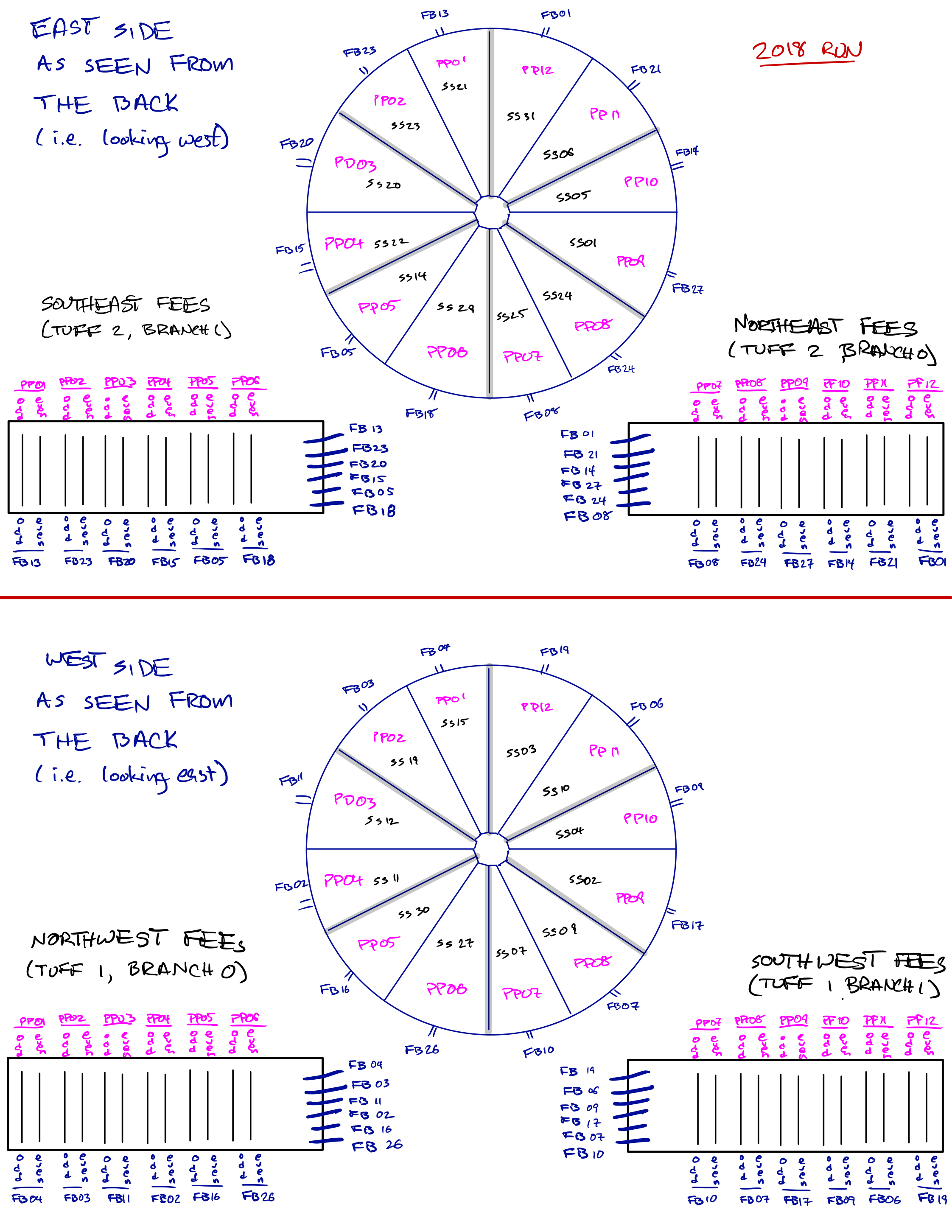
Operations 2019
Escope traces
Here are some scope traces took on Feb 26, 2019, with beam:
.png)
.png)
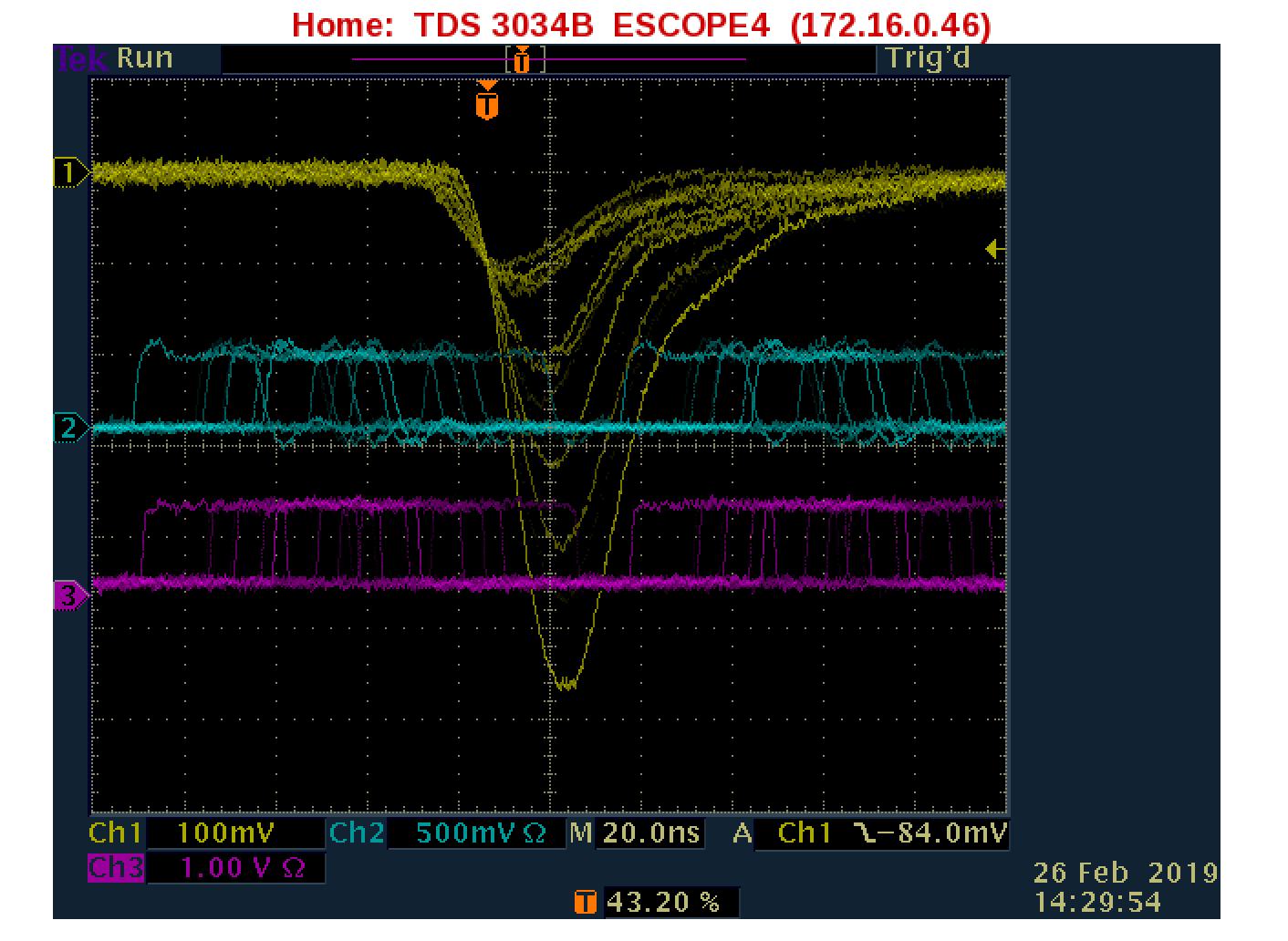
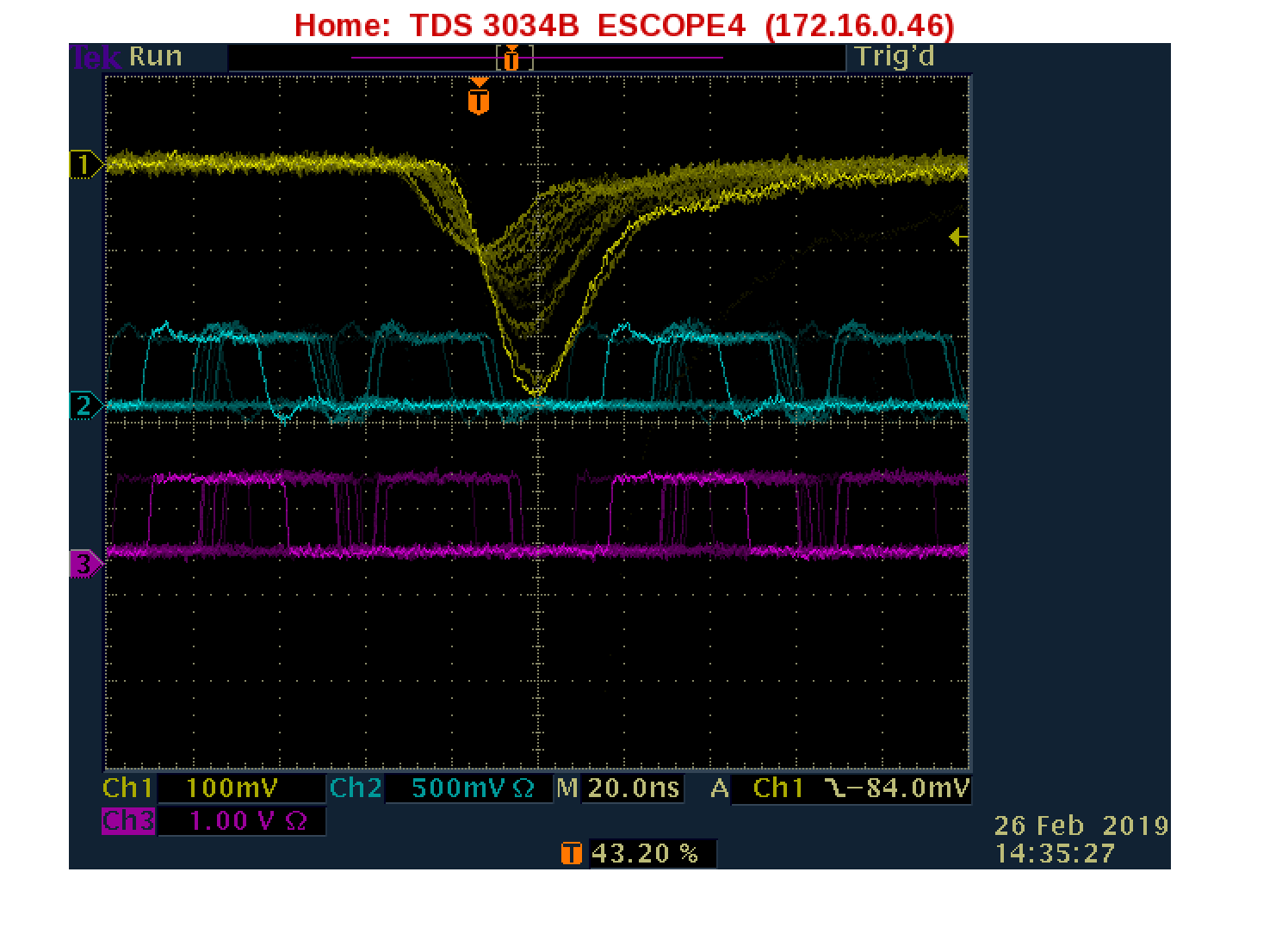
Post-installation / pre-beam commissioning 2019
1. Verify proper mapping from TUFF to StEvent (tests databases, cabling...) ("Seven Patterns" test) - DONE
We followed the instructions listed at: drupal.star.bnl.gov/STAR/subsys/epd/operations-2018/pre-and-post-beam-commissioning
2. Vped adjustment - DONE
The instructions written for this year can be found at: drupal.star.bnl.gov/STAR/blog/rjreed/epd-vped-scans-2019
3. Verifying fiber mapping/pre-post
In 2018 we verified the pre-post by running special runs. It was noted this year that if we are in the right bunch crossing, we should see the epd-bbc correlation. If not, then we will not.
In progress: *.daq files have been requested from HPSS and restored to NFS. Then the bfc.C has been run, creating pico/MuDsts. These need to be analyzed.
EPD Timing Scan 2019
Nominal Values for 2018 were
B Gate End = 48
B Gate Start = 32
C Gate End = 39
C Gate Start = 23
TAC Stop = 64
Operations 2024
Pre-beam commissioning
- Installation and light-tight test of the EPD April 2024 - blog by Rosi
- Seven Patterns mapping test - done by Maria
- Vped scan - done by Maria and Mike 16 April 2024 - blog by Mike
- FEE temperatures as a function of position in the box - correlated to dark current? - blog by Mike
- Visual map of mapping - includes instructions for shift crew
With-beam commissioning
- Timing scan- done by Maria and Mike 27 April 2024 - blog by Mike
- Bias scan- done by Maria and Mike 27-28 April 2024 - blog by Mike
- TAC offset adjustment - done by Mike 28-29 April 2024 - blog by Mike
Transition to Au+Au running - Oct 2024:
- Quick-and-dirty timing scan - done by Maria and Mike 6 Oct 2024 - blog by Mike
- TAC offset adjustment - done by Mike 7 Oct 2024 - blog by Mike
Issues for this run
Software
EPD software
- Analysis software (StEpdMaker): See the "child page" (listed at the bottom of this page) or click here
- For database documentation, go to this page.
- For simulations software (EPD in GSTAR) go to this page
Offline analysis package - StEpd and StEpdMaker
A compact software framework has been written to support offline data analysis of EPD data. It includes interface to online raw data (mostly useful for experts during the run) on an online node, muDst-based analysis at RCF/PDSF, and picoDst-based analysis on your own laptop.
The code is CVS-managed in STAR. At the moment, you may obtain it via
cvs co offline/users/lisa/StRoot/StEpdMaker
A complete Users Guide and Reference Manual (Rev 1.2) has been written - get it here. It describes the detector and data; tells you how to obtain, build and use the library; and provides examples.
Start-of-run EPD tasks and instructions
At the beginning of every run, there are a number of things that need to be done for the EPD.After the EPD is installed, and before beam, you need to:
- Check mapping from "TUFF space" to "StEvent space"
- Check connector orientations
- Check that you're in the right pre-post
- Compare dark currents to before the shut down
- Re-confirm pre-post (same as above)
- Do timing scan (this needs to be done for physics to be declared!)
- My instructions (note: you need to prepare for this in advance!)
- Do bias voltage scan (this can be done after physics is declared)
Useful EPD documents
This page collects the most important "free-standing" documents for the Event Plane Detector.
Hardware documents
This page is to organize hardware-related documents and pages.| Logbook | links |
|---|---|
| OSU Supersector Construction Logbook (2017) | online google doc (do not edit!) / pdf file (printout of google doc) / .docx file |
| EPD BNL Logbook (2016-2018) | 01-40, 42-49, 51-96, 97-123 |
| OSU Supersector Testing Logbook (2017) | 01-49, 50-99, 100-149, 150-159, 160, 161-174 |
At the bottom of this page are "child pages" related to
- complete bench tests of supersectors done at Ohio State University and Brookhaven Lab
- complete bench tests of fiber bundles done at Lehigh University
- complete bench tests of FEEs, SiPMs, and Rx cards done at University of Science and Technology of China (USTC)
Always useful: a very explicit set of pictures showing the mapping between WLS fiber ends and the tile number is at drupal.star.bnl.gov/STAR/system/files/TileFiberMapping_0.pdf
Here is the logbook used for Supersector testing at Ohio State 30 June - 16 Oct 2017
- pages 1-49: drupal.star.bnl.gov/STAR/system/files/EPD%20SS%20testing%20pp%201-49_0.pdf
- pages 50-99: drupal.star.bnl.gov/STAR/system/files/EPD%20SS%20testing%20pp%2050-99_0.pdf
- pages 100-149: drupal.star.bnl.gov/STAR/system/files/EPD%20SS%20testing%20pp%20100-149_0.pdf
- pages 150-159: drupal.star.bnl.gov/STAR/system/files/EPD%20SS%20testing%20pp%20150-160.pdf
- page 160: drupal.star.bnl.gov/STAR/system/files/EPD%20SS%20testing%20-%20page%20160.pdf
- pages 161-174: drupal.star.bnl.gov/STAR/system/files/EPD%20SS%20testing%20pp%20161-174.pdf
Here is the supersector construction logbook from OSU in summer 2017 - PLEASE BE CAREFUL! I don't seem to be able to make this read-only. You should put the setting (upper right) to "viewing" to protect against unintended changes.
- Just to be safe, here is a pdf printout of that logbook: drupal.star.bnl.gov/STAR/system/files/OsuSupersectorConstructionLogbook.pdf
Clear Fiber Bundle Health/Status
A summary of all of the testing results of the Clear Fiber bundles since the start.Criteria for passing (somewhat arbitrary, but based on results from the 3 bundles used in Run 17 that were deemed "good"):
- Average transmission of above -65%
- No single fiber in a bundle has transmission below -75%
Bundles to use in Run 18:
| FB# | Status | Comments | Average | Max | Full Sheet |
| 1 | Healthy | First bundle; repolished twice | -63% | -68% | FB01 |
| 2 | Healthy | Results from 2nd test; avg unchanged from first test | -55% | -62% | FB02 |
| 3 | Healthy | -54% | -67% | FB03 | |
| 4 | Healthy | -63% | -73% | FB04 | |
| 5 | Healthy | -62% | -71% | FB05 | |
| 6 | Healthy | Repolished once | -62% | -68% | FB06 |
| 7 | Healthy | -61% | -73% | FB07 | |
| 8 | Healthy | Repolished 3 times | -63% | -72% | FB08 |
| 9 | Healthy | -64% | -71% | FB09 | |
| 10 | Healthy | -62% | -68% | FB10 | |
| 11 | Healthy | -62% | -73% | FB11 | |
| 13 | Healthy | Repolished 3 times | -64.8% | -73% | FB13 |
| 14 | Healthy | -62% | -73% | FB14 | |
| 15 | Healthy | -62% | -73% | FB15 | |
| 16 | Healthy | -62% | -73% | FB16 | |
| 17 | Healthy | -63% | -70% | FB17 | |
| 18 | Healthy | -61% | -69% | FB18 | |
| 19 | Healthy | -63% | -68% | FB19 | |
| 20 | Healthy | Repolished twice | -64% | -69% | FB20 |
| 21 | Healthy | -64% | -72% | FB21 | |
| 23 | Healthy | Repolished once | -63% | -72% | FB23 |
| 24 | Healthy | -63% | -74.6% | FB24 | |
| 26 | Healthy | -62% | -66% | FB26 | |
| 27 | Healthy | -57% | -68% | FB27 |
Failing Bundles that can still be used in Run 18 in an emergency:
| FB# | Status | Comments | Average | Max | Full Sheet |
| 22 | Injured | Failing upon retest. Not sure what's going on | -61% | -77% | FB22 |
| 12 | Injured | Single fiber glows on both ends, possibly cracked | N/A | N/A | N/A |
| 28 | Injured | Failing final test. Also even/odd difference of 6% | -61% | -78% | FB28 |
Bundle Under Construction: FB25 (Broken splitter; construction not completed, but can be fixed and polished for the future if needed)
In summary, at the moment we have:
- 24 Passing Bundles (FB1-FB11, FB13-FB21, FB23-FB24, FB26-FB27)
- 3 Failing Bundles (FB28 has a fiber at -78%; FB12 has a fiber glowing on either end, so it was set aside. Has never been fully tested, but the glowing fiber was actually passing testing; FB22 failing upon retest; 2 fibers below -75%)
- 1 Incomplete bundle (FB25 had a tube splitter that broke. It can be fixed, polished and used, but of course should only be used as a last resort)
Google Spreadsheets for posterity:
Fiber by Fiber testing of every bundle: https://docs.google.com/spreadsheets/d/1rs-XOkZjJQz_nzMzTgH1vVVI4Ck12OCSJ_Dc_WHTaK8/edit#gid=0
Fiber Bundle Status Summary: https://docs.google.com/spreadsheets/d/1u5dWDUeguvjiPTBiH32b--NCzr-gS7l-ocCTeo5hBF0/edit#gid=0
FEE, SiPM, RX board Health Status
USTC has done a fantastic job of collecting and systematically posting their QA and characterization tests here. They cover
- FEE boards
- SiPM cards
- Receiver cards
Supersector and Tile Health/Status
This page records the health status of the 31 Supersectors. (Well, SS28 was dropped, so there are only 30, but we keep the numbering.)Results of cosmic tests at OSU in Aug-Sept 2017 (4 SS in a stack), and BNL in Nov 2017 - Jan 2018 (3 SS in a stack).
The health sheets may be found here. (Also see "how to read a health sheet".)
| SS | status | comments | ADC spectra |
| 1 | healthy | hey, our much-maligned "first pancake" actually looks great! | 160131 |
| 2 | healthy | 020304 | |
| 3 | healthy | 020304 | |
| 4 | healthy | a bit less light than some others, but it worked well in run 2017 | 020304 |
| 5 | healthy | (taking another look at TT26 jan2018, to be sure, but it's fine) | 08050607 |
| 6 | healthy | (taking another look at TT26 jan2018, to be sure, but it's fine) | 08050607 |
| 7 | healthy | 08181007 | |
| 8 | injured | TT05 very low gain, probably unusable | 14081516 |
| 9 | healthy | TT03 has low gain | 06091417 |
| 10 | healthy | 08181007 | |
| 11 | healthy | 09111213 | |
| 12 | healthy | ADC spectra in test looked a little strange | 09111213 |
| 13 | injured | MAY be usable. X-talk b/t TT01,03; glued WLS fibers | 09111213 |
| 14 | healthy | 06091417 | |
| 15 | healthy | ADC spectrum for TT20 a little strange; see notes | 14081516 |
| 16 | injured | TT02 has very low gain. Had suspected paint on fiber end, but problem persists after cleaning | 161731 |
| 17 | prob. healthy | Joey should comment on X-talk issue; see health sheet | 161731 |
| 18 | injured | TT03 broke during construction. low gain. PERHAPS viable | 08181007 |
| 19 | healthy | 17181920 | |
| 20 | healthy | 17181920 | |
| 21 | healthy | TT21 ADC distribution a bit abnormal | 212930 |
| 22 | healthy | 21222426 | |
| 23 | healthy | 252723 | |
| 24 | healthy | 21222426 | |
| 25 | healthy | 252723 | |
| 26 | healthy enough |
TT03 has rather low gain, but probably usable. I'm comfortable with this in the experiment. | 21222426 |
| 27 | healthy | see notes for comments on TT24,25,27-31 | 252723 |
| 28 | dead | dropped and broken in pieces :-( | |
| 29 | healthy | TT27 has low gain | 212930 |
| 30 | healthy | 212930 | |
| 31 | healthy | 161731 |
According to this table we have
- 24 healthy (1-7, 9-12, 14, 15, 19-25, 27, 29-31) We'll use these in Run 2018.
- 2 healthy "enough" to use in experiment (17, 26)
- 4 injured: if we need to swap in, take them in the following order
- SS16 has low-gain TT02, but maybe usable. Take this first if needed.
- SS08 and SS18 each have one tile with low gain that are likely unusable.
- SS13 has cross-talk in small tiles due to glued WLS fibers. May be usable
- 1 dead (SS28). Don't use this one.
Useful Links
Semi-Expert Page:
https://dashboard1.star.bnl.gov/daq/DCS_UI/
Wanbing's New Control/Monitoring page:
dashboard1.star.bnl.gov/daq/EPD_UI/
EPD Online Monitor: (ADC histograms, etc):
https://online.star.bnl.gov/epd/
Very useful visual map of the tile-to-electronics mapping:
https://drupal.star.bnl.gov/STAR/blog/lisa/How-check-and-visualize-EPD-mapping-tile-QT-channel
Rosi's blog on "Running the EPD remotely" (how to bring up VME crate interface etc):
https://drupal.star.bnl.gov/STAR/blog/rjreed/Running-EPD-Remotely
HyperNews Forum:
http://www.star.bnl.gov/HyperNews-star//protected/get/epd.html
Weekly meeting agenda and documents:
drupal.star.bnl.gov/STAR/subsys/epd/epd-meetings-0
STAR Operations homepage (including meeting agendas and bluejeans link)
drupal.star.bnl.gov/STAR/public/operations
Not-anymore-useful links (but kept for historical reasons):
Rahul's official shut-down schedule 2017/18
drupal.star.bnl.gov/STAR/blog/rsharma/star-shutdown-schedule
OLD Shift Crew Page: (old GUI)
https://dashboard1.star.bnl.gov/daq/dcs_control/next.html?EPD
Materials list for EPD construction (not updated)
drupal.star.bnl.gov/STAR/blog/lisa/epd-materials
EPD Time In
Attaced (ScopeTraces_beforeTimeIn.pdf) is scope traces before timing in, taken during beam in RHIC